 | –≠–ª–µ–∫—Ç—Ä–æ–Ω–Ω—ã–π –∫–æ–º–ø–æ–Ω–µ–Ω—Ç: VDP31XXB | –°–∫–∞—á–∞—Ç—å:  PDF PDF  ZIP ZIP |

VDP 31xxB
Video Processor Family
Edition Sept. 25, 1998
6251-437-2PD
PRELIMINARY DATA SHEET
MICRONAS
MICRONAS

PRELIMINARY DATA SHEET
VDP 31xxB
2
Micronas
Contents
Page
Section
Title
5
1.
Introduction
6
1.1.
VDP Applications
7
2.
Functional Description
7
2.1.
Analog Front-End
7
2.1.1.
Input Selector
7
2.1.2.
Clamping
7
2.1.3.
Automatic Gain Control
7
2.1.4.
Analog-to-Digital Converters
7
2.1.5.
ADC Range
7
2.1.6.
Digitally Controlled Clock Oscillator
7
2.1.7.
Analog Video Output
9
2.2.
Adaptive Comb Filter
10
2.3.
Color Decoder
10
2.3.1.
IF-Compensation
11
2.3.2.
Demodulator
11
2.3.3.
Chrominance Filter
11
2.3.4.
Frequency Demodulator
11
2.3.5.
Burst Detection
11
2.3.6.
Color Killer Operation
11
2.3.7.
PAL Compensation /1-H Comb Filter
12
2.3.8.
Luminance Notch Filter
12
2.3.9.
Skew Filtering
13
2.4.
Horizontal Scaler
13
2.5.
Black-Line Detector
13
2.6.
Test Pattern Generator
14
2.7.
Video Sync Processing
15
2.8.
Display Part
15
2.8.1.
Luma Contrast Adjustment
15
2.8.2.
Black Level Expander
16
2.8.3.
Dynamic Peaking
17
2.8.4.
Digital Brightness Adjustment
17
2.8.5.
Soft Limiter
17
2.8.6.
Chroma Input
17
2.8.7.
Chroma Interpolation
18
2.8.8.
Chroma Transient Improvement
18
2.8.9.
Inverse Matrix
18
2.8.10.
RGB Processing
18
2.8.11.
OSD Color Lookup Table
19
2.8.12.
Picture Frame Generator
19
2.8.13.
Priority Codec
19
2.8.14.
Scan Velocity Modulation
19
2.8.15.
Display Phase Shifter

PRELIMINARY DATA SHEET
VDP 31xxB
3
Micronas
Contents, continued
Page
Section
Title
21
2.9.
Analog Back End
21
2.9.1.
CRT Measurement and Control
22
2.9.2.
SCART Output Signal
23
2.9.3.
Average Beam Current Limiter
23
2.9.4.
Analog RGB Insertion
24
2.9.5.
Fast Blank Monitor
24
2.9.6.
Half Contrast Control
24
2.10.
IO Port Expander
26
2.11.
Synchronization and Deflection
26
2.11.1.
Deflection Processing
26
2.11.2.
Horizontal Phase Adjustment
28
2.11.3.
Vertical and East/West Deflection
28
2.11.4.
Protection Circuitry
29
2.12.
Reset Function
29
2.13.
Standby and Power-On
30
3.
Serial Interface
30
3.1.
I
2
C-Bus Interface
30
3.2.
Control and Status Registers
43
3.2.1.
Scaler Adjustment
46
3.2.2.
Calculation of Vertical and East-West Deflection Coefficients
47
4.
Specifications
47
4.1.
Outline Dimensions
47
4.2.
Pin Connections and Short Descriptions
49
4.3.
Pin Descriptions
51
4.4.
Pin Configuration
52
4.5.
Pin Circuits
54
4.6.
Electrical Characteristics
54
4.6.1.
Absolute Maximum Ratings
54
4.6.2.
Recommended Operating Conditions
54
4.6.3.
Recommended Crystal Characteristics
55
4.6.4.
Characteristics
56
4.6.4.1.
5 MHz Clock Output
56
4.6.4.2.
20 MHz Clock Input/Output, External Clock Input (XTAL1)
56
4.6.4.3.
Reset Input, Test Input
57
4.6.4.4.
I
2
C-Bus Interface
57
4.6.4.5.
IO Port Expander
57
4.6.4.6.
Analog Video Inputs
58
4.6.4.7.
Analog Front-End and ADCs
59
4.6.4.8.
Picture Bus Input
60
4.6.4.9.
INTLC, Front Sync Output
60
4.6.4.10.
Main Sync Output
60
4.6.4.11.
Combined Sync Output

VDP 31xxB
PRELIMINARY DATA SHEET
4
Micronas
Contents, continued
Page
Section
Title
61
4.6.4.12.
Horizontal Flyback Input
61
4.6.4.13.
Horizontal Drive Output
61
4.6.4.14.
Vertical Protection Input
61
4.6.4.15.
Vertical Safety Input
62
4.6.4.16.
Vertical and East/West Drive Output
62
4.6.4.17.
Sense A/D Converter Input
62
4.6.4.18.
Analog RGB and FB Inputs
63
4.6.4.19.
Half Contrast Switch Input
64
4.6.4.20.
Analog RGB Outputs, D/A Converters
66
4.6.4.21.
DAC Reference, Beam Current Safety
66
4.6.4.22.
Scan Velocity Modulation Output
67
5.
Application Circuit
72
6.
Data Sheet History

PRELIMINARY DATA SHEET
VDP 31xxB
5
Micronas
Video, Display, and Deflection Processor
Release Notes: This data sheet describes functions
and characteristics of the VDP 31xxB≠C2. Revision
bars indicate significant changes to the previous
edition.
1. Introduction
The VDP 31xxB is a Video IC family of high-quality
single-chip video processors. Modular design and a
submicron technology allow the economic integration of
features in all classes of TV sets. The VDP 31xxB family
is based on functional blocks contained in the two chips:
VPC 3200A Video Processor and DDP 3300A Display
and Deflection Processor.
Each member of the family contains the entire video,
display, and deflection processing for 4:3 and 16:9
50/60 TV sets. Its performance and flexibility allow the
user to standardize his product development. Hardware
and software applications can profit from the modularity,
as well as manufacturing, systems support, or mainte-
nance. An overview of the VDP 31xxB video processor
family is shown in Fig. 1≠1.
2H adapt. Comb
Scan V
el.
Mod.
n
n
VDP 31xxB
1H Combfilter
n
n
VDP 3104B
VDP 3108B
VDP 3112B
VDP 3116B
VDP 3120B
Horizontal Scaler
Color T
rans.
Impr
.
n
n
n
n
n
n
n
n
n
n
n
n
RGB Insertion
n
n
n
n
n
T
ube Control
n
n
n
n
n
Prog. RGB Matrix
n
n
n
n
Family
n
Fig. 1≠1: VDP 31xxB family overview
n
VIN2
VIN3
RGB OUT
20.25
MHz
Color
Decoder
Horizontal
Scaler
Sync & Deflection
Clock Gen.
DCO
NTSC,
PAL,
SECAM
AGC,
2*8bit ADC
VIN1
VIN4
Analog
Frontend
Display
Processor
I
2
C
VOUT
I
2
C
Fig. 1≠2: Block diagram of the VDP 3120B
Analog
Backend
RGB Matrix,
CLUT,
Scan Veloc.
3*10bit DAC,
Tube Control,
RGB Switch
Measurement
ADC
H/V/EW
RGB/FB IN1
SVM
Sense
2H
Adaptive
Combfilter
RGB/FB IN2
Panorama
Mode
Color Bus
XREF
Half Contrast
VRT
CIN
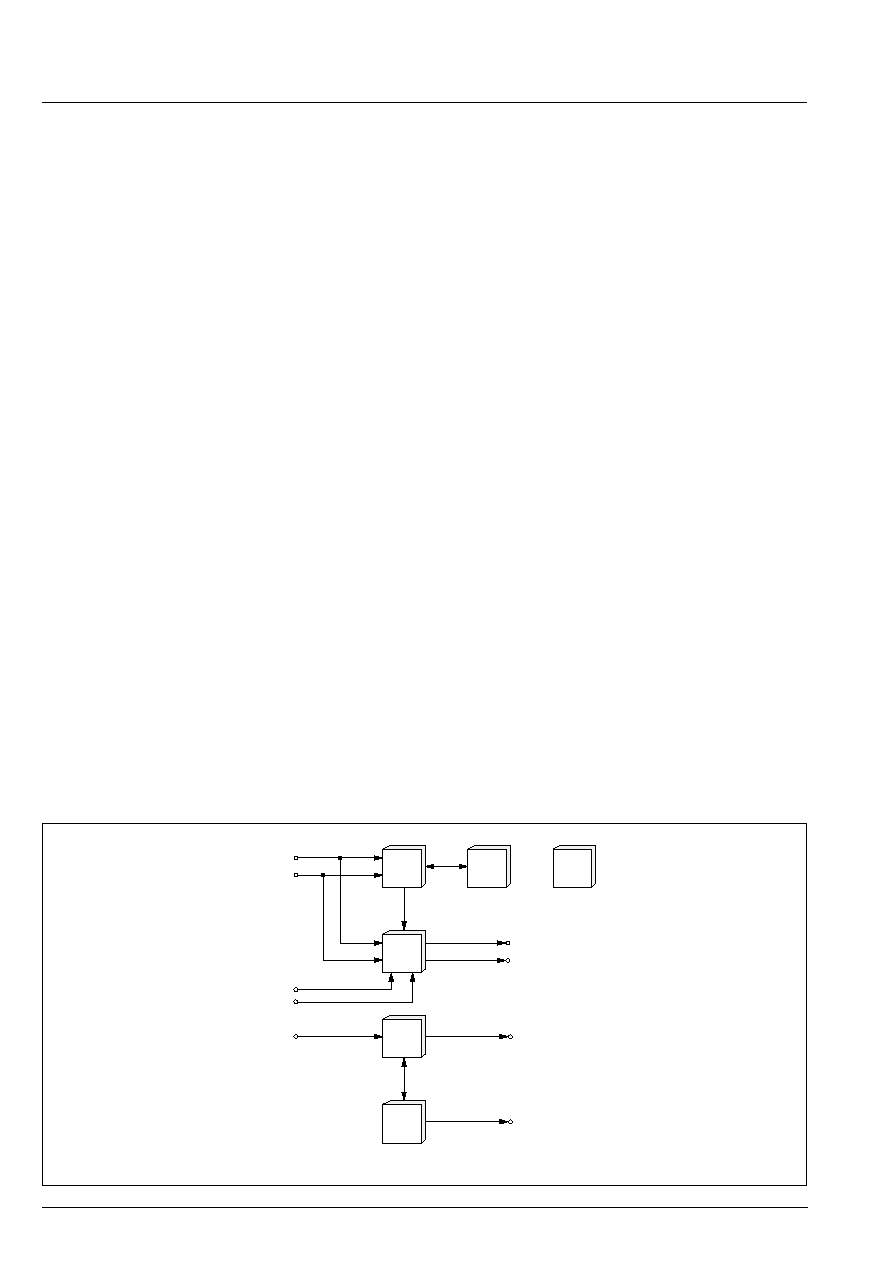
VDP 31xxB
PRELIMINARY DATA SHEET
6
Micronas
1.1. VDP Applications
As a member of the VDP 31xxB family, the VDP 3120B
offers all video features necessary to design a state-of-
the-art TV set:
Video Decoding
≠ 4 composite inputs, 1 S-VHS input
≠ composite video & sync output
≠ integrated high-quality A/D converters
≠ adaptive 2H comb filter Y/C separator
≠ 1H NTSC comb filter
≠ multistandard color decoder (1 crystal)
≠ multistandard sync decoder
≠ black line detector
Video Processing
≠ horizontal scaling (0.25 to 4)
≠ panorama vision
≠ black level expander
≠ dynamic peaking
≠ soft limiter (gamma correction)
≠ color transient improvement
RGB Processing
≠ programmable RGB matrix
≠ digital color bus interface
≠ additional analog RGB / fast blank input
≠ half-contrast switch
≠ picture frame generator
Deflection
≠ scan velocity modulation output
≠ high-performance H/V deflection
≠ separate ADC for tube measurements
≠ EHT compensation
Miscellaneous
≠ one 20.25 MHz crystal, few external components
≠ embedded RISC controller (80 MIPS)
≠ I
2
C-Bus Interface
≠ single 5 V power supply
≠ submicron CMOS technology
≠ 64-pin PSDIP package
Fig. 1≠3: Full-feature TV set with VDP 3120B
RGB
VDP
3120B
Video 2
H/VDefl.
RGB 1
TPU
3040
MSP
3410
3 x Stereo
DRAM
CCU
300x
Video 1
Audio
DPL
3420
Dolby Surround
RGB 2

PRELIMINARY DATA SHEET
VDP 31xxB
7
Micronas
2. Functional Description
2.1. Analog Front-End
This block provides the analog interfaces to all video in-
puts and mainly carries out analog-to digital conversion
for the following digital video processing. A block dia-
gram is given in Fig. 2≠1.
Most of the functional blocks in the front-end are digitally
controlled (clamping, AGC, and clock-DCO). The con-
trol loops are closed by the Fast Processor (`FP') em-
bedded in the decoder.
2.1.1. Input Selector
Up to five analog inputs can be connected. Four inputs
are for input of composite video or S-VHS luma signal.
These inputs are clamped to the sync back porch and
are amplified by a variable gain amplifier. One input is
for connection of S-VHS carrier-chrominance signal.
This input is internally biased and has a fixed gain ampli-
fier.
2.1.2. Clamping
The composite video input signals are AC coupled to the
IC. The clamping voltage is stored on the coupling ca-
pacitors and is generated by digitally controlled current
sources. The clamping level is the back porch of the vid-
eo signal. S-VHS chroma is also AC coupled. The input
pin is internally biased to the center of the ADC input
range.
2.1.3. Automatic Gain Control
A digitally working automatic gain control adjusts the
magnitude of the selected baseband by +6/≠4.5 dB in 64
logarithmic steps to the optimal range of the ADC. The
gain of the video input stage including the ADC is 213
steps/V with the AGC set to 0 dB.
2.1.4. Analog-to-Digital Converters
Two ADCs are provided to digitize the input signals.
Each converter runs with 20.25 MHz and has 8 bit reso-
lution. An integrated bandgap circuit generates the re-
quired reference voltages for the converters.
2.1.5. ADC Range
The ADC input range for the various input signals and
the digital representation is given in Table 2≠1 and Fig.
2≠2. The corresponding output signal levels of the
VDP 31xxB are also shown.
2.1.6. Digitally Controlled Clock Oscillator
The clock generation is also a part of the analog front
end. The crystal oscillator is controlled digitally by the
control processor; the clock frequency can be adjusted
within
±
150 ppm.
2.1.7. Analog Video Output
The input signal of the Luma ADC is available at the ana-
log video output pin. The signal at this pin must be buff-
ered by a source follower. The output voltage is 2 V, thus
the signal can be used to drive a 75
W
line. The magni-
tude is adjusted with an AGC in 8 steps together with the
main AGC.
DVCO
±
150
ppm
input mux
clamp
bias
frequency
20.25 MHz
gain
ADC
AGC
reference
generation
ADC
VIN3
+6/≠4.5 dB
Fig. 2≠1: Analog front-end
VIN2
VIN1
CIN
digital Chroma
digital CVBS or Luma
system clocks
CVBS/Y
CVBS/Y
CVBS/Y/C
Chroma
Analog Video
Output
3
VIN4
CVBS/Y

VDP 31xxB
PRELIMINARY DATA SHEET
8
Micronas
Table 2≠1: ADC input range for PAL input signal and corresponding signal ranges
Signal
Input Level [mV
pp
]
ADC
Range
YC
r
C
b
Internal
Range
≠6 dB
0 dB
+
4.5 dB
[steps]
[steps]
CVBS
100% CVBS
667
1333
2238
252
≠
75% CVBS
500
1000
1679
213
≠
video (luma)
350
700
1175
149
224
sync height
150
300
504
64
≠
clamp level
68
16
Chroma
burst
300
64
≠
100% Chroma
890
190
128
±
112
75% Chroma
670
143
128
±
84
bias level
128
128
255
192
128
0
black
white
217
video = 100 IRE
sync = 41 IRE
ÕÕÕÕÕÕÕÕÕ
ÕÕÕÕÕÕÕÕÕ
ÕÕÕÕÕÕÕÕÕ
68
32
192
128
228
ÕÕÕÕÕÕÕÕ
ÕÕÕÕÕÕÕÕ
80
32
ÕÕÕÕÕÕÕÕ
ÕÕÕÕÕÕÕÕ
upper headroom = 38 steps = 1.4 dB = 25 IRE
lower headroom = 4 steps = 0.2 dB
headroom = 56 steps = 2.1 dB
= clamp
level
CVBS/Y
Chroma
75% Chroma
100% Chroma
burst
Fig. 2≠2: ADC ranges for CVBS/Luma and Chroma, PAL input signal
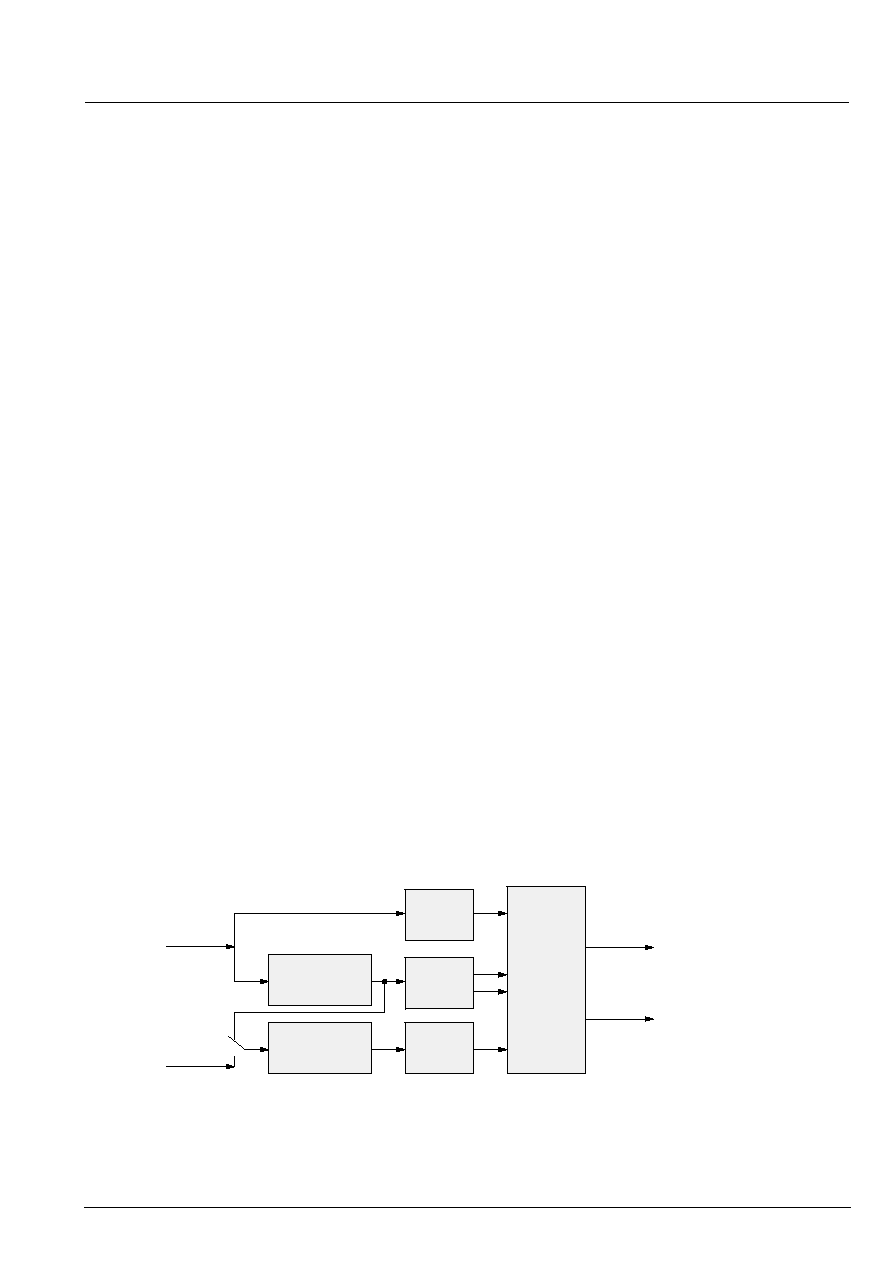
PRELIMINARY DATA SHEET
VDP 31xxB
9
Micronas
2.2. Adaptive Comb Filter
The adaptive comb filter is used for high-quality lumi-
nance/chrominance separation for PAL or NTSC sig-
nals. The comb filter improves the luminance resolution
(bandwidth) and reduces interferences like cross-lumi-
nance and cross-color artifacts. The adaptive algorithm
can eliminate most of the mentioned errors without
introducing new artifacts or noise.
A block diagram of the comb filter is shown in Fig. 2≠3.
The filter uses two line delays to process the information
of three adjacent video lines. To have a fixed phase rela-
tionship of the color subcarrier in the three channels, the
system clock (20.25 MHz) is fractionally locked to the
color subcarrier. This allows the processing of all color
standards and substandards using a single crystal fre-
quency.
The CVBS signal in the three channels is filtered at the
subcarrier frequency by a set of bandpass / notch filters.
The output of the three channels is used by the adaption
logic to select the weighting that is used to reconstruct
the luminance/chrominance signal from the 4 bandpass/
notch filter signals. By using soft mixing of the 4 signals
switching artifacts of the adaption algorithm are com-
pletely suppressed.
The comb filter uses the middle line as reference, there-
fore, the comb filter delay is one line. If the comb filter is
switched off, the delay lines are used to pass the luma/
chroma signals from the A/D converters to the luma/
chroma outputs. Thus, the comb filter delay is always
one line.
Various parameters of the comb filter are adjustable,
hence giving to the user the ability to adjust his own de-
sired picture quality.
Two parameters (KY, KC) set the global gain of luma and
chroma comb separately; these values directly weigh
the adaption algorithm output. In this way, it is possible
to obtain a luma/chroma separation ranging from stan-
dard notch/bandpass to full comb decoding.
The parameter KB allows to choose between the two
proposed comb booster modes. This so-called feature
widely improves vertical high to low frequency transi-
tions areas, the typical example being a multiburst to dc
change. For KB=0, this improvement is kept moderate,
whereas, in case of KB=1, it is maximum, but the risk to
increase the "hanging dots" amount for some given color
transitions is higher.
Using the default setting, the comb filter has separate
luma and chroma decision algorithms; it is however pos-
sible to switch the chroma comb factor to the current
luma adaption output by setting CC to 1.
Another interesting feature is the programmable limita-
tion of the luma comb amount; proper limitation,
associated to adequate luma peaking, gives rise to an
enhanced 2-D resolution homogeneity. This limitation is
set by the parameter CLIM, ranging from 0 (no limitation)
to 31 (max. limitation).
The DAA parameter (1:off , 0:on) is used to disable/en-
able a very efficient built-in "rain effect" suppressor;
many comb filters show this side effect which gives
some vertical correlation to a 2-D uniform random area,
due to the vertical filtering. This unnatural-looking phe-
nomenon is mostly visible on tuner images, since they
are always corrupted by some noise; and this looks like
rain.
1 H Line Delay
1 H Line Delay
CVBS Input
Chroma Input
Bandpass
Filter
Bandpass
Filter
Bandpass/
Notch
Filter
Luma / Chroma Mixers
Adaption Logic
Luma Output
Chroma Output
Fig. 2≠3: Block diagram of the adaptive comb filter
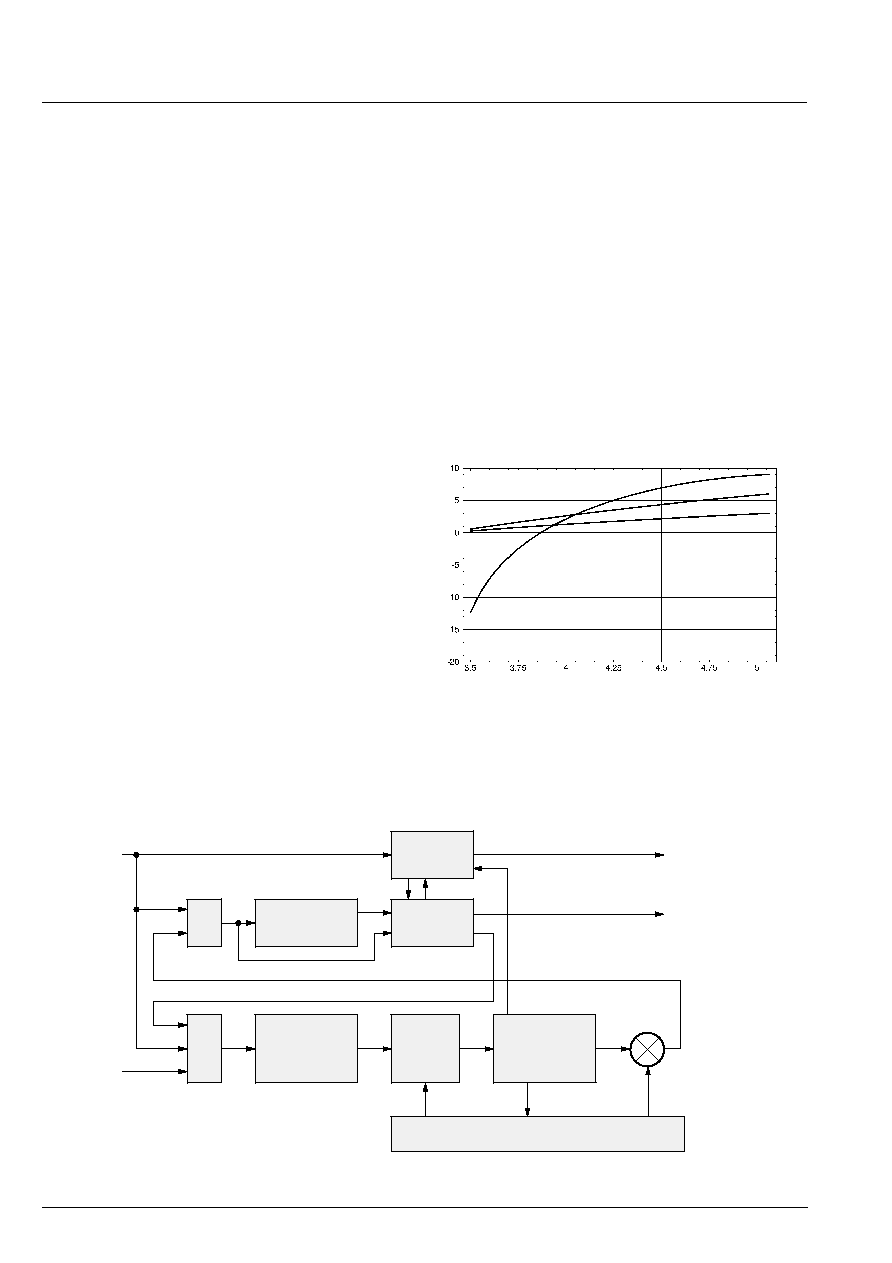
VDP 31xxB
PRELIMINARY DATA SHEET
10
Micronas
2.3. Color Decoder
In this block, the standard luma/chroma separation and
multi-standard color demodulation is carried out. The
color demodulation uses an asynchronous clock, thus
allowing a unified architecture for all color standards.
A block diagram of the color decoder is shown in Fig.
2≠5. The luma as well as the chroma processing, is
shown here. The color decoder provides also some spe-
cial modes, e.g. wide band chroma format which is in-
tended for S-VHS wide bandwidth chroma.
If the adaptive comb filter is used for luma chroma sepa-
ration, the color decoder uses the S-VHS mode proces-
sing. The output of the color decoder is YC
r
C
b
in a 4:2:2
format.
2.3.1. IF-Compensation
With off-air or mistuned reception, any attenuation at
higher frequencies or asymmetry around the color sub-
carrier is compensated. Four different settings of the IF-
compensation are possible:
≠ flat (no compensation)
≠ 6 dB /octave
≠ 12 dB /octave
≠ 10 dB/MHz
The last setting gives a very large boost to high frequen-
cies. It is provided for SECAM signals that are decoded
using a SAW filter specified originally for the PAL stan-
dard.
Fig. 2≠4: Frequency response of chroma
IF-compensation
Chroma
IF Compensation
DC-Reject
MIXER
Lowpass Filter
Phase/Freq
ACC
Color-PLL / Color-ACC
1 H Delay
MUX
MUX
Cross-Switch
Notch
Filter
Demodulator
Luma / CVBS
Luma
Fig. 2≠5: Color decoder
Chroma / C
r
C
b
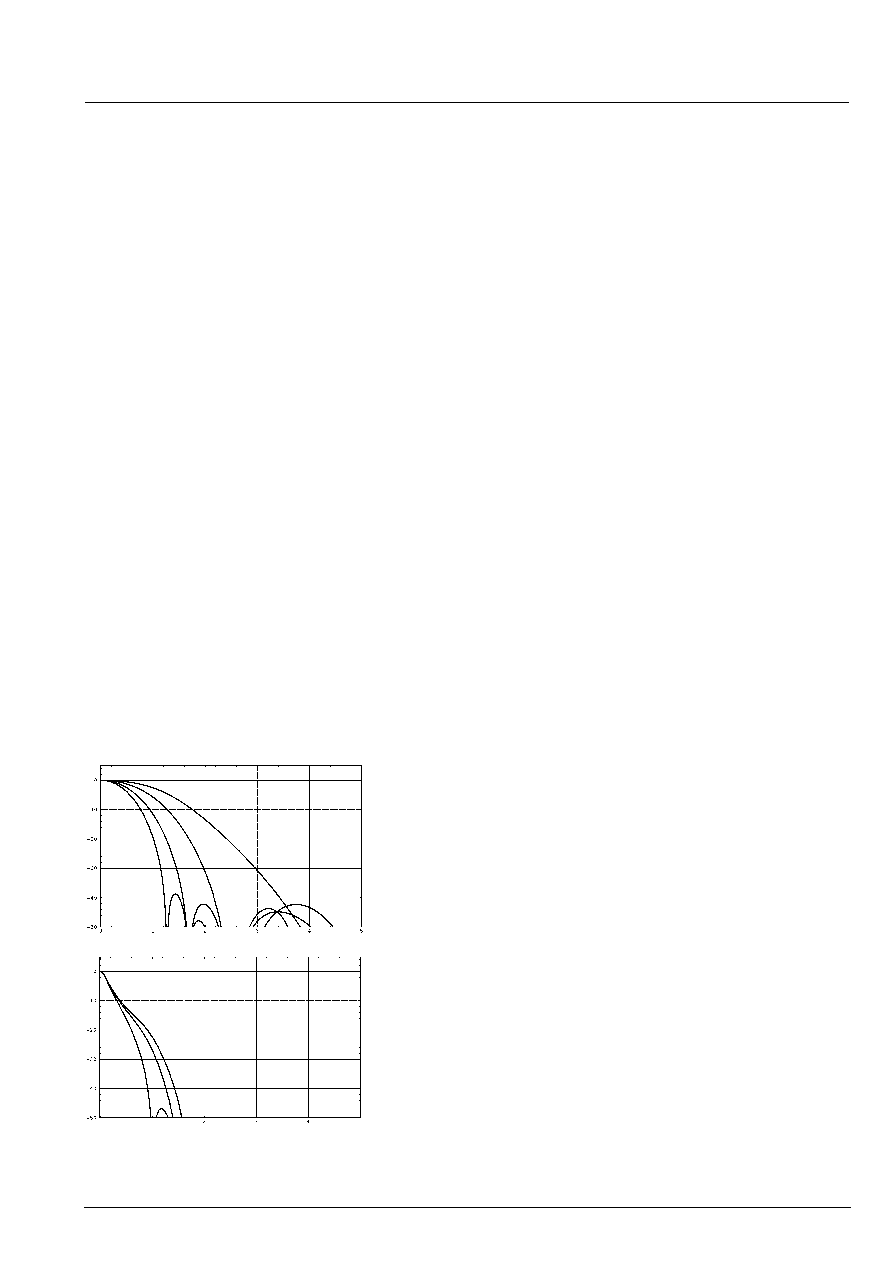
PRELIMINARY DATA SHEET
VDP 31xxB
11
Micronas
2.3.2. Demodulator
The entire signal (which might still contain luma) is now
quadrature-mixed to the baseband. The mixing frequen-
cy is equal to the subcarrier for PAL and NTSC, thus
achieving the chroma demodulation. For SECAM, the
mixing frequency is 4.286 MHz giving the quadrature
baseband components of the FM modulated chroma.
After the mixer, a lowpass filter selects the chroma com-
ponents; a downsampling stage converts the color dif-
ference signals to a multiplexed half rate data stream.
The subcarrier frequency in the demodulator is gener-
ated by direct digital synthesis; therefore, substandards
such as PAL 3.58 or NTSC 4.43 can also be demodu-
lated.
2.3.3. Chrominance Filter
The demodulation is followed by a lowpass filter for the
color difference signals for PAL/NTSC. SECAM requires
a modified lowpass function with bell-filter characteristic.
At the output of the lowpass filter, all luma information is
eliminated.
The lowpass filters are calculated in time multiplex for
the two color signals. Three bandwidth settings (narrow,
normal, broad) are available for each standard. For PAL/
NTSC, a wide band chroma filter can be selected. This
filter is intended for high bandwidth chroma signals, e.g.
a nonstandard wide bandwidth S-VHS signal.
Fig. 2≠6: Frequency response of chroma filters
PAL/NTSC
SECAM
2.3.4. Frequency Demodulator
The frequency demodulator for demodulating the SE-
CAM signal is implemented as a CORDIC-structure. It
calculates the phase and magnitude of the quadrature
components by coordinate rotation.
The phase output of the CORDIC processor is differen-
tiated to obtain the demodulated frequency. After the
deemphasis filter, the Dr and Db signals are scaled to
standard C
r
C
b
amplitudes and fed to the crossover-
switch.
2.3.5. Burst Detection
In the PAL/NTSC-system the burst is the reference for
the color signal. The phase and magnitude outputs of
the CORDIC are gated with the color key and used for
controlling the phase-lock-loop (APC) of the demodula-
tor and the automatic color control (ACC) in PAL/NTSC.
The ACC has a control range of +30 ... ≠6 dB.
For SECAM decoding, the frequency of the burst is mea-
sured. Thus, the current chroma carrier frequency can
be identified and is used to control the SECAM proces-
sing. The burst measurements also control the color kill-
er operation; they can be used for automatic standard
detection as well.
2.3.6. Color Killer Operation
The color killer uses the burst-phase / burst-frequency
measurement to identify a PAL/NTSC or SECAM color
signal. For PAL/NTSC, the color is switched off (killed)
as long as the color subcarrier PLL is not locked. For SE-
CAM, the killer is controlled by the toggle of the burst fre-
quency. The burst amplitude measurement is used to
switch-off the color if the burst amplitude is below a pro-
grammable threshold. Thus, color will be killed for very
noisy signals. The color amplitude killer has a program-
mable hysteresis.
2.3.7. PAL Compensation / 1-H Comb Filter
The color decoder uses one fully integrated delay line.
Only active video is stored.
The delay line application depends on the color stan-
dard:
≠ NTSC:
1-H comb filter or color compensation
≠ PAL:
color compensation
≠ SECAM: crossover-switch
In the NTSC compensated mode, Fig. 2≠7 c), the color
signal is averaged for two adjacent lines. Thus, cross-
color distortion and chroma noise is reduced. In the
NTSC combfilter mode, Fig. 2≠7 d), the delay line is in
the composite signal path, thus allowing reduction of
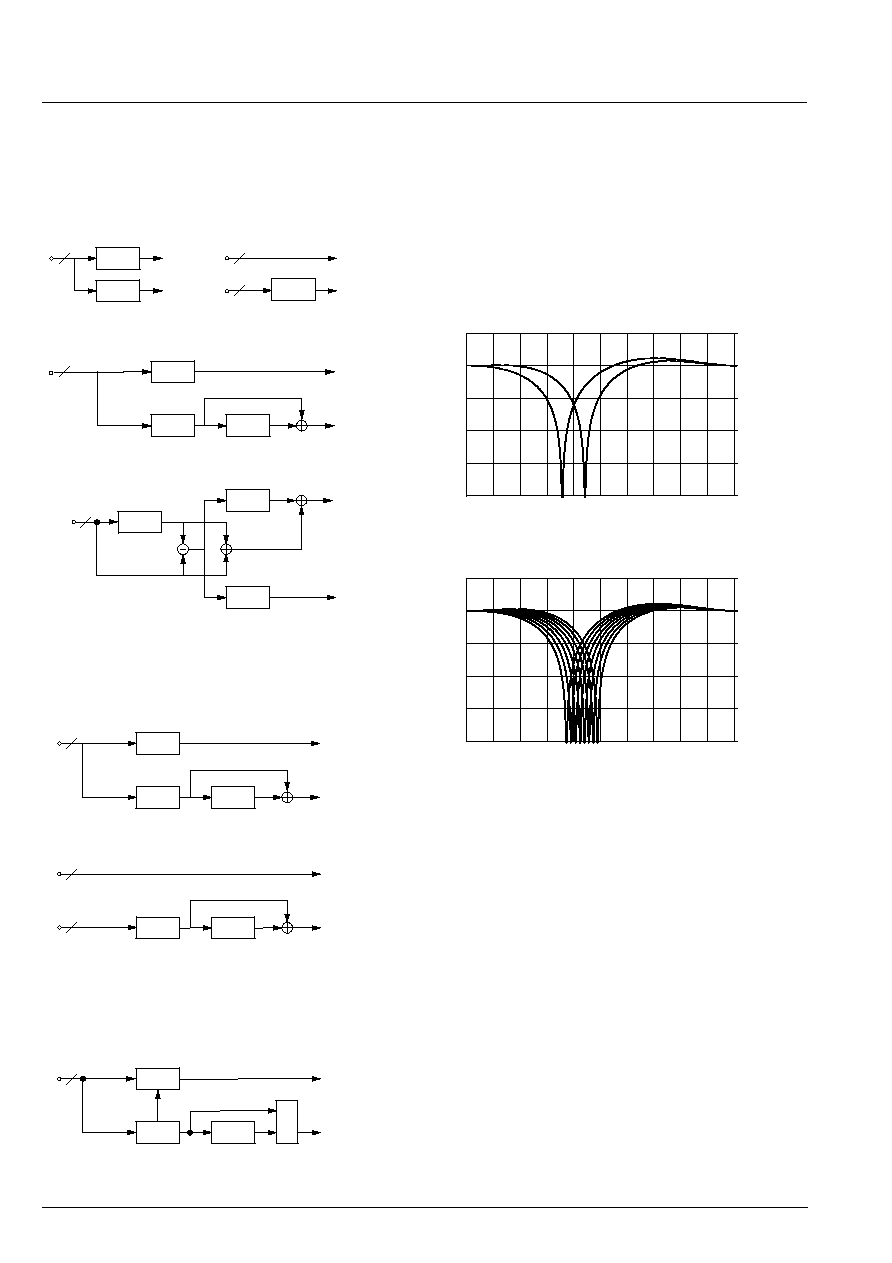
VDP 31xxB
PRELIMINARY DATA SHEET
12
Micronas
cross-color components, as well as cross-luminance.
The loss of vertical resolution in the luminance channel
is compensated by adding the vertical detail signal with
removed color information.
Chroma
Notch
filter
8
Chroma
Process.
CVBS
Y
1 H
Delay
8
CVBS
Chroma
Process.
Notch
filter
Y
8
Chroma
Process.
Luma
Y
8
a) conventional
b) S-VHS
d) comb filter
Fig. 2≠7: NTSC color decoding options
C C
r b
C C
r b
C C
r b
Notch
filter
1 H
Delay
8
Chroma
Process.
CVBS
Y
c) compensated
C C
r b
Chroma
Notch
filter
1 H
Delay
8
Chroma
Process.
CVBS
Y
8
Chroma
Process.
Luma
Y
8
1 H
Delay
a) conventional
b) S-VHS
Fig. 2≠8: PAL color decoding options
C C
r b
C C
r b
MUX
Notch
filter
1 H
Delay
8
Chroma
Process.
CVBS
Y
Fig. 2≠9: SECAM color decoding
C C
r b
2.3.8. Luminance Notch Filter
If a composite video signal is applied, the color informa-
tion is suppressed by a programmable notch filter. The
position of the filter center frequency depends on the
subcarrier frequency for PAL/NTSC. For SECAM, the
notch is directly controlled by the chroma carrier fre-
quency. This considerably reduces the cross-lumi-
nance. The frequency responses for all three systems
are shown in Fig. 2≠10.
PAL/NTSC notch filter
dB
MHz
10
0
2
4
6
8
10
0
≠10
≠20
≠30
≠40
dB
MHz
10
0
2
4
6
8
10
0
≠10
≠20
≠30
≠40
Fig. 2≠10: Frequency responses of the luma
notch filter for PAL, NTSC, and SECAM
SECAM notch filter
2.3.9. Skew Filtering
The system clock is free-running and not locked to the
TV line frequency. Therefore, the ADC sampling pattern
is not orthogonal. The decoded YC
r
C
b
signals are con-
verted to an orthogonal sampling raster by the skew fil-
ters, which are part of the scaler block.
The skew filters allow the application of a group delay to
the input signals without introducing waveform or fre-
quency response distortion.
The amount of phase shift of this filter is controlled by the
horizontal PLL1. The accuracy of the filters is 1/32
clocks for luminance and 1/4 clocks for chroma. Thus
the 4:2:2 YC
r
C
b
data is in an orthogonal pixel format
even in the case of nonstandard input signals such as
VCR.
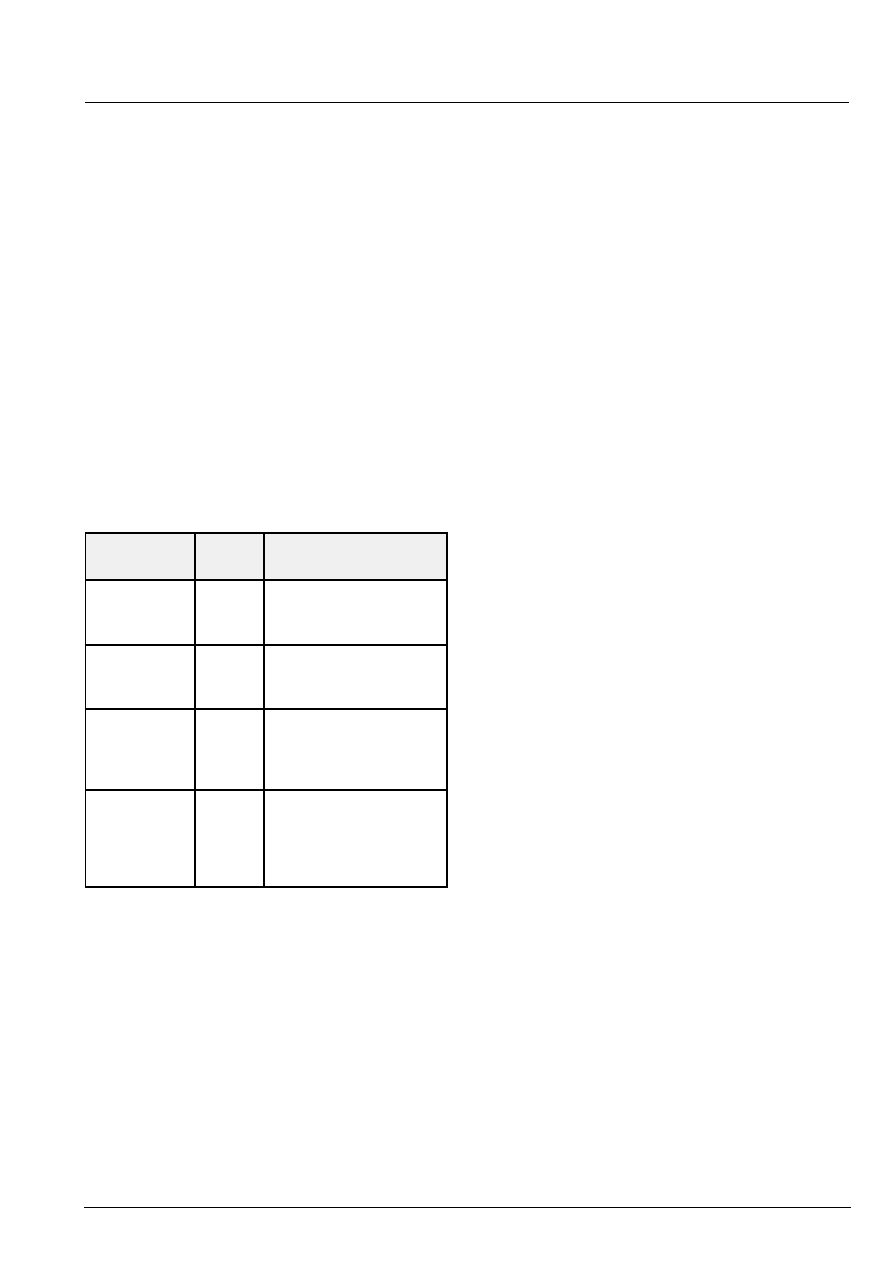
PRELIMINARY DATA SHEET
VDP 31xxB
13
Micronas
2.4. Horizontal Scaler
The 4:2:2 YCrCb signal from the color decoder is pro-
cessed by the horizontal scaler. The scaler block allows
a linear or nonlinear horizontal scaling of the input video
signal in the range of 0.25 to 4. Nonlinear scaling, also
called "panorama vision", provides a geometrical distor-
tion of the input picture. It is used to fit a picture with 4:3
format on a 16:9 screen by stretching the picture geome-
try at the borders. Also, the inverse effect can be pro-
duced by the scaler. A summary of scaler modes is given
in Table 2≠2.
The scaler contains a programmable decimation filter, a
1-line FIFO memory, and a programmable interpolation
filter. The scaler input filter is also used for pixel skew
correction, see 2.3.9. The decimator/interpolator struc-
ture allows optimal use of the FIFO memory. The con-
trolling of the scaler is done by the internal Fast Proces-
sor.
Table 2≠2: Scaler modes
Mode
Scale
Factor
Description
Compression
4:3
16:9
0.75
linear
4:3 source displayed on a
16:9 tube,
with side panels
Panorama
4:3
16:9
non-
linear
compr
4:3 source displayed on a
16:9 tube,
Borders distorted
Zoom
4:3
4:3
1.33
linear
Letterbox source (PAL+)
displayed on a 4:3 tube,
vertical overscan with
cropping of side panels
Panorama
4:3
4:3
non-
linear
zoom
Letterbox source (PAL+)
displayed on a 4:3 tube,
vertical overscan, bor-
ders distorted, no crop-
ping
2.5. Black-Line Detector
In case of a letterbox format input video, e.g. Cinema-
scope, PAL+ etc., black areas at the upper and lower
part of the picture are visible. It is suitable to remove or
reduce these areas by a vertical zoom and/or shift op-
eration.
The VDP 31xxB supports this feature by a letterbox de-
tector. The circuitry detects black video lines by measur-
ing the signal amplitude during active video. For every
field the number of black lines at the upper and lower
part of the picture are measured, compared to the pre-
vious measurement and the minima are stored in the
I
2
C-register BLKLIN. To adjust the picture amplitude, the
external controller reads this register, calculates the ver-
tical scaling coefficient and transfers the new settings,
e.g. vertical sawtooth parameters, horizontal scaling co-
efficient etc., to the VDP.
Letterbox signals containing logos on the left or right
side of the black areas are processed as black lines,
while subtitles, inserted in the black areas, are pro-
cessed as non-black lines. Therefore the subtitles are
visible on the screen. To suppress the subtitles, the verti-
cal zoom coefficient is calculated by selecting the larger
number of black lines only. Dark video scenes with a low
contrast level compared to the letterbox area are indi-
cated by the BLKPIC bit.
2.6. Test Pattern Generator
The YCrCb outputs of the front-end can be switched to
a test mode where YCrCb data are generated digitally
in the VDP 31xxB. Test patterns include luma/chroma
ramps, flat fields and a pseudo color bar pattern.

VDP 31xxB
PRELIMINARY DATA SHEET
14
Micronas
2.7. Video Sync Processing
Fig. 2≠11 shows a block diagram of the front-end sync
processing. To extract the sync information from the
video signal, a linear phase lowpass filter eliminates all
noise and video contents above 1 MHz. The sync is sep-
arated by a slicer; the sync phase is measured. A vari-
able window can be selected to improve the noise immu-
nity of the slicer. The phase comparator measures the
falling edge of sync, as well as the integrated sync pulse.
The sync phase error is filtered by a phase-locked loop
that is computed by the FP. All timing in the front-end is
derived from a counter that is part of this PLL, and it thus
counts synchronously to the video signal.
A separate hardware block measures the signal back
porch and also allows gathering the maximum/minimum
of the video signal. This information is processed by the
FP and used for gain control and clamping.
For vertical sync separation, the sliced video signal is in-
tegrated. The FP uses the integrator value to derive ver-
tical sync and field information.
The information extracted by the video sync processing
is multiplexed onto the hardware front sync signal (FSY)
and is distributed to the rest of the video processing sys-
tem. The format of the front sync signal is given in
Fig. 2≠12.
The data for the vertical deflection, the sawtooth, and the
East-West correction signal is calculated by the
VDP 31xxB. The data is buffered in a FIFO and trans-
ferred to the back-end by a single wire interface.
Frequency and phase characteristics of the analog vid-
eo signal are derived from PLL1. The results are fed to
the scaler unit for data interpolation and orthogonaliza-
tion and to the clock synthesizer for line-locked clock
generation. Horizontal and vertical syncs are latched
with the line-locked clock.
phase
comparator
&
lowpass
counter
front-end
timing
front sync
lowpass
1 MHz
&
syncslicer
horizontal
sync
separation
vertical
sync
separation
FIFO
Sawtooth
video
input
skew
front
sync
generator
vertical
serial
data
vertical
sawtooth
E/W
Parabola
Calculation
clamping, colorkey, FIFO_write
PLL1
clamp &
signal
meas.
Fig. 2≠11: Sync separation block diagram
vblank
field
clock
synthesizer
syncs
clock
H/V syncs
F1
(not in scale)
input
analog
video
FSY
F1
Parity
V: vertical sync
0 = off
1 = on
F: field #
0 = field 1
1 = field 2
Fig. 2≠12: Front sync format
F0
skew
skew
LSB
not
used
F
V
F0 reserved
MSB
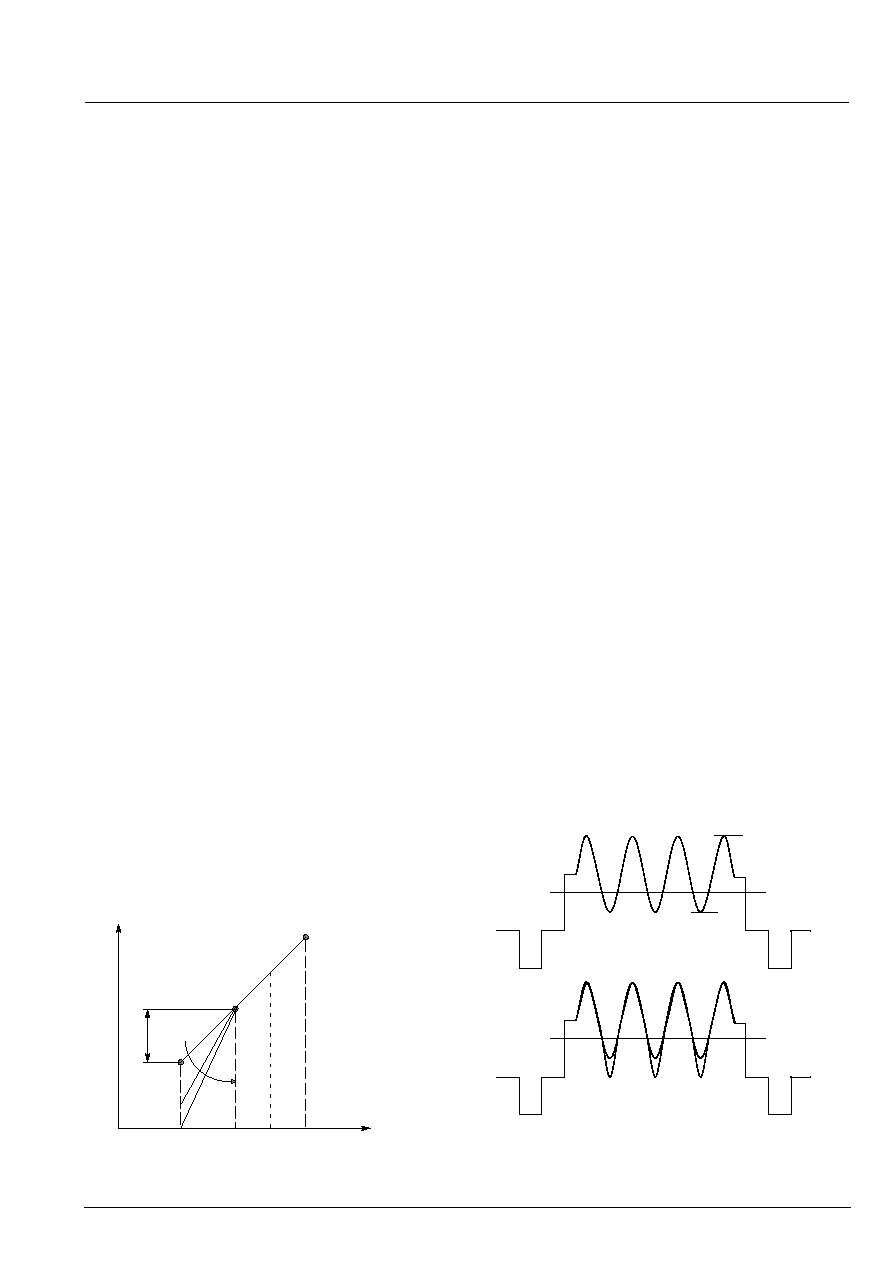
PRELIMINARY DATA SHEET
VDP 31xxB
15
Micronas
2.8. Display Part
In the display part the conversion from digital YC
r
C
b
to
analog RGB is carried out. A block diagram is shown in
Figure 2≠20. In the luminance processing path, contrast
and brightness adjustments and a variety of features,
such as black level expansion, dynamic peaking and
soft limiting, are provided. In the chrominance path, the
C
r
C
b
signals are converted to 20.25 MHz sampling rate
and filtered by a color transient improvement circuit. The
YC
r
C
b
signals are converted by a programmable matrix
to RGB color space.
The display processor provides separate control set-
tings for two pictures, i.e. different coefficients for a
`main' and a `side' picture.
The digital OSD insertion circuit allows the insertion of
a 5-bit OSD signal. The color space for this signal is con-
trolled by a partially programmable color look-up table
(CLUT) and contrast adjustment.
The OSD signals and the display clock are synchronized
to the horizontal flyback. For the display clock, a gate
delay phase shifter is used. In the analog backend, three
10-bit digital-to-analog converters provide the analog
output signals.
2.8.1. Luma Contrast Adjustment
The contrast of the luminance signal can be adjusted by
multiplication with a 6-bit contrast value. The contrast
value corresponds to a gain factor from 0 to 2, where the
value 32 is equivalent to a gain of 1. The contrast can be
adjusted separately for main picture and side picture.
L
in
L
out
L
min
L
max
L
t
L
tr
Fig. 2≠13: Characteristics of the black level expander
L
tr
BAM
BTHR
BTLT
2.8.2. Black Level Expander
The black level expander enhances the contrast of the
picture. Therefore the luminance signal is modified with
an adjustable, non-linear function. Dark areas of the pic-
ture are changed to black, while bright areas remain un-
changed. The advantage of this black level expander is
that the black expansion is performed only if it will be
most noticeable to the viewer.
The black level expander works adaptively. Depending
on the measured amplitudes `L
min
' and `L
max
' of the low-
pass-filtered luminance and an adjustable coefficient
BTLT, a tilt point `L
t
' is established by
L
t
= L
min
+ BTLT (L
max
≠ L
min
).
Above this value there is no expansion, while all lumi-
nance values below this point are expanded according
to:
L
out
= L
in
+ BAM
(L
in
≠ L
t
)
A second threshold, L
tr
, can be programmed, above
which there is no expansion. The characteristics of the
black level expander are shown in Fig. 2≠13 and Fig.
2≠14.
The tilt point L
t
is a function of the dynamic range of the
video signal. Thus, the black level expansion is only per-
formed when the video signal has a large dynamic
range. Otherwise, the expansion to black is zero. This al-
lows the correction of the characteristics of the picture
tube.
a)
L
min
L
max
L
t
L
t
b)
Fig. 2≠14: Black-level-expansion
a) luminance input
b) luminance input and output

PRELIMINARY DATA SHEET
VDP 31xxB
16
Micronas
2.8.3. Dynamic Peaking
Especially with decoded composite signals and notch fil-
ter luminance separation, as input signals, it is neces-
sary to improve the luminance frequency characteris-
tics. With transparent, high-bandwidth signals, it is
sometimes desirable to soften the image.
In the VDP 31xxB, the luma response is improved by `dy-
namic' peaking. The algorithm has been optimized re-
garding step and frequency response. It adapts to the
amplitude of the high frequency part. Small AC ampli-
tudes are processed, while large AC amplitudes stay
nearly unmodified.
The dynamic range can be adjusted from
*
14 to
)
14 dB for small high frequency signals. There is sepa-
rate adjustment for signal overshoot and for signal un-
dershoot. For large signals, the dynamic range is limited
by a non-linear function that does not create any visible
alias components. The peaking can be switched over to
"softening" by inverting the peaking term by software.
The center frequency of the peaking filter is switchable
from 2.5 MHz to 3.2 MHz. For S-VHS and for notch filter
color decoding, the total system frequency responses
for both PAL and NTSC are shown in figure 2≠16.
Transients, produced by the dynamic peaking when
switching video source signals, can be suppressed via
the priority bus.
Fig. 2≠15: Dynamic peaking frequency response
dB
MHz
20
5
≠5
≠10
≠15
≠20
0
2
4
6
8
10
15
10
0
dB
MHz
20
5
≠5
≠10
≠15
≠20
0
2
4
6
8
10
15
10
0
dB
MHz
20
5
≠5
≠10
≠15
≠20
0
2
4
6
8
10
15
10
0
CF= 3.2 MHz
CF= 2.5 MHz
S-VHS
dB
MHz
20
5
≠5
≠10
≠15
≠20
0
2
4
6
8
10
15
10
0
dB
MHz
20
5
≠5
≠10
≠15
≠20
0
2
4
6
8
10
15
10
0
CF= 3.2 MHz
CF= 2.5 MHz
PAL/SECAM
dB
MHz
20
5
≠5
≠10
≠15
≠20
0
2
4
6
8
10
15
10
0
dB
MHz
20
5
≠5
≠10
≠15
≠20
0
2
4
6
8
10
15
10
0
CF= 2.5 MHz
CF= 3.2 MHz
Fig. 2≠16: Total frequency response for peaking filter and S-VHS, PAL, NTSC
NTSC
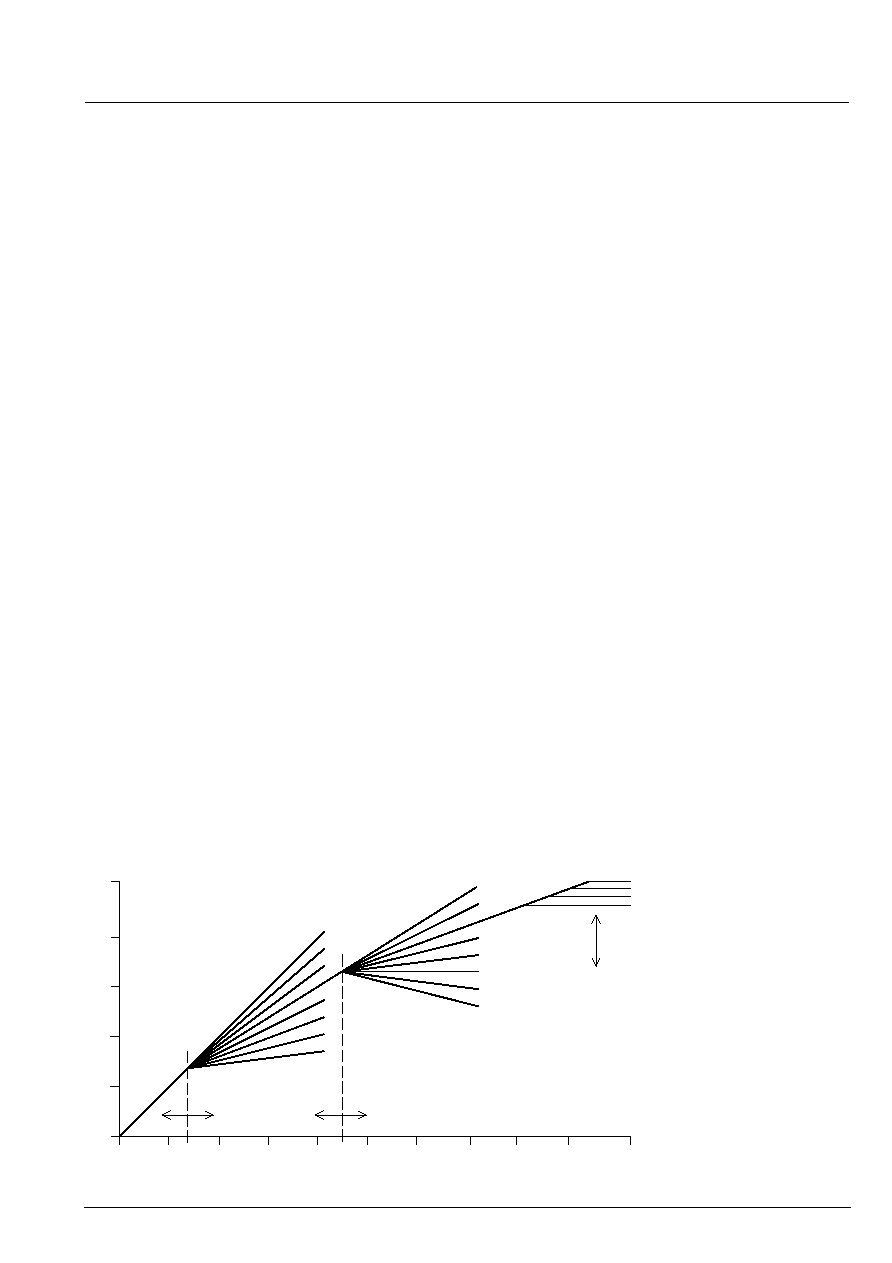
PRELIMINARY DATA SHEET
VDP 31xxB
17
Micronas
2.8.4. Digital Brightness Adjustment
The DC-level of the luminance signal can be adjusted by
adding an 8-bit number in the luminance signal path in
front of the softlimiter.
With a contrast adjustment of 32 (gain
+
1) the signal can
be shifted by
"
100%. After the brightness addition, the
negative going signals are limited to zero. It is desirable
to keep a small positive offset with the signal to prevent
undershoots produced by the peaking from being cut.
The digital brightness adjustment is separate for main
and side picture.
2.8.5. Soft Limiter
The dynamic range of the processed luma signal must
be limited to prevent the CRT from overload. An appro-
priate headroom for contrast, peaking and brightness
can be adjusted by the TV manufacturer according to the
CRT characteristics. All signals above this limit will be
`soft'-clipped. A characteristic diagram of the soft limiter
is shown in Fig. 2≠17. The total limiter consists of three
parts:
Part 1 includes adjustable tilt point and gain. The gain
before the tilt value is 1. Above the tilt value, a part
(0...15/16) of the input signal is subtracted from the input
signal itself. Therefore, the gain is adjustable from 16/16
to 1/16, when the slope value varies from 0 to 15. The
tilt value can be adjusted from 0 to 511.
Part 2 has the same characteristics as part 1. The sub-
tracting part is also relative to the input signal, so the
total differential gain will become negative if the sum of
slope 1 and slope 2 is greater than 16 and the input sig-
nal is above the both tilt values (see characteristics).
Finally, the output signal of the soft limiter will be clipped
by a hard limiter adjustable from 256 to 511.
2.8.6. Chroma Input
The chroma input signal is a multiplexed C
R
and C
B
sig-
nal in 8-bit binary offset code. It can be switched be-
tween normal and inverted signal and between two's
complement and binary offset code. The delay in re-
spect to the luminance input can be adjusted in 5 steps
within a range of
"
2 clock periods.
2.8.7. Chroma Interpolation
A linear phase interpolator is used to convert the chroma
sampling rate from 10.125 MHz (4:2:2) to 20.25 MHz
(4:4:4). All further processing is carried out at the full
sampling rate.
Fig. 2≠17: Characteristic of soft limiter a and b and hard limiter
Output
Limiter Input
0
2
4
6
8
12
10
0
2
4
6
8
10
12
14
14
slope 1 [0...15]
slope 2 [0...15]
Part 1
Part 2
Hard limiter
tilt 1 [ 0...511]
tilt 2 [0...511]
range= 256...511
0
511
0
1023
Calculation Example for the
Softlimiter Input Amplitude.
(The real signal processing in
the limiter is 2 bit more than
described here)
Y Input
16...235 (ITUR)
Contrast
63
Dig. Brightness
20
BLE
off
Peaking
off
Limiter input signal:
(Yin-Black Level)∑Contr./32 + Brightn.
(235≠16) ∑ 63/32 + 20 = 451
Black Level
16 (constant)
100
200
300
400
500
600
700
800
900
100
200
300
400
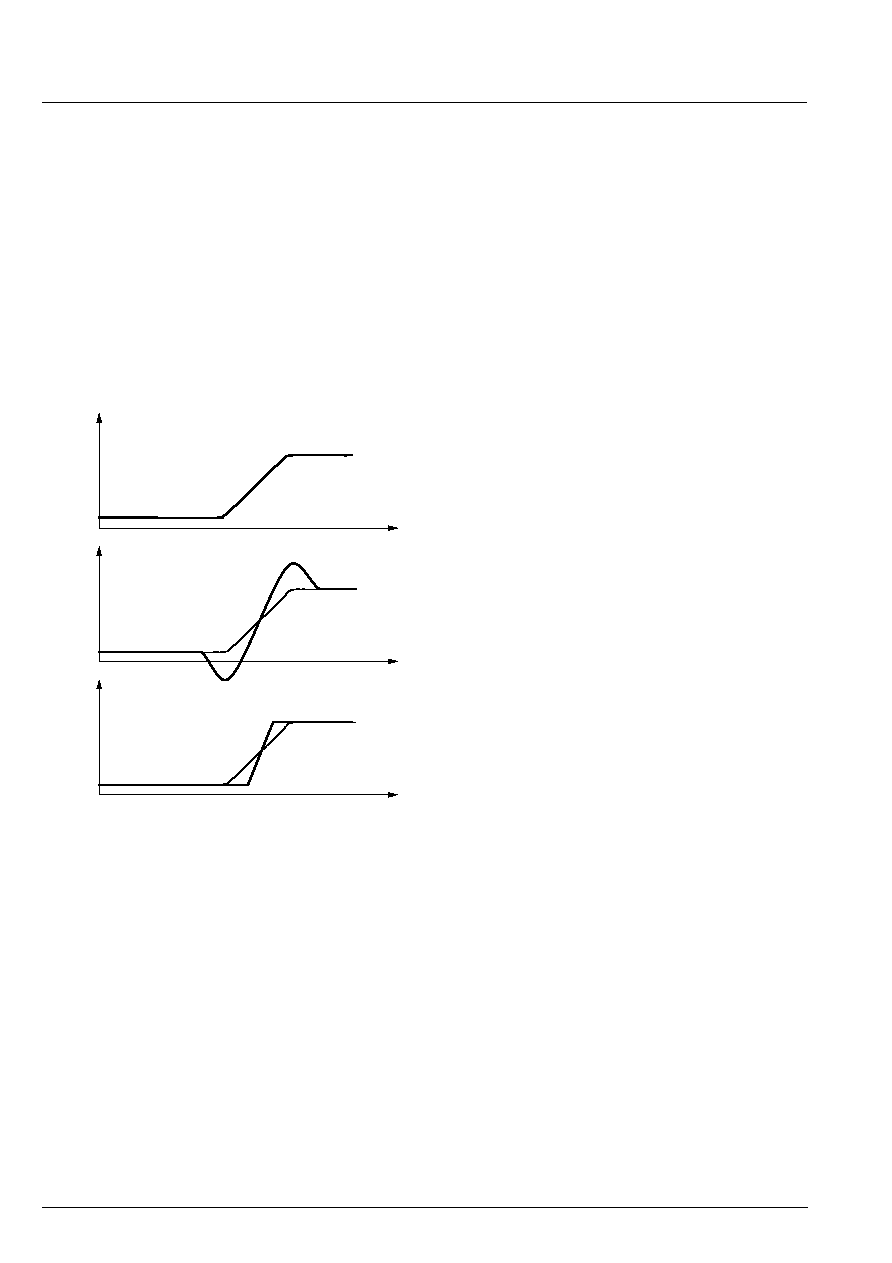
PRELIMINARY DATA SHEET
VDP 31xxB
18
Micronas
2.8.8. Chroma Transient Improvement
The intention of this block is to enhance the chroma
resolution. A correction signal is calculated by differenti-
ation of the color difference signals. The differentiation
can be selected according to the signal bandwidth, e.g.
for PAL/NTSC/SECAM or digital component signals,
respectively. The amplitude of the correction signal is
adjustable. Small noise amplitudes in the correction sig-
nal are suppressed by an adjustable coring circuit. To
eliminate `wrong colors', which are caused by over and
undershoots at the chroma transition, the sharpened
chroma signals are limited to a proper value automati-
cally.
Fig. 2≠18: Digital Color Transient Improvement
t
t
t
Cr out
Cb out
Ampl.
Cr in
Cb in
a)
b)
c)
a) Cr Cb input of DTI
b) Cr Cb input
)
Correction signal
c) sharpened and limited Cr Cb
2.8.9. Inverse Matrix
A 6-multiplier matrix transcodes the Cr and Cb signals
to R≠Y, B≠Y, and G≠Y. The multipliers are also used to
adjust color saturation in the range of 0 to 2. The coeffi-
cients are signed and have a resolution of 9 bits. There
are separate matrix coefficients for main and side pic-
tures. The matrix computes:
R≠Y
+
MR1*Cb
)
MR2*Cr
G≠Y
+
MG1*Cb
)
MG2*Cr
B≠Y
+
MB1*Cb
)
MB2*Cr
The initialization values for the matrix are computed
from the standard ITUR (CCIR) matrix:
R
G
B
+
1
1
1
0
*
0.345
1.773
1.402
*
0.713
0
Y
Cb
Cr
For a contrast setting of CTM
+
32, the matrix values are
scaled by a factor of 64, see also table 3≠1.
2.8.10. RGB Processing
After adding the post-processed luma, the digital RGB
signals are limited to 10 bits. Three multipliers are used
to digitally adjust the white drive. Using the same multi-
pliers an average beam current limiter is implemented.
See also section 2.9.1. `CRT Measurement and Con-
trol'.
2.8.11. OSD Color Lookup Table
The VDP 31xxB has five input lines for an OSD signal.
This signal forms a 5-bit address for a color look-up table
(CLUT). The CLUT is a memory with 32 words where
each word holds a RGB value.
Bits 0 to 3 (bit 4
+
0) form the addresses for the ROM part
of the OSD, which generates full RGB signals (bit 0 to 2)
and half-contrast RGB signals (bit 3).
Bit 4 addresses the RAM part of the OSD with 16 freely
programmable colors, addressable with bit 0 to 3. The
programming is done via the I
2
C-bus.
The amplitude of the CLUT output signals can be ad-
justed separately for R, G and B via the I
2
C-bus. The
switchover between video RGB and OSD RGB is done
via the Priority bus.

PRELIMINARY DATA SHEET
VDP 31xxB
19
Micronas
2.8.12. Picture Frame Generator
When the picture does not fill the total screen (height or
width too small) it is surrounded with black areas. These
areas (and more) can be colored with the picture frame
generator. This is done by switching over the RGB signal
from the matrix to the signal from the OSD color look-up
table.
The width of each area (left, right, upper, lower) can be
adjusted separately. The generator starts on the right,
respectively lower side of the screen and stops on the
left, respectively upper side of the screen. This means,
it runs during horizontal, respectively vertical flyback.
The color of the complete border can be stored in the
programmable OSD color look-up table in a separate
address. The format is 3
4 bit RGB. The contrast can
be adjusted separately.
The picture frame generator includes a priority master
circuit. Its priority is programmable and the border is
generated only if the priority is higher than the priority at
the PRIO bus. Therefore the border can be underlay or
overlay depending on the picture source.
2.8.13. Priority Codec
The priority decoder has three input lines for up to eight
priorities. The highest priority is all three lines at low lev-
el. A 5-bit information is attached to each priority (see
table 3≠1 `Priority Bus'). These bits are programmable
via the I
2
C-bus and have the following meanings:
≠ one of two contrast, brightness and matrix values for
main and side picture
≠ RGB from video signal or color look-up table
≠ disable/enable black level expander
≠ disable/enable peaking transient suppression when
signal is switched
≠ disable/enable analog fast blank input 1
≠ disable/enable analog fast blank input 2
2.8.14. Scan Velocity Modulation
The RGB input signal of the SVM is converted to Y in a
simple matrix. Then the Y signal is differentiated by a fil-
ter of the transfer function 1≠Z
≠N
, where N is program-
mable from 1 to 6. With a coring, some noise can be sup-
pressed. This is followed by a gain adjustment and an
adjustable limiter. The analog output signal is generated
by an 8-bit D/A converter.
The signal delay can be adjusted by
±
3.5 clocks in half-
clock steps. For the gain and filter adjustment there are
two parameter sets. The switching between these two
sets is done with the same RGB switch signal that is
used for switching between video-RGB and OSD-RGB
for the RGB outputs. (See Fig. 2≠19).
2.8.15. Display Phase Shifter
A phase shifter is used to partially compensate the
phase differences between the video source and the fly-
back signal. By using the described clock system, this
phase shifter works with an accuracy of approximately
1 ns. It has a range of 1 clock period which is equivalent
to
±
24.7 ns at 20.25 MHz. The large amount of phase
shift (full clock periods) is realized in the front-end circuit.
Fig. 2≠19: SVM block diagram
G
R
B
Matrix and
Shaping
Modulation
Notch
Differen-
tiator
1≠Z
≠Nx
N1
N2
Coring
adjustment
Gain
adjustment
Limiter
Delay
adjustment
D/A
Converter
Coring
Gain1
Gain2
Limit
Delay
RGB Switch
Output
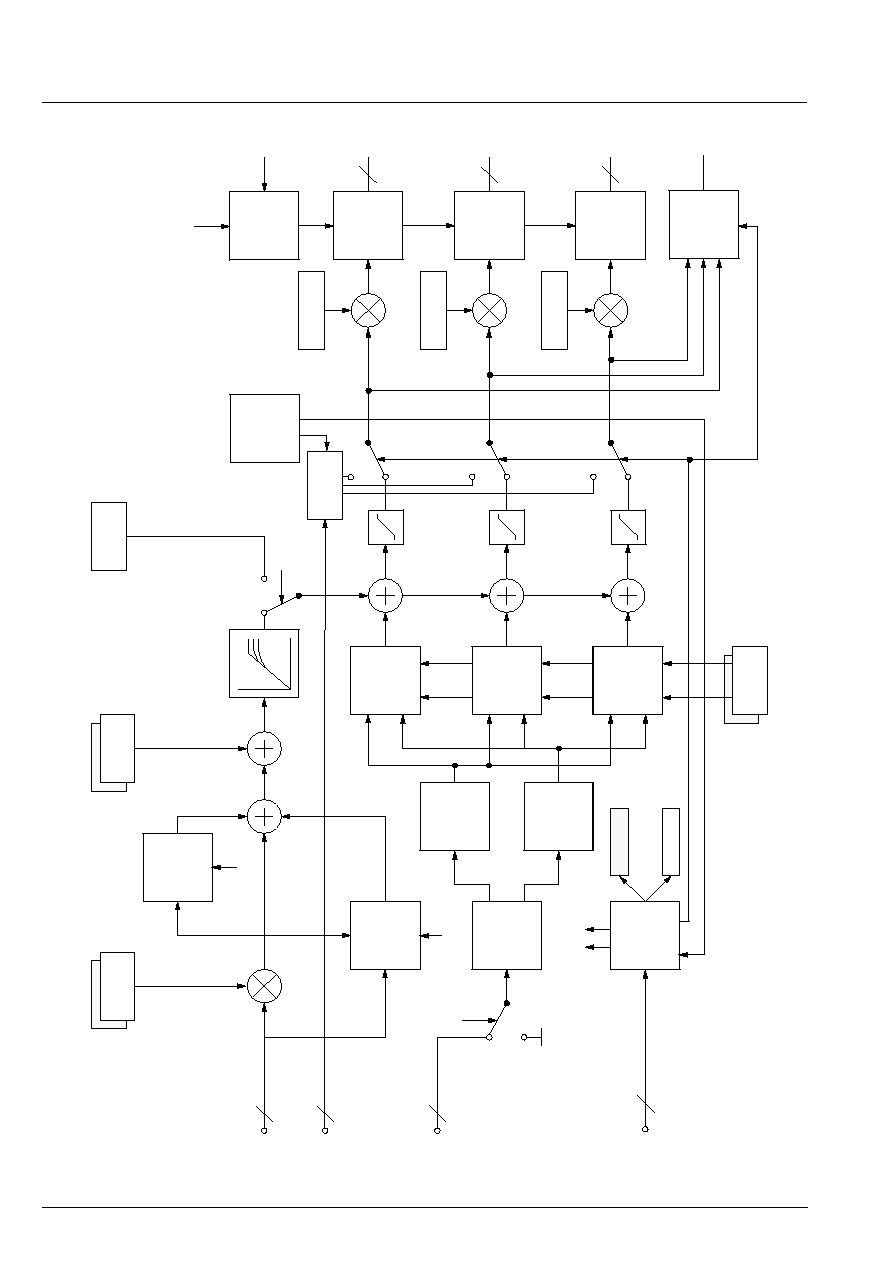
PRELIMINAR
Y
DA
T
A
SHEET
VDP
31xxB
20
Micronas
contrast
dynamic
peaking
brightness
+ offset
softlimiter
whitedrive
measurement
clock
horizontal
flyback
DTI
(Cr)
DTI
(Cb)
Interpol
4:4:4
black
level
expander
10
dig.
Rout
dig.
Gout
dig.
Bout
Cr
Cb
dig.
Y in
dig.
CrCb in
8
8
Matrix
saturation
whitedrive R
x beamcurr. lim.
display
& clock
control
PRIO in
PRIO
decoder
select
coefficients
main picture
side picture
3
Matrix
R'
Matrix
G'
Matrix
B'
Y
R
G
B
luma insert
for CRTmeasurement
CLUT,
for CRTmeasurement
blanking
Fig. 2
≠
20:
Digital back-end
dig. OSD in
5
Contrast
SVMout
10
10
Scan
Velocity
Modulation
Picture
Frame
Generator
prio
prio
whitedrive G
x beamcurr. lim.
whitedrive B
x beamcurr. lim.
Phase
Shift
0...1 clock
Phase
Shift
0...1 clock
Phase
Shift
0...1 clock
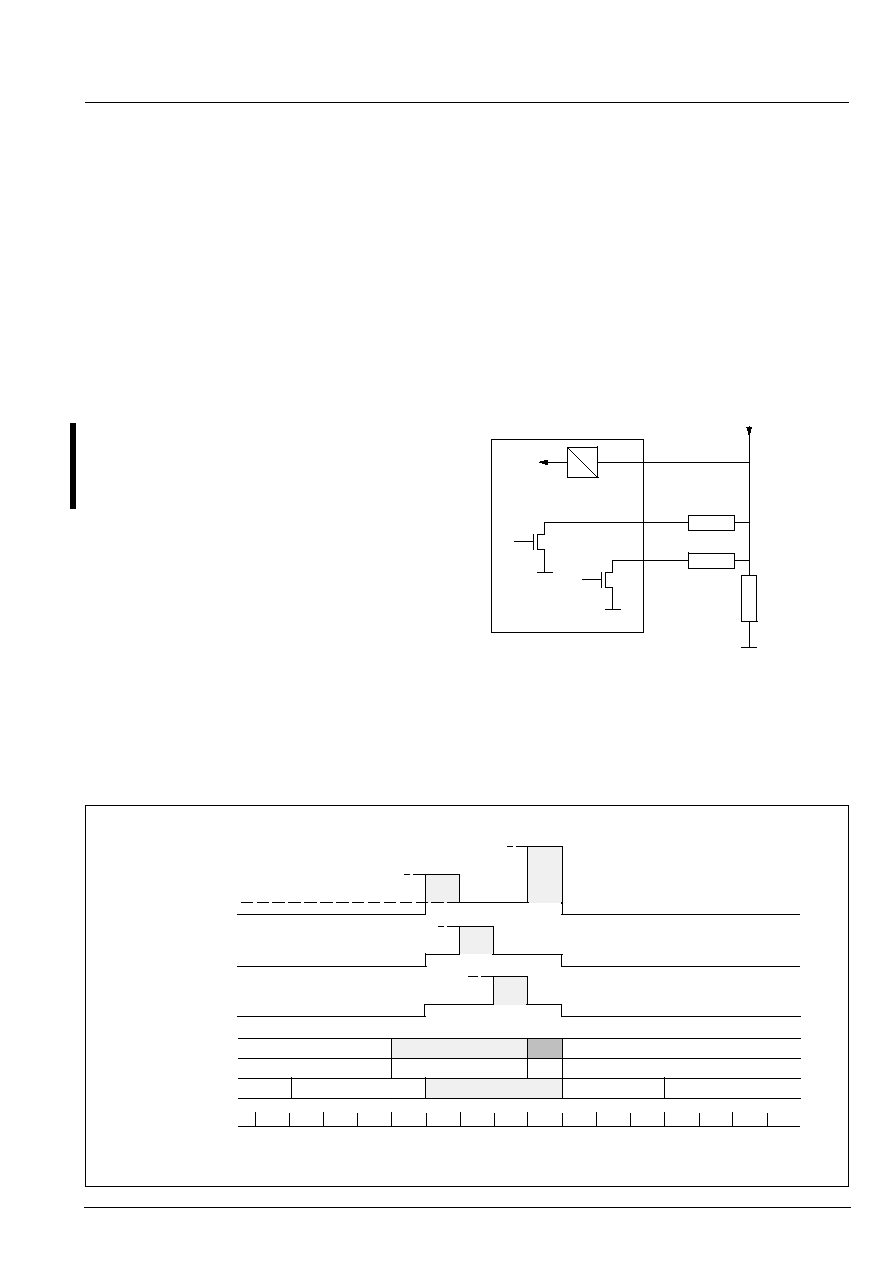
PRELIMINARY DATA SHEET
VDP 31xxB
21
Micronas
2.9. Analog Back End
The digital RGB signals are converted to analog RGBs
using three video digital to analog converters (DAC) with
10-bit resolution. An analog brightness value is provided
by three additional DACs. The adjustment range is 40%
of the full RGB range.
Controlling the whitedrive/analog brightness and also
the external contrast and brightness adjustments is
done via the Fast Processor, located in the front-end.
Control of the cutoff DACs is via I
2
C-bus registers.
Finally cutoff and blanking values are added to the RGB
signals. Cutoff (dark current) is provided by three 9-bit
DACs. The adjustment range is 60% of full scale RGB
range.
The analog RGB-outputs are current outputs with cur-
rent-sink characteristics. The maximum current drawn
by the output stage is obtained with peak white RGB. An
external half contrast signal can be used to reduce the
output current of the RGB outputs to 50%.
2.9.1. CRT Measurement and Control
The display processor is equipped with an 8-bit PDM-
ADC for all measuring purposes. The ADC is connected
to the sense input pin, the input range is 0 to 1.5V. The
bandwidth of the PDM filter can be selected; it is
40/80 kHz for small/large bandwidth setting. The input
impedance is more than 1 M
.
Cutoff and white drive current measurement are carried
out during the vertical blanking interval. They always use
the small bandwidth setting. The current range for the
cutoff measurement is set by connecting a sense resis-
tor to the MADC input. For the whitedrive measurement,
the range is set by using another sense resistor and the
range select switch 2 output pin (RSW2). During the ac-
tive picture, the minimum and maximum beam current
is measured. The measurement range can be set by us-
ing the range select switch 1 pin (RSW1) as shown in
Fig. 2≠21 and Fig. 2≠22. The timing window of this mea-
surement is programmable. The intention is to automati-
cally detect letterbox transmission or to measure the ac-
tual beam current. All control loops are closed via the
external control microprocessor.
SENSE
RSW1
RSW2
R2
R3
beam current
A
D
MADC
R1
Fig. 2≠21: MADC Range Switches
ultra black
black
cutoff
white
drive
CR + IBRM
CR + IBRM + WDRV∑WDR
R
G
B
TML
CG + IBRM
CB + IBRM
PICTURE MEAS.
PICTURE MEAS.
TUBE MEASUREMENT
active
measurement
resistor
R1
¯
R2
¯
R3
RSW1=on, RSW2=on
R1
R1
¯
R3
RSW2
R
R
cutoff
cutoff
G
B
R1
¯
R2
¯
R3
Fig. 2≠22: MADC Measurement Timing
RSW1=on, RSW2=on
PMST
PMSO
=on
Lines

PRELIMINARY DATA SHEET
VDP 31xxB
22
Micronas
In each field two sets of measurements can be taken:
a) The picture tube measurement returns results for
≠ cutoff R
≠ cutoff G
≠ cutoff B
≠ white drive R or G or B (sequentially)
b) The picture measurement returns data on
≠ active picture maximum current
≠ active picture minimum current
The tube measurement is automatically started when
the cutoff blue result register is read. Cutoff control for
RGB requires one field only while a complete white-drive
control requires three fields. If the measurement mode
is set to `offset check', a measurement cycle is run with
the cutoff/whitedrive signals set to zero. This allows to
compensate the MADC offset as well as input the
leakage currents. During cutoff and whitedrive measure-
ments, the average beam current limiter function (ref.
2.9.3.) is switched off and a programmable value is used
for the brightness setting. The start line of the tube mea-
surement can be programmed via I
2
C-bus, the first line
used for the measurement, i.e. measurement of cutoff
red, is 2 lines after the programmed start line.
The picture measurement must be enabled by the con-
trol microprocessor after reading the min./max. result
registers. If a `1' is written into bit 2 in subaddress 25, the
measurement runs for one field. For the next measure-
ment a `1' has to be written again. The measurement is
always started at the beginning of active video.
The vertical timing for the picture measurement is pro-
grammable, and may even be a single line. Also the sig-
nal bandwidth is switchable for the picture measure-
ment.
Two horizontal windows are available for the picture
measurement. The large window is active for the entire
active line. Tube measurement is always carried out with
the small window. Measurement windows for picture
and tube measurement are shown in Figure 2≠23.
active video
field 1/ 2
ÕÕÕ
ÕÕÕ
ÕÕÕÕÕÕÕÕÕ
small window for tube
measurement (cutoff, white drive)
large window for active picture
picture meas. start
tube measurement
picture meas. end
Fig. 2≠23: Windows for tube and picture measure-
ments
2.9.2. SCART Output Signal
The RGB output of the VDP 31xxB can also be used to
drive a SCART output. In the case of the SCART signal,
the parameter CLMPR (clamping reference) has to be
set to 1. Then, during blanking, the RGB outputs are au-
tomatically set to 50% of the maximum brightness. The
DC offset values can be adjusted with the cutoff parame-
ters CR, CG, and CB. The amplitudes can be adjusted
with the drive parameters WDR, WDG, and WDB.

PRELIMINARY DATA SHEET
VDP 31xxB
23
Micronas
2.9.3. Average Beam Current Limiter
The average beam current limiter (BCL) uses the sense
input for the beam current measurement. The BCL uses
a different filter to average the beam current during the
active picture. The filter bandwidth is approx. 2 kHz. The
beam current limiter has an automatic offset adjustment
that is active two lines before the first cutoff measure-
ment line.
The beam current limiter function is located in the front-
end. The data exchange between the front-end and the
back-end is done via a single-wire serial interface.
The beam current limiter allows the setting of a threshold
current. If the beam current is above the threshold, the
excess current is low-pass filtered and used to attenuate
the RGB outputs by adjusting the white-drive multipliers
for the internal (digital) RGB signals, and the analog con-
trast multipliers for the analog RGB inputs, respectively.
The lower limit of the attenuator is programmable, thus
a minimum contrast can always be set. During the tube
measurement, the ABL attenuation is switched off. After
the white drive measurement line it takes 3 lines to
switch back to BCL limited drives and brightness.
Typical characteristics of the ABL for different loop gains
are shown in Fig. 2≠24; for this example the tube has
been assumed to have square law characteristics.
Fig. 2≠24: Beam current limiter characteristics:
beam current output vs. drive
BCL threshold: 1
beam current
drive
2.9.4. Analog RGB Insertion
The VDP 31xxB allows insertion of 2 external analog
RGB signals. Each RGB signal is key-clamped and in-
serted into the main RGB by the fast blank switch. The
selected external RGB input is virtually handled as a
priority bus signal. Thus, it can be overlaid or underlaid
to the digital picture. The external RGB signals can be
adjusted independently as regards DC-level (bright-
ness) and magnitude (contrast).
Which analog RGB input is selected depends on the fast
blank input signals and the programming of a number of
I
2
C-bus register settings (see Table 2≠3 and Fig. 2≠25).
Both fast blank inputs must be either active-low or ac-
tive-high.
All signals for analog RGB insertion (RIN1/2, GIN1/2,
BIN1/2, FBLIN1/2, HCS) must be synchronized to the
horizontal flyback, otherwise a horizontal jitter will be vis-
ible. The VDP 31xxB has no means for timing correction
of the analog RGB input signals.
Table 2≠3: RGB Input Selection
FBFOH1 = 0, FBFOH2 = 0, FBFOL1 = 0, FBFOL2 = 0
FBLIN1
FBLIN2
FBPOL
FBPRIO
RGB output
0
0
0
x
Video
0
1
0
x
RGB input 2
1
0
0
x
RGB input 1
1
1
0
0
RGB input 1
1
1
0
1
RGB input 2
0
0
1
0
RGB input 1
0
0
1
1
RGB input 2
0
1
1
x
RGB input 1
1
0
1
x
RGB input 2
1
1
1
x
Video

PRELIMINARY DATA SHEET
VDP 31xxB
24
Micronas
2.9.5. Fast Blank Monitor
The presence of external analog RGB sources can be
detected by means of a fast blank monitor. The status of
the selected fast blank input can be monitored via an I
2
C
bus register. There is a 2 bit information, giving static and
dynamic indication of a fast blank signal. The static bit is
directly reading the fast blank input line, whereas the dy-
namic bit is reading the status of a flip-flop triggered by
the negative edge of the fast blank signal.
With this monitor logic it is possible to detect if there is
an external RGB source active and if it is a full screen in-
sertion or only a box. The monitor logic is connected di-
rectly to the FBLIN1 or FBLIN2 pin. Selection is done via
I
2
C bus register.
FBLIN1
FBLIN2
#
Fast
Blank
Monitor
FBPOL
FBFOH1
FBPRIO
FB
int
Fast
Blank
Selection
FBFOH2
FBMON
FBFOL1
FBFOL2
Fig. 2≠25: Fast Blank Selection Logic
#
2.9.6. Half Contrast Control
Insertion of transparent text pages or OSD onto the vid-
eo picture is often difficult to read, especially if the video
contrast is high. The VDP 31xxB allows contrast reduc-
tion of the video background by means of a half contrast
input (HCS pin). This input can be supplied with a fast
switching signal (similar to the fast blank input), typically
defining a rectangular box in which the video picture is
displayed with reduced contrast. The analog RGB inputs
are still displayed with full contrast.
The HCS input is multiplexed with the PORT0 input/out-
put on the same pin, selection is done via I
2
C-bus regis-
ter. If the HCS input is selected, then the port function of
this pin is disabled and writing data into PORT0 will have
no effect. If the HCS input is not selected, the I
2
C-bus
register bits HCSFOH and HCSPOL must be used to
disable the half contrast function.
HCS
HCSEN
HCSFOH
Fig. 2≠26: Half Contrast Switch Logic
#
HCS intern
HCSPOL
2.10. IO Port Expander
The VDP 31xxB provides a general purpose IO port to
control and monitor up to seven external signals. The
port direction is programmable for each bit individually.
Via I
2
C bus register it is possible to write or read each
port pin. Because of the relatively low I
2
C bus speed,
only slow or static signals can be handled.
The port signals are multiplexed with other signals to
minimize pin count. PORT0 is multiplexed with the HCS
input signal, PORT1 is multiplexed with the FSY output
signal, PORT[6:2] are multiplexed with the color bus in-
put COLOR[4:0]. The pin configuration is programmable
via I
2
C bus register. All register bits can be read back, the
default configuration after reset is input on PORT[1:0]
and COLOR[4:0] enabled.

PRELIMINARY DATA SHEET
VDP 31xxB
25
Micronas
ext. contrast *
cutof
f R
10 bit
DAC
Video
3.75mA
blank &
timing
8 bit
ADC
measurm.
9 bit
U/I≠DAC
3.75mA
clamp
key
analog
R in
Sense
analog
R out
analog
G out
analog
B out
analog
G in
analog
B in
measurement
buf
fer
digital
R in
H
V
measurem.
10
9 bit
DAC
1.5 mA
digital
G in
digital
B in
9 bit
DAC
2.2 mA
10 bit
DAC
Video
3.75mA
10 bit
DAC
Video
3.75mA
9 bit
U/I≠DAC
3.75mA
9 bit
U/I≠DAC
3.75mA
cutof
f G
9 bit
DAC
2.2 mA
cutof
f B
9 bit
DAC
2.2 mA
9 bit
DAC
1.5 mA
9 bit
DAC
1.5 mA
Input
ext. brightness *
I/O
Fig. 2≠27: Analog back-end
white drive R *
white drive R
ext. brightness *
white drive G
ext. brightness *
white drive B
9 bit
DAC
1.5 mA
white drive G
9 bit
DAC
1.5 mA
int. brightness *
white drive B
9 bit
DAC
1.5 mA
white drive R
int. brightness *
int. brightness *
fast
beam current lim.
ext. contrast *
white drive G *
beam current lim.
ext. contrast *
white drive B *
beam current lim.
white drive R
white drive G
white drive B
int . brightness
ext. contrast
ext. brightness
10
10
analog
SVM out
8
8 bit
DAC
SVM
1.88mA
0.94mA
digital
SVM in
750
µ
A
blanking
750
µ
A
blanking
750
µ
A
blanking
serial interface
& mux
clamp
& mux
clamp
& mux
1
2
1
2
1
2
1
2
blank in
FBL
prio
HCS

VDP 31xxB
PRELIMINARY DATA SHEET
26
Micronas
2.11. Synchronization and Deflection
The synchronization and deflection processing is
distributed over front-end and back-end. The video
clamping, horizontal and vertical sync separation and all
video related timing information are processed in the
front-end. Most of the processing that runs at the hori-
zontal frequency is programmed on the internal Fast
Processor (FP). Also the values for vertical and East/
West deflection are calculated by the FP software.
The information extracted by the video sync processing
is multiplexed onto the hardware front sync signal (FSY)
and distributed internally to the rest of the video proces-
sing system.
The data for the vertical deflection, the sawtooth and the
East/West correction signal is calculated in the front
end. The data is transferred to the back-end by a single
wire interface.
The display related synchronization, i.e. generation of
horizontal and vertical drive and synchronization of hori-
zontal and vertical drive to the video timing extracted in
the front-end, are implemented in hardware in the back-
end.
2.11.1. Deflection Processing
The deflection processing generates the signals for the
horizontal and vertical drive (see Fig. 2≠28). This block
contains two phase-locked loops:
≠ PLL2 generates the horizontal and vertical timing, e.g.
blanking, clamping and composite sync. Phase and
frequency are synchronized by the front sync signal.
≠ PLL3 adjusts the phase of the horizontal drive pulse
and compensates for the delay of the horizontal output
stage. Phase and frequency are synchronized by the
oscillator signal of PLL2.
The horizontal drive circuitry uses a digital sine wave
generator to produce the exact (subclock) timing for the
drive pulse. The generator runs at 1 MHz; in the output
stage the frequency is divided down to give drive-pulse
period and width. In standby mode, the output stage is
driven from an internal 1 MHz clock that is derived from
the 5 MHz clock signal and a fixed drive pulse width is
used. When the circuit is switched out of standby
operation, the drive pulse width is programmable. The
horizontal drive uses an open drain output transistor.
The Main Sync (MSY) signal that is generated from
PLL3 is a multiplex of all display-related data
(Fig. 2≠29). This signal is intended for use by other pro-
cessors, e.g. a PIP processor can use this signal to ad-
just to a certain display position.
2.11.2. Horizontal Phase Adjustment
This section describes a simple way to align PLL phases
and the horizontal frame position.
1. The parameter NEWLIN in the front-end has to be
adjusted. The minimum possible value is 34 (recom-
mended for a standard 4:3 signal).
2. With HDRV, the duration of the horizontal drive pulse
has to be adjusted.
3. With POFS2, the clamping pulse for the analog RGB
input has to be adjusted to the correct position, e.g.
the pedestal of the generator signal.
4. With POFS3, the horizontal position of the analog
RGB signal (from SCART) has to be adjusted.
5. With HPOS, the digital RGB output signal (from VPC)
has to be adjusted to the correct horizontal position.
6. With HBST and HBSO, the start and stop values for
the horizontal blanking have to be adjusted.
Note: The processing delay of the internal digital video
path differs depending on the comb filter option of the
VDP 31xxB. The versions with comb filter have an addi-
tional delay of 35 clock cycles. Therefore, the timing of
the external analog RGB signals has to be adjusted (with
POFS2 and POFS3) according to the actual hardware
version of the VDP 31xxB. The hardware version can be
read out via FP subaddress 0xF1.

VDP 31xxB
PRELIMINARY DATA SHEET
27
Micronas
phase
comparator
&
lowpass
PLL2
composite
sync
generator
E/W
correction
sawtooth
PWM
15 bit
CSY
E/W
ouput
V
output
V
flyback
PWM
15 bit
DCO
front
sync
interface
FSY
VDATA
main
sync
generator
vertical
serial
data
phase
comparator
&
lowpass
PLL3
1:64
&
output
stage
H
flyback
H
drive
DCO
display
timing
line
counter
blanking, clamping, etc.
clock & control
sinewave
generator
&
DAC
LPF
Standby clock
Fig. 2≠28: Deflection processing block diagram
MSY
vertical reset
skew
measure≠
ment
M1
M2
(not in scale)
M1
M2
F
V
line
[0]
line
[7]
line
[8]
not
used
Parity
input
analog
video
MSY
not
used
not
used
not
used
not
used
timing reference for PICTURE bus
≠ chroma multiplex sync
≠ active picture data after xxx clocks
V: Vert.
blanking
0 = off
1 = on
F:
Field #
0 = Field 1
1 = Field 2
line: Field line #
1...N
Parity
Fig. 2≠29: Main sync format

VDP 31xxB
PRELIMINARY DATA SHEET
28
Micronas
2.11.3. Vertical and East/West Deflection
The calculations of the vertical and East/West deflection
waveforms is done by the internal Fast Processor (FP).
The algorithm uses a chain of accumulators to generate
the required polynomial waveforms. To produce the
deflection waveforms, the accumulators are initialized at
the beginning of each field. The initialization values must
be computed by the TV control processor and are written
to the front-end once. The waveforms are described as
polynomials in x, where x varies from 0 to 1 for one field.
P: a + b(x≠0.5) + c(x≠0.5)
2
+
d(x≠0.5)
3
+ e(x≠0.5)
4
The initialization values for the accumulators a0..a3 for
vertical deflection and a0..a4 for East/West deflection
are 12-bit values.
The vertical waveform can be scaled according the
average beam current. This is used to compensate the
effects of electric high tension changes due to beam cur-
rent variations. In order to get a faster vertical retrace
timing, the output impedance of the vertical
D/A-converter can be reduced by 50% during the re-
trace.
Fig. 2≠30 shows several vertical and East/West deflec-
tion waveforms. The polynomial coefficients are also
stated.
2.11.4. Protection Circuitry
≠ Picture tube and drive stage protection is provided
through the following measures:
≠ Vertical flyback protection input: this pin searches for
a negative edge in every field, otherwise the RGB
drive signals are blanked.
≠ Drive shutoff during flyback: this feature can be se-
lected by software.
≠ Safety input pin: this input has two thresholds. Be-
tween zero and the lower threshold, normal function-
ing takes place. Between the lower and the higher
threshold, the RGB signals are blanked. Above the
higher threshold, the RGB signals are blanked and the
horizontal drive is shut off. Both thresholds have a
small hysteresis.
≠ The main oscillator and the horizontal drive circuitry
are run from a separate (standby) power supply and
are already active while the TV set is powering up.
Fig. 2≠30: Vertical and East/West deflection waveforms
East/West:
a,b,c,d,e
0,0,1,0,0
0,0,0,0,1
0,0,1,1,1
Vertical:
a,b,c,d
0,1,0,0
0,1,1,0
0,1,0,1

PRELIMINARY DATA SHEET
VDP 31xxB
29
Micronas
2.12. Reset Function
Reset of most VDP 31xxB functions is performed by the
RESET pin. When this pin becomes active, all internal
registers and counters are lost. When the RESET pin is
released, the internal reset is still active for 4
µ
s. After
that time, the initialization of all required registers is per-
formed by the internal Fast Processor. During this initial-
ization procedure (see Fig. 2≠31) it is not possible to ac-
cess the VDP 31xxB via the serial interface (I
2
C).
Access to other ICs via the serial bus is possible during
that time.
The 5 MHz clock divider and the 1 MHz standby clock di-
vider are not affected by reset. The clock source for the
horizontal output generator is switched to the standby
clock during reset.
Reset
Internal
Reset
Initialization
4
µ
s
approx. 60
µ
s
Fig. 2≠31: External Reset
2.13. Standby and Power-On
In standby mode the whole signal processing of the VDP
31xxB is disabled and only some basic functions are
working. The standby mode is realized by switching off
the supplies for analog front-end (VSUPF), analog back-
end (VSUPO) and digital circuitry (VSUPD). The stand-
by supply (VSTBY) still has its nominal voltage.
To disable all the analog and digital functions, it is neces-
sary to bring the analog and digital supplies below 0.5 V.
Only this guarantees that all the normal functions are
disabled and the standby current for analog and digital
supply is at its minimum.
When switched off, the negative slope of the supply
voltage VSUPD should not be larger than approximately
0.2 V/
µ
s (see Recommended Operating Conditions).
In the standby mode, all registers and counter values in
the VDP 31xxB are lost, they will be re-initialized via the
internal Fast Processor after analog and digital supplies
are switched on again and the RESET pin is released.
In the standby mode the following functions are still
available (see also 2.11.1.):
≠ 20.25 MHz crystal oscillator
≠ 5 MHz clock output (CLK5)
≠ horizontal drive output (HOUT)
The clock source for the horizontal output generator is
switched to the standby clock which is derived from the
5 MHz clock. The duty cycle of HOUT is set to 50%.
Protection modes with safety and horizontal flyback pins
are not available.
The VDP 31xxB has clock and voltage supervision cir-
cuits to generate a stable HOUT signal during power-on
and standby. The HOUT signal is disabled until a proper
CLK5 signal (5 MHz clock) is detected. When released,
the HOUT generator runs with the standby clock. Cou-
pling the HOUT generator to the deflection PLL has to
be done by CCU using the EHPLL bit. Fig. 2≠32 shows
the signals during power-on and standby.
VSTBY
VSUP
D
standby
mode
XTAL
CLK5
Clock
Release
HOUT
Fig. 2≠32: Power-On, Standby On/Off
1 µ
s
RESET
Switching the HOUT signal into standby mode can be
done by the CCU via the EHPLL bit or by the internal volt-
age supervision. The voltage supervision activates a
power-down signal when the supply for the digital cir-
cuits (VSUPD) goes below
X
4.5 V for more than 50ns.
This power down signal is extended by 50
µ
s after
VSUPD is back again. The power-down signal switches
the clock source for the HOUT generation to the standby
clock and sets the duty cycle to 50%. This is exactly what
the EHPLL bit does.
As the clocks from the deflection PLL and the standby
clock are not in phase, the actual phase (High/Low) of
the HOUT signal may be up to one PLL or standby clock
(
X
1
µ
s) longer than a regular one when the clock source
is changed.

VDP 31xxB
PRELIMINARY DATA SHEET
30
Micronas
3. Serial Interface
3.1. I
2
C-Bus Interface
Communication between the VDP and the external con-
troller is done via I
2
C-bus. The VDP has two I
2
C-bus
slave interfaces (for compatibility with VPC/DDP ap-
plications) ≠ one in the front-end and one in the back-
end. Both I
2
C-bus interfaces use I
2
C clock synchroniza-
tion to slow down the interface if required. Both I
2
C-bus
interfaces use one level of subaddress: the I
2
C-bus chip
address is used to address the IC and a subaddress se-
lects one of the internal registers. The I
2
C-bus chip ad-
dresses are given below:
Chip
Address
A6
A5
A4
A3
A2
A1
A0
R/W
front-end
1
0
0
0
1
1
1
1/0
back-end
1
0
0
0
1
0
1
1/0
The registers of the VDP have 8 or 16-bit data size;
16-bit registers are accessed by reading/writing two
8-bit data words.
Figure 3≠1 shows I
2
C-bus protocols for read and write
operations of the interface; the read operation requires
an extra start condition and repetition of the chip address
with read command set.
3.2. Control and Status Registers
Table 3≠1 gives definitions of the VDP control and status
registers. The number of bits indicated for each register
in the table is the number of bits implemented in hard-
ware, i.e. a 9-bit register must always be accessed using
two data bytes but the 7 MSB will be `don't care' on write
operations and `0' on read operations. Write registers
that can be read back are indicated in Table 3≠1.
Functions implemented by software in the on-chip con-
trol microprocessor (FP) are explained in Table 3≠3.
A hardware reset initializes all control registers to 0. The
automatic chip initialization loads a selected set of regis-
ters with the default values given in Table 3≠1.
The register modes given in Table 3≠1 are
≠ w:
write only register
≠ w/r:
write/read data register
≠ r:
read data from VDP
≠ v:
register is latched with vertical sync
≠ h:
register is latched with horizontal sync
The mnemonics used in the Micronas VDP demo soft-
ware are given in the last column.
W
P
1 or 2 byte Data
W
high byte Data
S
S
Ack
Ack
Ack
Ack
0111 1100
0111 1100
R
S
Ack
SDA
SCL
1
0
S
P
P
low byte Data
Ack
W
=
0
R
=
1
Ack
=
0
Nak
=
1
S
= Start
P
=
Stop
Ack
Nak
Fig. 3≠1: I
2
C-bus protocols
1000 111
1000 111
1000 111
I
2
C write access
subaddress 7c
I
2
C read access
subaddress 7c

PRELIMINARY DATA SHEET
VDP 31xxB
31
Micronas
Table 3≠1: I
2
C control and status registers of front-end
I
2
C Sub
address
Number
of bits
Mode
Function
Default
Name
FP INTERFACE
h'35
8
r
FP status
bit [0]
write request
bit [1]
read request
bit [2]
busy
FPSTA
h'36
16
w
bit[8:0]
9-bit FP read address
bit[11:9]
reserved, set to zero
FPRD
h'37
16
w
bit[8:0]
9-bit FP write address
bit[11:9]
reserved, set to zero
FPWR
h'38
16
w/r
bit[11:0]
FP data register, reading/writing to this
register will autoincrement the FP read/
write address. Only 16 bit of data are
transferred per I
2
C telegram.
FPDAT
BLACK LINE DETECTOR
h'12
16
w/r
read only register, do not write to this register!
after reading, LOWLIN and UPLIN are reset to 127 to start a new
measurement
bit[6:0]
number of lower black lines
bit[7]
always 0
bit[14:8]
number of upper black lines
bit[15]
0/1
normal/black picture
BLKLIN
LOWLIN
UPLIN
BLKPIC
PIN CIRCUITS
h'1F
16
w/r
INTLC & PORT pins:
bit[2:0]
0..7
output strength for INTLC & PORT Pins
(7 = tristate, 6 = weak ... 0 = strong)
bit[3]
0
reserved (set to 0)
bit[4]
0/1
pushpull/tristate for INTLC Pin
bit[5]
0/1
synchronization/no synchronization with
horizontal MSY for signal INTLC
bit[15:6]
reserved (set to 0)
0
0
0
TRPAD
SNCSTR
SNCDIS
VASYSEL
h'20
8
w/r
SYNC GENERATOR CONTROL:
bit[6:0]
0
reserved (set to 0)
bit[7]
0/1
positive/negative polarity for INTLC signal
0
SYNMODE
INTLCINV
PRIORITY BUS
h'24
8
w/r
priority bus ID register and control
bit [2:0]
0..7
priority ID, 0 highest
bit [4:3]
0..3
pad driver strength, 0 (strong) to 3 (weak)
bit [5]
0/1
reserved (set to 0)
bit [6]
0/1
source for prio request:
active video/clamp_to_1
bit [7]
0/1
disable/enable priority interface, if disabled
frontend is disconnected from priority bus!
0
0
0
0
0
PRIOMODE
PID
PRIOSTR
PIDSRC
PIDE

VDP 31xxB
PRELIMINARY DATA SHEET
32
Micronas
Name
Default
Function
Mode
Number
of bits
I
2
C Sub
address
SYNC GENERATOR
h'21
16
w/r
LINE LENGTH:
bit[10:0]
LINE LENGTH register
LINE LENGTH has to be set to 1295 for
correct adjustment of vertical signals.
bit[15:11]
reserved (set to 0)
1295
LINLEN
h'29
16
w/r
AVO STOP:
bit[10:0]
reserved (set to 0)
bit[11]
0/1
disable/enable test pattern generator
bit[13:12]
luma output mode:
00
Y = rampe (240 ... 17)
01
Y = 16
10
Y = 90
11
Y = 240
bit[14]
0/1
reserved (set to 0)
bit[15]
0/1
chroma output: pseudo color bar/zero
0
0
0
0
0
AVSTOP
COLBAREN
LMODE
CMODE
h'22
16
w/r
NEWLINE:
bit[10:0]
NEWLINE register
This register defines the readout start of
the next line in respect to the value of the
sync counter. Value of this register must
be greater than 31 for correct operation.
bit [15:11]
reserved (set to 0)
50
NEWLIN

VDP 31xxB
PRELIMINARY DATA SHEET
33
Micronas
Table 3≠2: Backend I
2
C-control and status registers
I
2
C sub
address
Number
of bits
Mode
Function
Default
Name
PRIORITY BUS
priority mask register, if bit[x] is set to 1 then the function is
active for the respective signal priority
h'75
9
w v
bit [7:0]
bit[x] 0/1: select contrast,brightness,matrix
for main/side picture
0
PBCT
h'71
9
w v
bit [7:0]
bit[x] 0/1: select main (video)/external (via CLUT)
RGB
0
PBERGB
h'7d
9
w v
bit [7:0]
bit[x] 0/1: enable/disable black level expander
0
PBBLE
h'79
9
w v
bit [7:0]
bit[x] 0/1: disable/enable peaking transient
suppression when signal is switched
0
PBPK
h'4b
9
w v
bit [7:0]
bit[x] 0/1: disable/enable analog fast blank input
0
PBFB
h'47
9
w v
bit [2:0]
picture frame generator priority id
bit [8]
enable prio id for picture frame generator
0
PFGID
PFGEN
LUMA CHANNEL
h'61
9
w v
bit [5:0]
0..63/32
main picture contrast
32
CTM
h'65
9
w v
bit [5:0]
0..63/32
side picture contrast
32
CTS
h'51
9
w v
bit [8:0]
≠256..255
main picture brightness
0
BRM
h'55
9
w v
bit [8:0]
≠256..255
side picture brightness
0
BRS
h'59
9
w v
black level expander:
bit [3:0]
0..15
tilt coefficient
bit [8:4]
0...31
amount
8
12
BTLT
BAM
h'5d
9
w v
black level expander:
bit [8:0]
0..511
disable expansion, threshold value
200
BTHR
h'69
9
w v
luma peaking filter, the gain at high frequencies and small signal
amplitudes is: 1 + (k1+k2)/8
bit [3:0]
0..15
k1: peaking level undershoot
bit [7:4]
0..15
k2: peaking level overshoot
bit [8]
0/1
peaking value normal/inverted
(peaking/softening)
4
4
0
PKUN
PKOV
PKINV
h'6d
9
w v
luma peaking filter, coring
bit [4:0]
0..31
coring level
bit [7:5]
reserved
bit [8]
0/1
peaking filter center frequency high/low
3
0
COR
PFS
h'41
9
w v
luma soft limiter, slope A and B
bit [3:0]
slope segment A
bit [7:4]
slope segment B
0
0
LSLSA
LSLSB
h'45
9
w v
bit [7:0]
luma soft limiter absolute limit (unsigned)
bit [8] 0/1
modulation off/on
255
1
LSLAL
LSLM
h'49
9
w v
bit [8:0]
luma soft limiter segment B tilt point (unsigned)
300
LSLTB
h'4d
9
w v
bit [8:0]
luma soft limiter segment A tilt point (unsigned)
250
LSLTA

VDP 31xxB
PRELIMINARY DATA SHEET
34
Micronas
Name
Default
Function
Mode
Number
of bits
I
2
C sub
address
CHROMA CHANNEL
h'14
8
w/r
luma/chroma matching delay
bit [2:0]
≠3...3
variable chroma delay
bit [3]
0/1
chroma polarity signed / offset binary
bit [4]
0/1
C
B
(U) sample first / C
R
(V) sample first
bit [7:5]
reserved, set to 0
0
1
0
0
LDB
COB
ENVU
h'66
9
w v
digital transient improvement
bit [3:0]
0..15
coring value
bit [7:4]
0..15
DTI gain
bit [8]
0/1
narrow/wide bandwidth mode
1
5
1
DTICO
DTIGA
DTIMO
INVERSE MATRIX
h'7c
h'74
9
9
w v
w v
main picture matrix coefficient R≠Y = MR1M*C
B
+ MR2M*C
R
bit [8:0]
≠256/128 ... 255/128
bit [8:0]
≠256/128 ... 255/128
0
86
MR1M,
MR2M
h'6c
h'64
9
9
w v
w v
main picture matrix coefficient G≠Y = MG1M*C
B
+ MG2M*C
R
bit [8:0]
≠256/128 ... 255/128
bit [8:0]
≠256/128 ... 255/128
≠22
≠44
MG1M,
MG2M
h'5c
h'54
9
9
w v
w v
main picture matrix coefficient B≠Y = MB1M*C
B
+ MB2M*C
R
bit [8:0]
≠256/128 ... 255/128
bit [8:0]
≠256/128 ... 255/128
113
0
MB1M,
MB2M
h'78
h'70
9
9
w v
w v
side picture matrix coefficient R≠Y = MR1S*C
B
+ MR2S*C
R
bit [8:0]
≠256/128 ... 255/128
bit [8:0]
≠256/128 ... 255/128
0
73
MR1S,
MR2S
h'68
h'60
9
9
w v
w v
side picture matrix coefficient G≠Y = MG1S*C
B
+ MG2S*C
R
bit [8:0]
≠256/128 ... 255/128
bit [8:0]
≠256/128 ... 255/128
≠19
≠37
MG1S,
MG2S
h'58
h'50
9
9
w v
w v
side picture matrix coefficient B≠Y = MB1S*C
B
+ MB2S*C
R
bit [8:0]
≠256/128 ... 255/128
bit [8:0]
≠256/128 ... 255/128
97
0
MB1S,
MB2S
COLOR LOOK-UP TABLE
h'00≠
h'0f
16
w h
color look-up table : 16 entries, 12 bit wide,
The CLUT registers are initialized at power-up
bit [3:0]
0..15
blue amplitude
bit [7:4]
0..15
green amplitude
bit [11:8]
0..15
red amplitude
000h
f00h
0f0h
ff0h
00fh
f0fh
0ffh
fffh
7ffh
700h
070h
770h
007h
707h
077h
777h
CLUT0
CLUT15
h'11
16
w h
picture frame color 12 bit wide,
bit [3:0]
0..15
blue amplitude
bit [7:4]
0..15
green amplitude
bit [11:8]
0..15
red amplitude
0
0
0
PFCB
PFCG
PFCR

VDP 31xxB
PRELIMINARY DATA SHEET
35
Micronas
Name
Default
Function
Mode
Number
of bits
I
2
C sub
address
h'4c
9
w v
digital OSD insertion contrast for R (amplitude range: 0 to 255)
bit [3:0]
0..13
R amplitude = CLUTn ∑ (DRCT + 4)
14,15
invalid
picture frame insertion contrast for R (ampl. range: 0 to 255)
bit [7:4]
0..13
R amplitude = PFCR ∑ (PFRCT + 4)
14,15
invalid
8
8
DRCT
PFRCT
h'48
9
w v
digital OSD insertion contrast for G (amplitude range: 0 to 255)
bit [3:0]
0..13
G amplitude = CLUTn ∑ (DGCT + 4)
14,15
invalid
picture frame insertion contrast for G (ampl. range: 0 to 255)
bit [7:4]
0..13
G amplitude = PFCG ∑ (PFGCT + 4)
14,15
invalid
8
8
DGCT
PFGCT
h'44
9
w v
digital OSD insertion contrast for B (amplitude range: 0 to 255)
bit [3:0]
0..13
B amplitude = CLUTn ∑ (DBCT + 4)
14,15
invalid
picture frame insertion contrast for B (ampl. range: 0 to 255)
bit [7:4]
0..13
B amplitude = PFCB ∑ (PFBCT + 4)
14,15
invalid
8
8
DBCT
PFBCT
PICTURE FRAME GENERATOR
h'4F
9
w v
bit [8:0] horizontal picture frame begin
code 0 = picture frame generator horizontally disabled
code 1FF = full frame
0
PFGHB
h'53
9
w v
bit [8:0] horizontal picture frame end
0
PFGHE
h'63
9
w v
bit [8:0] vertical picture frame begin
code 0 = picture frame generator vertically disabled
270
PFGVB
h'6f
9
w v
bit [8:0] vertical picture frame end
56
PFGVE
enable and priority ≠ see under `PRIORITY BUS'
picture frame color ≠ see under `COLOR LOOK-UP TABLE'
SCAN VELOCITY MODULATION
h'62
9
w v
video mode coefficients
bit [5:0]
gain1
bit [8:6]
differentiator delay 1 (0= filter off, 1...6= delay)
60
4
SVG1
SVD1
h'5e
9
w v
text mode coefficients
bit [5:0]
gain 2
bit [8:6]
differentiator delay 2 (0= filter off, 1...6= delay)
60
4
SVG2
SVD2
h'5a
9
w v
limiter
bit [6:0]
limit value
bit [8:5]
not used, set to "0"
100
0
SVLIM
h'56
9
w v
delay and coring
bit [3:0]
adjustable delay, in 1/2 display clock steps,
(value 5 : delay of SVMOUT is the same as for
RGBOUT
bit [7:4]
coring value
bit [8]
not used, set to "0"
7
0
SVDEL
SVCOR

VDP 31xxB
PRELIMINARY DATA SHEET
36
Micronas
Name
Default
Function
Mode
Number
of bits
I
2
C sub
address
DISPLAY CONTROLS
h'52
h'4e
h'4a
9
9
9
w v
w v
w v
cutoff Red
cutoff Green
cutoff Blue
0
0
0
CR
CG
CB
TUBE AND PICTURE MEASUREMENT
h'7b
9
w v
picture measurement start line
bit [8:0]
(TML+9)..511
first line of picture measurement
23
PMST
h'6b
9
w v
picture measurement stop line
bit [8:0]
(PMST+1)..511 last line of picture measurement
308
PMSO
h'7f
9
w v
tube measurement line
bit [8:0]
0..511
start line for tube measurement
15
TML
h'25
8
w/r
tube and picture measurement control
bit [0]
0/1
disable/enable tube measurement
bit [1]
0/1
80/40 kHz bandwidth for
picture measurement
bit [2]
0/1
disable/enable picture measurement
(writing a '1' starts one measurement
cycle)
bit [3]
0/1
large/small picture measurement window,
will be disabled from bit[3] in address h'32
bit [4]
0/1
measure / offset check for adc
bit [7:5]
reserved
0
PMC
TMEN
PMBW
PMEN
PMWIN
OFSEN
h'13
16
w/r
white drive measurement control
bit [9:0]
0..1023 RGB values for white drive beam current
measurement
bit [10]
reserved
bit [11]
0/1
RGB values for white drive beam current
measurement disabled/enabled
512
0
WDRV
EWDM
h'18
h'19
h'1a
h'1d
h'1c
h'1b
8
r
measurement result registers
minimum in active picture
maximum in active picture
white drive
cutoff/leakage red
cutoff/leakage green
cutoff/leakage blue,
read pulse starts tube measurement
≠
MRMIN
MRMAX
MRWDR
MRCR
MRCG
MRCB
h'1e
8
r
measurement adc status and fast blank input status
measurement status register
bit [0]
0/1
tube measurement active / complete
bit [2:1]
white drive measurement cycle
00
red
01
green
10
blue
11
reserved
bit [3]
0/1
picture measurement active / complete
bit [4]
0/1
fast blank input low / high (static)
bit [5]
1
fast blank input negative transition since
last read (bit reset at read)
bit [7:6]
reserved
≠
PMS
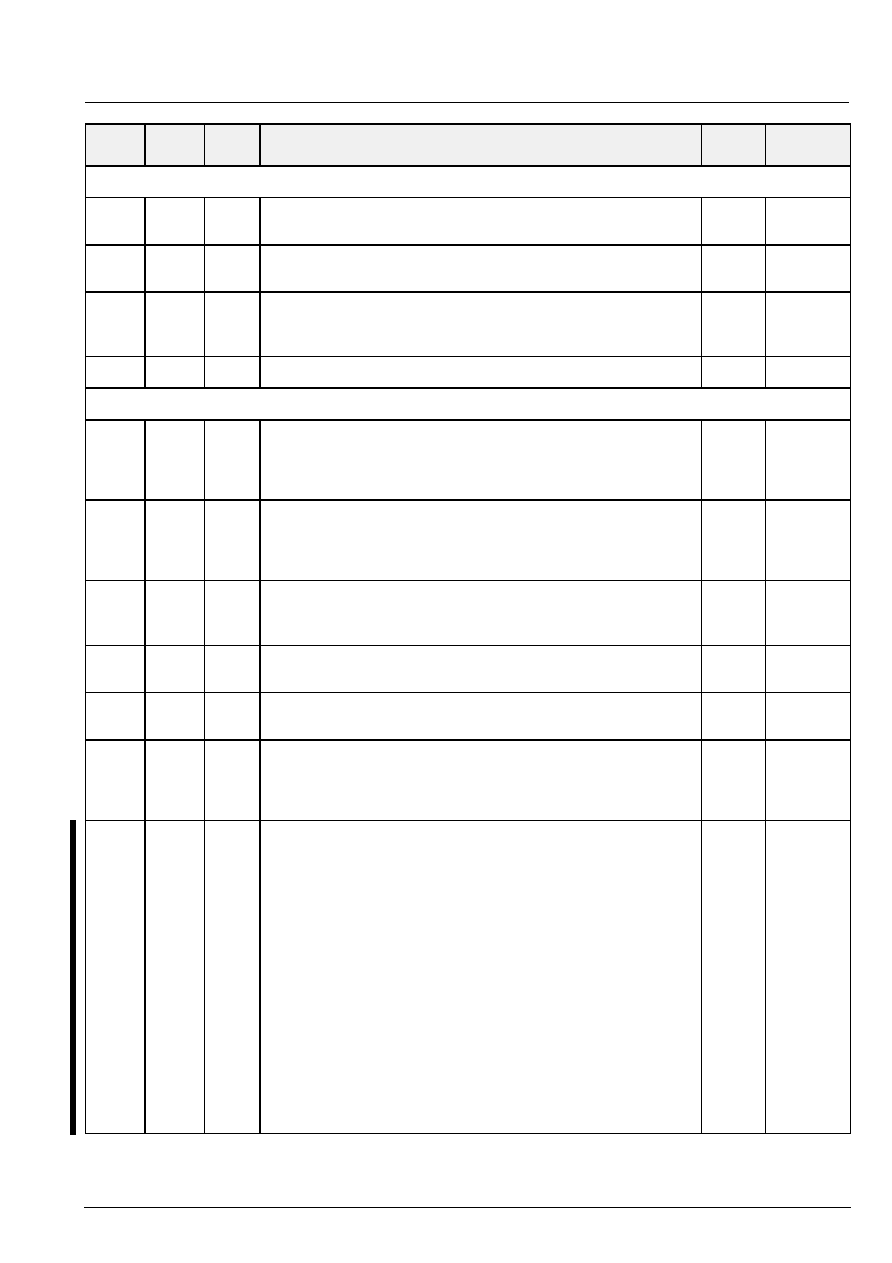
VDP 31xxB
PRELIMINARY DATA SHEET
37
Micronas
Name
Default
Function
Mode
Number
of bits
I
2
C sub
address
TIMING
h'67
9
w v
vertical blanking start
bit [8:0]
0..511
first line of vertical blanking
305
VBST
h'77
9
w v
vertical blanking stop
bit [8:0]
0..511
last line of vertical blanking
25
VBSO
h'73
9
w v
start of Black Level Expander measurement
bit [8:0]
0..511
first line of measurement, stop with first
line
of vertical blanking
30
AVST
h'5f
9
w v
bit [8:0] free running field period = (value
)
4) lines
0
STIMP
HORIZONTAL DEFLECTION
h'7a
9
w v
adjustable delay of PLL2, clamping, and blanking (relative to
front sync)
adjust clamping pulse for analog RGB input
bit [8:0]
≠256..+255
"
8
µ
s
≠141
POFS2
h'76
9
w v
adjustable delay of flyback, main sync, csync and analog RGB
(relative to PLL2)
adjust horizontal drive or csync
bit [8:0]
≠256..+255
"
8
µ
s
0
POFS3
h'7e
9
w v
adjustable delay of main sync (relative to flyback)
adjust horizontal position for digital picture
bit [8:0]
20 steps
+
1
µ
s
120
HPOS
h'5b
9
w/r
start of horizontal blanking
bit [8:0]
0..511
1
HBST
h'57
9
w/r
end of horizontal blanking
bit [8:0]
0..511
48
HBSO
h'6a
h'6e
h'72
9
9
9
w v
w v
w v
PLL2/3 filter coefficients, 1of5 bit code (n
+
set bit number)
bit [5:0]
proportional coefficient PLL3, 2
≠n≠1
bit [5:0]
proportional coefficient PLL2, 2
≠n≠1
bit [5:0]
integral coefficient PLL2, 2
≠n≠5
2
1
2
PKP3
PKP2
PKI2
h'15
16
w/r
horizontal drive and vertical signal control register
bit [5:0]
0..63
horizontal drive pulse duration in
m
s
(internally limited to 4..61)
bit [6]
0/1
disable/enable horizontal PLL2 and PLL3
bit [7]
0/1
1: disable horizontal drive pulse during
flyback
bit [8]
0/1
reserved, set to '0'
bit [9]
0/1
enable/disable ultra black blanking
bit [10]
0/1
0: all outputs blanked
1: normal mode
bit [11]
0/1
enable/disable clamping for analog RGB
input
bit [12]
0/1
disable/enable vertical free running mode
(FIELD is set to field2, no interlace)
bit [13]
0/1
enable/disable vertical protection
bit [14]
0/1
internal/external (under VPC control)
start of vertical and E/W signal
bit [15]
0/1
disable/enable phase shift of display clock
32
0
0
0
1
0
0
0
0
1
HDRV
EHPLL
EFLB
DUBL
EBL
DCRGB
SELFT
DVPR
XDEFL
DISKA

VDP 31xxB
PRELIMINARY DATA SHEET
38
Micronas
Name
Default
Function
Mode
Number
of bits
I
2
C sub
address
OUTPUT PINS
h'10
8
w/r
output pin configuration
bit [2:0]
pin driver strength, MSY and CSY
7 = tristate
6 = minimum strength
0 = maximum strength
bit [4:3]
reserved (set to 0)
bit [5]
0/1
disable/enable internal resistor for
vertical and East/West drive output
bit [7:6]
function of CSY pin :
00
composite sync signal output
01
25 Hz output (field1/field2 signal)
10
no interlace (field 2), output = 0
11
1 MHz horizontal drive clock
0
PSTSY
VEWXR
CSYM
MISCELLANEOUS
h'32
8
w/r
fast blank interface mode
bit [0]
0
internal fast blank 1 from FBLIN1 pin
1
force internal fast blank 1 signal to high
bit [1]
0/1
internal fast blank active high/low
bit [2]
0/1
disable/enable clamping reference for
RGB outputs
bit [3]
1
full line MADC measurement window,
disables bit [3] in address h'25
bit [4]
0/1
horizontal flyback input active high/low
bit [6:5]
reserved (set to 0)
bit [7]
0
internal fast blank 1 from FBLIN1 pin
1
force internal fast blank 1 signal to low
0
FBMOD
FBFOH1
FBPOL
CLMPR
FLMW
FLPOL
FBFOL1
h'31
8
w/r
fast blank interface mode 2
bit [0]
0
internal fast blank 2 from FBLIN2 pin
1
force internal fast blank 2 signal to high
bit [1]
0
internal fast blank 2 from FBLIN2 pin
1
force internal fast blank 2 signal to low
bit [2]
fast blank input priority
0
FBLIN1 > FBLIN2
1
FBLIN1 < FBLIN2
bit [3]
fast blank monitor input select
0
monitor connected to FBLIN1 pin
1
monitor connected to FBLIN2 pin
bit [4]
half contrast switch enable
0
PORT0 enable / HCS disable
1
PORT0 disable / HCS enable
bit [5]
0
half contrast from HCS pin
1
force half contrast signal to high
bit [6]
0/1
half contrast active high/low at HCS pin
bit [7]
reserved (set to 0)
0
FBMOD2
FBFOH2
FBFOL2
FBPRIO
FBMON
HCSEN
HCSFOH
HCSPOL
h'34
16
w/r
IO Port
bit [6:0]
data to/from PORT[6:0]
bit [7]
front sync output at PORT1
0
PORT1 input/output enable
1
FSY output enable
bit [14:8]
port direction
0
switch PORT[bit≠8] to input
1
switch PORT[bit≠8] to output
bit [15]
port enable
0
COLOR[4:0] enable / PORT[6:2] disable
1
COLOR[4:0] disable / PORT[6:2] enable
0
IOPORT
IODATA
FSYOEN
IODIR
IOEN

PRELIMINARY DATA SHEET
VDP 31xxB
39
Micronas
Table 3≠3: Control Registers of the Fast Processor for control of front-end functions
≠ default values are initialized at reset
FP Sub-
address
Function
Default
Name
Standard Selection
h'20
Standard select:
bit[2:0]
standard
0
PAL B,G,H,I (50 Hz)
4.433618
1
NTSC M
(60 Hz)
3.579545
2
SECAM
(50 Hz)
4.286
3
NTSC44
(60 Hz)
4.433618
4
PAL M
(60 Hz)
3.575611
5
PAL N
(50 Hz)
3.582056
6
PAL 60
(60 Hz)
4.433618
7
NTSC COMB (60 Hz)
3.579545
bit[3]
0/1 standard
modifier
PAL modified to simple PAL
NTSC modified to compensated NTSC
SECAM modified to monochrome 625
NTSCC modified to monochrome 525
bit[4]
reserved (set to 0)
bit[5]
0/1
2-H comb filter off/on
bit[6]
0/1
S-VHS mode off/on
Option bits allow to suppress parts of the initialization, this can be used
for color standard search:
bit[7]
no hpll setup
bit[8]
no vertical setup
bit[9]
no acc setup
bit[10]
2-H comb filter set-up only
bit[11]
status bit, normally write 0. After the FP has switched to a
new standard, this bit is set to 1 to indicate operation
complete. Standard is automatically initialized when the
insel register is written.
0
sdt
pal
ntsc
secam
ntsc44
palm
paln
pal60
ntscc
sdtmod
comb
svhs
sdtopt
h'22
picture start position, this register sets the start point of active video, this
can be used e.g. for panning. The setting is updated when 'sdt' register
is updated.
0
sfif
h'23
luma/chroma delay adjust. The setting is updated when 'sdt' register is
updated.
bit[5:0]
reserved, set to zero
bit[11:6]
luma delay in clocks, allowed range is +1 ... ≠7
0
ldly

VDP 31xxB
PRELIMINARY DATA SHEET
40
Micronas
Name
Default
Function
FP Sub-
address
Standard Selection
h'21
Input select:
writing to this register will also initialize the standard
bit[1:0]
luma selector
00
VIN3
01
VIN2
10
VIN1
11
VIN4
bit[2]
chroma selector
0/1
VIN1/CIN
bit[4:3]
IF compensation
00
off
01
6 dB/Okt
10
12 dB/Okt
11
10 dB/MHz only for SECAM
bit[6:5]
chroma bandwidth selector
00
narrow
01
normal
10
broad
11
wide
bit[7]
0/1
adaptive/fixed SECAM notch filter
bit[8]
0/1
enable luma lowpass filter
bit[10:9]
hpll speed
00
no change
01
terrestrial
10
vcr
11
mixed
bit[11]
status bit, write 0, this bit is set to 1 to indicate
operation complete.
00
1
00
01
insel
vis
cis
ifc
cbw
fntch
lowp
hpllmd
Comb Filter
h'27
comb filter control register
bit[0]
0
comb coefficients are calculated for luma/chroma
1
comb coefficients for luma are used for luma and
chroma
bit[1]
0
luma comb strength depends on signal amplitude
1
luma comb strength is independent of amplitude
bit[2]
0
reduced comb booster
1
max comb booster
bit[4:3]
0..3
comb strength for chroma signal
bit[6:5]
0..3
comb strength for luma signal
bit[11:7]
0..31 overall limitation of the calculated comb coefficients
0
no limitation
31
max limitation (1/2)
0
0
1
3
2
0
cmb_uc
cc
daa
kb
kc
ky
clim
Color Processing
h'39
amplitude killer level (0:killer disabled)
25
kilvl
h'3a
amplitude killer hysteresis
5
kilhy
h'dc
NTSC tint angle,
±
512 =
±
/4
0
tint

PRELIMINARY DATA SHEET
VDP 31xxB
41
Micronas
Name
Default
Function
FP Sub-
address
DVCO
h'f8
crystal oscillator center frequency adjust, ≠2048 ... 2047
≠720
dvco
h'f9
crystal oscillator center frequency adjustment value for line lock mode,
true adjust value is DVCO ≠ ADJUST.
For factory crystal alignment, using standard video signal:
set DVCO = 0, set lock mode, read crystal offset from ADJUST register
and use negative value for initial center frequency adjustment via DVCO.
read only
adjust
h'f7
crystal oscillator line-locked mode, lock command/status
write: 100
enable lock
0
disable lock
read: 0
unlocked
>2047
locked
0
xlck
FP Status Register
h'12
general purpose control bits
bit[2:0]
reserved, do not change
bit[3]
vertical standard force
bit[8:4]
reserved, do not change
bit[9]
disable flywheel interlace
bit[11:10]
reserved, do not change
to enable vertical free run mode set vfrc to 1 and dflw to 0
0
1
vfrc
dflw
h'13
standard recognition status
bit[0]
1
vertical lock
bit[1]
1
horizontally locked
bit[2]
1
no signal detected
bit[3]
1
color amplitude killer active
bit[4]
1
disable amplitude killer
bit[5]
1
color ident killer active
bit[6]
1
disable ident killer
bit[7]
1
interlace detected
bit[8]
1
no vertical sync detection
bit[9]
1
spurious vertical sync detection
bit[11:10]
reserved
≠
asr
h'cb
number of lines per field, P/S: 312, N: 262
read only
nlpf
h'15
vertical field counter, incremented per field
vcnt
h'74
measured sync amplitude value, nominal: 768 (PAL), 732 (NTSC)
read only
sampl
h'31
measured burst amplitude
read only
bampl
h'f0
firmware version number
bit[7:0]
internal revision number
bit[11:8]
firmware release
read only
sw_version
h'f1
hardware version number
bit[7:0]
internal hardware revision number
bit[11:8]
hardware id
0000 = VDP 3120B
1000 = VDP 3116B
0100 = VDP 3112B
1100 = VDP 3108B
1110 = VDP 3104B
read only
hw_version

VDP 31xxB
PRELIMINARY DATA SHEET
42
Micronas
Name
Default
Function
FP Sub-
address
Scaler Control Register
h'40
scaler mode register
bit[1:0]
scaler mode
0
linear scaling mode
1
nonlinear scaling mode, 'panorama'
2
nonlinear scaling mode, 'waterglass'
3
reserved
bit[10:2]
reserved, set to 0
bit[11]
scaler update
0
start scaler update command,
when the registers are updated the bit is set to 1
0
scmode
pano
h'41
luma offset register
bit[6:0]
luma offset 0..127
ITU-R output format:
57
CVBS output format:
4
this register is updated when the scaler mode register is written
57
yoffs
h'42
active video length for 1-h FIFO
bit[11:0]
length in pixels
this register is updated when the scaler mode register is written
1080
fflim
h'43
scaler1 coefficient, this scaler is compressing the signal.
For compression by a factor c the value c*1024 is required.
bit[11:0]
allowed values from 1024..4095
this register is updated when the scaler mode register is written
1024
scinc1
h'44
scaler2 coefficient, this scaler is expanding the signal.
For expansion by a factor c the value 1/c*1024 is required.
bit[11:0]
allowed values from 256..1024
this register is updated when the scaler mode register is written
1024
scinc2
h'45
scaler1/2 nonlinear scaling coefficient
this register is updated when the scaler mode register is written
0
scinc
h'47 ≠
h'4b
scaler1 window controls, see table
5 12-bit registers for control of the nonlinear scaling
this register is updated when the scaler mode register is written
0
scw1_0 ≠ 4
h'4c ≠
h'50
scaler2 window controls see table
5 12-bit registers for control of the nonlinear scaling
this register is updated when the scaler mode register is written
0
scw2_0 ≠ 4

PRELIMINARY DATA SHEET
VDP 31xxB
43
Micronas
3.2.1. Scaler Adjustment
In case of linear scaling, most of the scaler registers
need not be set. Only the scaler mode, active video
length, and the fixed scaler increments (scinc1/scinc2)
must be written.
The adjustment of the scaler for nonlinear scaling
modes should use the parameters given in Table 3≠4.
Table 3≠4: Set-up values for nonlinear scaler modes
Register
Scaler Modes
`waterglass'
border 35%
`panorama'
border 30%
center compression
3/4
5/6
4/3
6/5
scinc1
1643
1427
1024
1024
scinc2
1024
1024
376
611
scinc
90
56
85
56
fflim
945
985
921
983
scw1 ≠ 0
110
115
83
94
scw1 ≠ 1
156
166
147
153
scw1 ≠ 2
317
327
314
339
scw1 ≠ 3
363
378
378
398
scw1 ≠ 4
473
493
461
492
scw2 ≠ 0
110
115
122
118
scw2 ≠ 1
156
166
186
177
scw2 ≠ 2
384
374
354
363
scw2 ≠ 3
430
425
418
422
scw2 ≠ 4
540
540
540
540

VDP 31xxB
PRELIMINARY DATA SHEET
44
Micronas
Table 3≠5: Control Registers of the Fast Processor for control of back-end functions
≠ default values are initialized at reset
FP Sub-
address
Function
Default
Name
FP Display Control Register
h'130
White Drive Red
(0...1023)
700
WDR
1)
h'131
White Drive Green (0...1023)
700
WDG
1)
h'132
White Drive Blue (0...1023)
700
WDB
1)
h'139
Internal Brightness, Picture (0...511), the center value is 256, the range
allows for both increase and reduction of brightness.
256
IBR
h'13c
Internal Brightness, Measurement (0...511), the center value is 256, the
brightness for measurement can be set to measure at higher cutoff cur-
rent. The measurement brightness is independent of the drive values.
256
IBRM
h'13a
Analog Brightness for external RGB (0...511), the center value is 256, the
range allows for both increase and reduction of brightness.
256
ABR
h'13b
Analog Contrast for external RGB (0...511)
350
ACT
1)
The white drive values will become active only after writing the blue value WDB, latching of new values is indicated
by setting the MSB of WDB.
FP Display Control Register, BCL
h'144
BCL threshold current, 0...2047 (max ADC output ~1152)
1000
BCLTHR
h'142
BCL time constant 0...15
13 ... 1700 msec
15
BCLTM
h'143
BCL loop gain. 0..15
0
BCLG
h'145
BCL minimum contrast 0...1023
307
BCLMIN
h'105
Test register for BCL/EHT comp. function, register value:
0
normal operation
1
stop ADC offset compensation
x>1
use x in place of input from Measurement ADC
0
BCLTST
FP Display Control Register, Deflection
h'103
interlace offset, ≠2048..2047
This value is added to the SAWTOOTH output during one field.
0
INTLC
h'102
discharge sample count for deflection retrace,
SAWTOOTH DAC output impedance is reduced for DSCC lines after ver-
tical retrace.
7
DSCC
h'11f
vertical discharge value,
SAWTOOTH output value during discharge operation, typically same as
A0 init value for sawtooth.
≠1365
DSCV
h'10b
EHT (electronic high tension) compensation coefficient, 0...511
0
EHT
h'10a
EHT time constant. 0..15 ≠≠> 3.2..410 msec
15
EHTTM
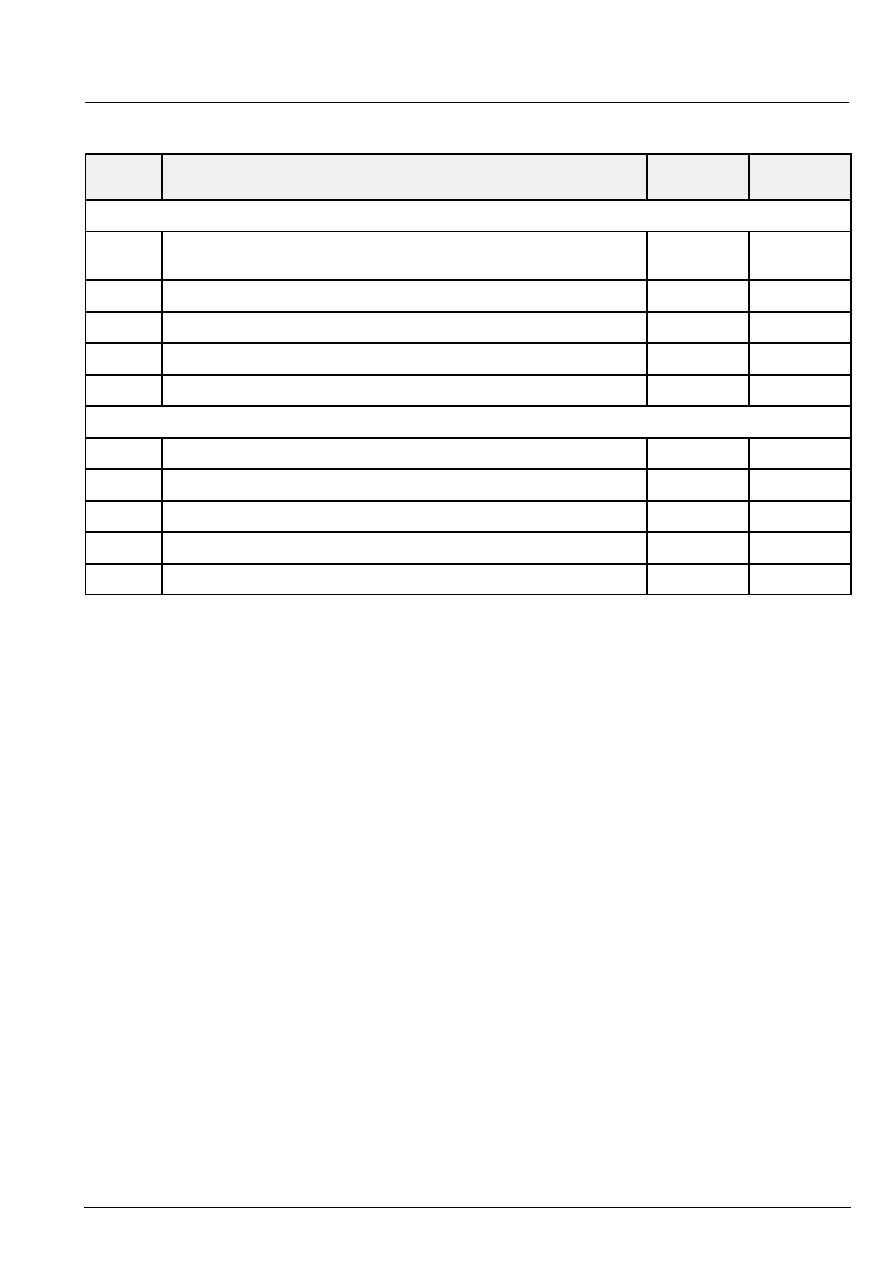
PRELIMINARY DATA SHEET
VDP 31xxB
45
Micronas
Control Registers, continued
FP Sub-
address
Function
Default
Name
FP Display Control Register, Vertical Sawtooth
h'110
DC offset of SAWTOOTH output
This offset is independent of EHT compensation.
0
OFS
h'11b
accu0 init value
≠1365
A0
h'11c
accu1 init value
900
A1
h'11d
accu2 init value
0
A2
h'11e
accu3 init value
0
A3
FP Display Control Register, East-West Parabola
h'12b
accu0 init value
≠1121
A0
h'12c
accu1 init value
219
A1
h'12d
accu2 init value
479
A2
h'12e
accu3 init value
≠1416
A3
h'12f
accu4 init value
1052
A4

VDP 31xxB
PRELIMINARY DATA SHEET
46
Micronas
3.2.2. Calculation of Vertical and East-West
Deflection Coefficients
In Table 3≠6 the formula for the calculation of the deflec-
tion initialization parameters from the polynomial coeffi-
cients a,b,c,d,e is given for the vertical and East-West
deflection. Let the polynomial be
P : a
) b(x
*
0.5)
) c(x * 0.5)
2
) d(x * 0.5)
3
) e(x * 0.5)
4
The initialization values for the accumulators a0..a3 for
vertical deflection and a0..a4 for East-West deflection
are 12-bit values. The coefficients that should be used
to calculate the initialization values for different field fre-
quencies are given below, the values must be scaled by
128, i.e. the value for a0 of the 50 Hz vertical deflection
is
a0
+ (a * 128 * b * 1365.3 ) c * 682.7 * d * 682.7) 128
Table 3≠6: Tables for the Calculation of Initialization values for Vertical Sawtooth and East-West Parabola
Vertical Deflection 50 Hz
a
b
c
d
a0
128
≠1365.3
+682.7
≠682.7
a1
899.6
≠904.3
+1363.4
a2
296.4
898.4
a3
585.9
Vertical Deflection 60 Hz
a
b
c
d
a0
128
≠1365.3
+682.7
≠682.7
a1
1083.5
≠1090.2
+1645.5
a2
429.9
≠1305.8
a3
1023.5
East-West Deflection 50 Hz
a
b
c
d
e
a0
128
≠341.3
1365.3
≠85.3
341.3
a1
111.9
≠899.6
84.8
≠454.5
a2
586.8
≠111.1
898.3
a3
72.1
≠1171.7
a4
756.5
East-West Deflection 60 Hz
a
b
c
d
e
a0
128
≠341.3
1365.3
≠85.3
341.3
a1
134.6
≠1083.5
102.2
≠548.4
a2
849.3
≠161.2
1305.5
a3
125.6
≠2046.6
a4
1584.8
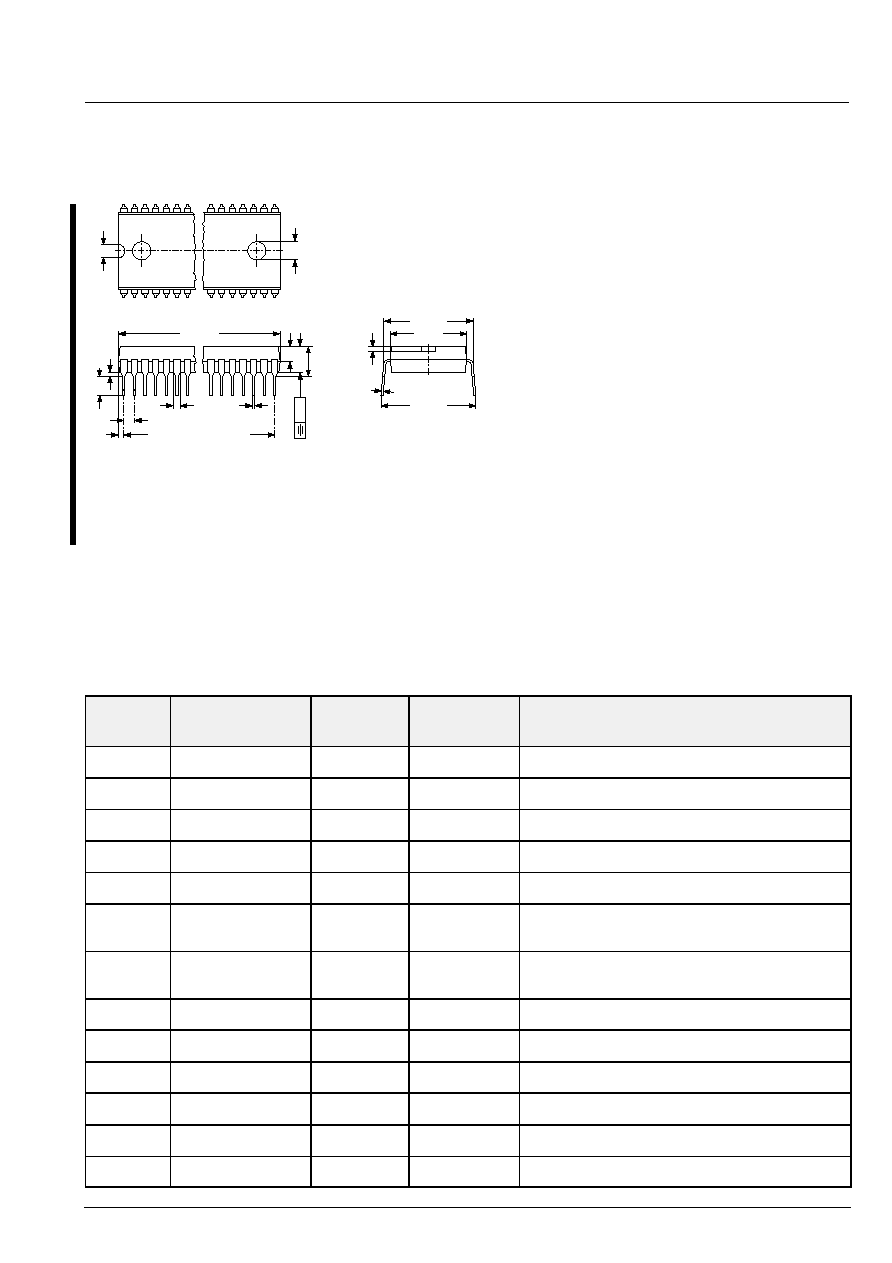
PRELIMINARY DATA SHEET
VDP 31xxB
47
Micronas
4. Specifications
4.1. Outline Dimensions
Fig. 4≠1:
64-Pin Plastic Shrink Dual-Inline Package
(PSDIP64)
Weight approximately 9.0 g
Dimensions in mm
0.457
1.29
1
32
33
64
3
0.3
1.9
(1)
1.778
±
0.05
1
±
0.1
57.7
±
0.1
3.2
±
0.4
3.8
±
0.1
4.8
±
0.4
19.3
±
0.1
18
±
0.1
20.1
±
0.5
0.27
±
0.06
SPGS0016-4/3E
31 x 1.778 = 55.118
±
0.1
2.5
0.3
4.2. Pin Connections and Short Descriptions
NC = not connected; leave vacant
LV = if not used, leave vacant
X = obligatory; connect as described in circuit diagram
Pin No.
Pin Name
Type
Connection
Short Description
(if not used)
1
TEST
IN
GND
DF
Test Pin, reserved for Test
2
RESQ
IN
X
Reset Input, Active Low
3
SCL
IN/OUT
X
I
2
C Bus Clock
4
SDA
IN/OUT
X
I
2
C Bus Data
5
DSGND
X
Digital Shield GND
D
6
PORT0
HCS
IN/OUT
LV
IO Port Expander 0
/ Half Contrast Switch
7
PORT1
FSY
IN/OUT
LV
IO Port Expander 1
/ Front Sync Output
8
CSY
OUT
LV
Composite Sync Output
9
MSY
OUT
LV
Main Sync Output
10
INTLC
OUT
LV
Interlace Control Output
11
VPROT
IN
GND
O
Vertical Protection Input
12
SAFETY
IN
GND
O
Safety Input
13
HFLB
IN
HOUT
Horizontal Flyback Input
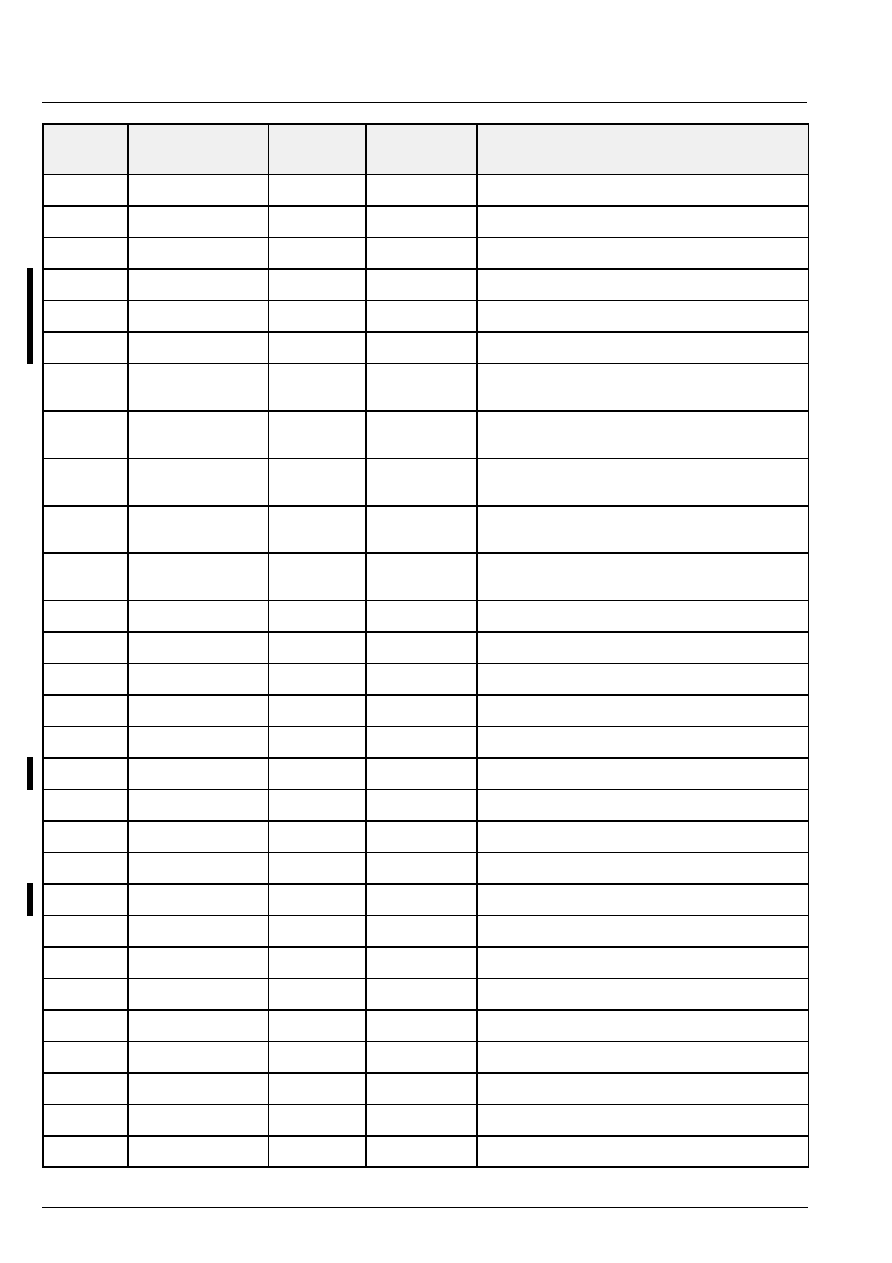
VDP 31xxB
PRELIMINARY DATA SHEET
48
Micronas
Short Description
Connection
Type
Pin Name
Pin No.
(if not used)
14
GND
DF
X
Ground, Digital Circuitry Front-end
15
VSUP
D
X
Supply Voltage, Digital Circuitry
16
GND
DO
X
Ground, Digital Circuitry Back-end
17
PR0
IN/OUT
LV
Picture Bus Priority Control (LSB)
18
PR1
IN/OUT
LV
Picture Bus Priority Control
19
PR2
IN/OUT
LV
Picture Bus Priority Control (MSB)
20
COLOR4
PORT2
IN/OUT
GND
DF
Picture Bus Color Address 4
/ IO Port Expander 2
21
COLOR3
PORT3
IN/OUT
GND
DF
Picture Bus Color Address 3
/ IO Port Expander 3
22
COLOR2
PORT4
IN/OUT
GND
DF
Picture Bus Color Address 2
/ IO Port Expander 4
23
COLOR1
PORT5
IN/OUT
GND
DF
Picture Bus Color Address 1
/ IO Port Expander 5
24
COLOR0
PORT6
IN/OUT
GND
DF
Picture Bus Color Address 0
/ IO Port Expander 6
25
DSGND
X
Digital Shield GND
D
26
RSW2
OUT
GND
O
Range Switch2 for Measurement ADC
27
RSW1
OUT
GND
O
Range Switch1 for Measurement ADC
28
SENSE
IN
GND
O
Sense ADC Input
29
GND
M
X
Ground, MADC Input
30
GND
V
OUT
LV
Ground, Vertical Outputs
31
VERT
OUT
LV
Vertical Sawtooth Output
32
EW
OUT
LV
Vertical Parabola Output
33
XREF
IN
X
Reference Input for RGB DACs
34
SVMOUT
OUT
VSUP
O
Scan Velocity Modulation Output
35
GND
O
X
Ground, Analog Back-end
36
VSUP
O
X
Supply Voltage, Analog Back-end
37
ROUT
OUT
VSUP
O
Analog Red Output
38
GOUT
OUT
VSUP
O
Analog Green Output
39
BOUT
OUT
VSUP
O
Analog Blue Output
40
VRD
IN
X
DAC Reference
41
RIN
IN
GND
O
Analog Red Input
42
GIN
IN
GND
O
Analog Green Input

PRELIMINARY DATA SHEET
VDP 31xxB
49
Micronas
Short Description
Connection
Type
Pin Name
Pin No.
(if not used)
43
BIN
IN
GND
O
Analog Blue Input
44
FBLIN
IN
GND
O
Fast Blank Input
45
RIN2
IN
GND
O
Analog Red Input 2
46
GIN2
IN
GND
O
Analog Green Input 2
47
BIN2
IN
GND
O
Analog Blue Input 2
48
FBLIN2
IN
GND
O
Fast Blank Input 2
49
CLK20
OUT
LV
20 MHz System Clock Output
50
HOUT
OUT
X
Horizontal Drive Output
51
XTAL1
IN
X
Analog Crystal Input
52
XTAL2
OUT
X
Analog Crystal Output
53
VSTBY
X
Standby Supply Voltage
54
CLK5
OUT
LV
5 MHz Clock Output
55
GND
F
X
Ground, Analog Front-end
56
ISGND
IN
GND
F
Signal Ground for Analog Input
57
VRT
IN
X
Reference Voltage Top, Video ADC
58
VSUP
F
X
Supply Voltage, Analog Front-end
59
VOUT
OUT
LV
Analog Video Output
60
CIN
IN
VRT
Analog Chroma Input
61
VIN1
IN
VRT
Analog Video 1 Input
62
VIN2
IN
VRT
Analog Video 2 Input
63
VIN3
IN
VRT
Analog Video 3 Input
64
VIN4
IN
VRT
Analog Video 4 Input
4.3. Pin Descriptions
Pin 1 ≠ Test Input, TEST (Fig. 4≠3)
This pin enables factory test modes. For normal opera-
tion it must be connected to ground.
Pin 2 ≠ Reset Input, RESQ (Fig. 4≠3)
A low level on this pin resets the VDP 31xxB.
Pin 3 ≠ I
2
C Bus Clock, SCL (Fig. 4≠12)
This pin connects to the I
2
C bus clock line.
Pin 4 ≠ I
2
C Bus Data, SDA (Fig. 4≠12)
This pin connects to the I
2
C bus data line.
Pin 5 ≠ Ground (Digital Shield), DSGND
Pin 6, 7, 20≠24 ≠ IO Port Expander, PORT[6:0] (Fig.
4≠13)
These pins provide an I
2
C programmable I/O port, which
can be used to read and write slow external signals.

VDP 31xxB
PRELIMINARY DATA SHEET
50
Micronas
Pin 6 ≠ Half Contrast Switch Input, HCS (Fig. 4≠16)
Via this input pin the output level of the analog RGB out-
put pins can be reduced by 3dB.
Pin 7 ≠ Front Sync Output, FSY (Fig. 4≠13)
This pin supplies the front sync information
Pin 8 ≠ Composite Sync Output, CSY (Fig. 4≠13)
This output supplies a standard composite sync signal
that is compatible to the analog RGB output signals.
Pin 9 ≠ Main Sync Output, MSY (Fig. 4≠13)
This pin supplies the main sync information.
Pin 10 ≠ Interlace Output, INTLC (Fig. 4≠13)
This pin supplies the interlace information, 0 indicates
first field, 1 indicates second field.
Pin 11 ≠ Vertical Protection Input, VPROT (Fig. 4≠14)
The vertical protection circuitry prevents the picture tube
from burn-in in the event of a malfunction of the vertical
deflection stage. During vertical blanking, a signal level
of 2.5V is sensed. If a negative edge cannot be detected,
the RGB output signals are blanked.
Pin 12 ≠ Safety Input, SAFETY (Fig. 4≠14)
This is a three-level input. Low level means normal func-
tion. At the medium level RGB signals are blanked and
at high level RGB signals are blanked and horizontal
drive is shut off.
Pin 13 ≠ Horizontal Flyback Input, HFLB (Fig. 4≠14)
Via this pin the horizontal flyback pulse is supplied to the
VDP 31xxB.
Pin 14 ≠ Ground (Digital Circuitry Front-end), GND
DF
Pin 15 ≠ Supply Voltage (Digital Circuitry), VSUP
D
Pin 16 ≠ Ground (Digital Circuitry Back-end), GND
DO
Pin 17, 18, 19 ≠ Picture Bus Priority, PR[2:0] (Fig. 4≠5)
The Picture Bus Priority lines carry the digital priority
selection signals. The priority interface allows digital
switching of up to 8 sources to the backend processor.
Switching for different sources is prioritized and can be
done from pixel to pixel.
Pin 20...24 ≠ Picture Bus Color Address, COLOR[4:0]
(Fig. 4≠16)
The Picture Bus COLOR lines carry the digital RGB col-
or data. They are used as address for the color lookup
table.
Pin 25 ≠ Ground (Digital Shield), DSGND.
Pin 26, 27 ≠ Range Switch for Measurement ADC,
RSW1, RSW2 (Fig. 4≠19)
These pins are open drain pull-down outputs. RSW1 is
switched off during cutoff and whitedrive measurement.
RSW2 is switched off during cutoff measurement only.
Pin 28 ≠ Measurement ADC Input, SENSE (Fig. 4≠15)
This is the input of the analog digital converter for the
picture and tube measurement.
Pin 29 ≠ Ground (Measurement ADC Reference Input),
GND
M
This is the ground reference for the measurement A/D
converter.
Pin 30 ≠ Ground (Vertical Sawtooth Output), GND
V
(Fig.
4≠20)
This is the ground reference for the vertical outputs.
Pin 31 ≠ Vertical Sawtooth Output, VERT (Fig. 4≠20)
This pin supplies the drive signal for the vertical output
stage. The drive signal is generated with 15-bit precision
by the Fast Processor in the front-end. The analog volt-
age is generated by a 4-bit current-DAC with external re-
sistor and uses digital noise shaping.
Pin 32 ≠ East-West Parabola Output, EW (Fig. 4≠20)
This pin supplies the parabola signal for the East-West
correction. The drive signal is generated with 15 bit pre-
cision by the Fast Processor in the front-end. The analog
voltage is generated by a 4-bit current-DAC with exter-
nal resistor and uses digital noise shaping.
Pin 33 ≠ DAC Current Reference, XREF (Fig. 4≠21)
External reference resistor for DAC output currents, typi-
cal 10 k
to adjust the output current of the D/A convert-
ers (see recommended operating conditions). This re-
sistor has to be connected to analog ground as closely
as possible to the pin.
Pin 34 ≠ Scan Velocity Modulation Output, SVMOUT
(Fig. 4≠17)
This output delivers the analog SVM signal. The D/A
converter is a current sink like the RGB D/A converters.
At zero signal the output current is 50% of the maximum
output current.
Pin 35 ≠ Ground (Analog Back-end), GND
O
Pin 36 ≠ Supply Voltage (Analog Back-end), VSUP
O
Pin 37, 38, 39 ≠ Analog RGB Outputs, ROUT, GOUT,
BOUT (Fig. 4≠17)
This are the analog Red/Green/Blue outputs of the back-
end. The outputs sink a current of max. 8mA.
Pin 40 ≠ DAC Reference Decoupling, VRD (Fig. 4≠21)
Via this pin the DAC reference voltage is decoupled by
an external capacitance. The DAC output currents de-
pend on this voltage, therefore a pull-down transistor
can be used to shut off all beam currents. A decoupling
capacitor of 3.3
µ
F//100nF is required.
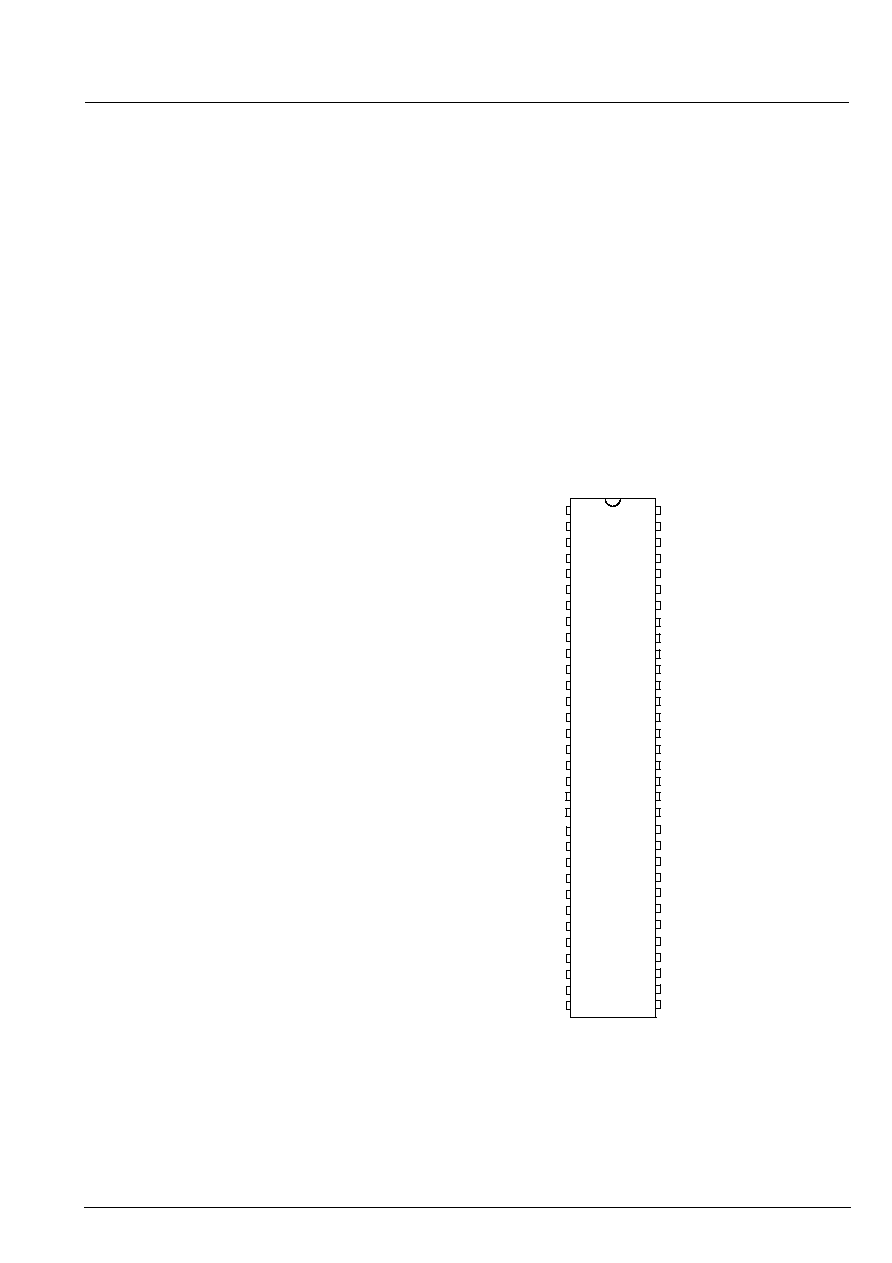
PRELIMINARY DATA SHEET
VDP 31xxB
51
Micronas
Pin 41, 42, 43, 45, 46, 47 ≠ Analog RGB Inputs, RIN1/2,
GIN1/2, BIN1/2 (Fig. 4≠15)
These pins are used to insert an external analog RGB
signal, e.g. from a SCART connector which can by
switched to the analog RGB outputs with the fast blank
signal. The analog backend provides separate bright-
ness and contrast settings for the external analog RGB
signals.
Pin 44, 48 ≠ Fast Blank Inputs, FBLIN1/2 (Fig. 4≠15)
These pins are used to switch the RGB outputs to the ex-
ternal analog RGB inputs.
Pin 49 ≠ Main Clock Output, CLK20 (Fig. 4≠4)
This is the 20.25MHz main system clock, that is used by
all circuits in a high-end VDP system. All external timing
is derived from this clock.
Pin 50 ≠ Horizontal Drive Output, HOUT (Fig. 4≠18)
This open drain output supplies the the drive pulse for
the horizontal output stage. The polarity and gating with
the flyback pulse are selectable by software.
Pin 51, 52 ≠ Crystal Input and Output, XTAL1, XTAL2
(Fig. 4≠7)
These pins are connected to an 20.25 MHz crystal oscil-
lator is digitally tuned by integrated shunt capacitances.
The Clk20 and Clk5 clock signals are derived from this
oscillator. An external clock can be fed into XTAL1. In
this case clock frequency adjustment must be switched
off.
Pin 53 ≠ Standby Supply Voltage, VSTBY
In standby mode, only the clock oscillator and the hori-
zontal drive circuitry are active.
Pin 54 ≠ CCU 5 MHz Clock Output, CLK5 (Fig. 4≠10)
This pin provides a clock frequency for the TV microcon-
troller, e.g. a CCU3000 controller.
Pin 55 ≠ Ground (Analog Front-end), GND
F
Pin 56 ≠ Ground (Analog Signal Input), ISGND (Fig. 4≠8)
This is the high quality ground reference for the video
input signals.
Pin 57 ≠ Reference Voltage Top, VRT (Fig. 4≠8)
Via this pin, the reference voltage for the A/D converters
is decoupled. The pin is connected with 10
m
F/47 nF to
the Signal Ground Pin.
Pin 58 ≠ Supply Voltage (Analog Front-end), VSUP
F
Pin 59 ≠ Analog Video Output, VOUT (Fig. 4≠6)
The analog video signal that is selected for the main
(luma, cvbs) adc is output at this pin. An emitter follower
is required at this pin.
Pin 60 ≠ Analog Chroma Input, CIN (Fig. 4≠9)
This pin is connected to the S-VHS chroma signal. A re-
sistive divider is used to bias the input signal to the
middle of the converter input range. CIN can only be
connected to the chroma (Video 2) A/D converter. The
signal must be AC-coupled.
Pin 61...64 ≠ Analog Video Input 1≠4, VIN1≠4 (Fig. 4≠11)
These are the analog video inputs. A CVBS or S-VHS
luma signal is converted using the luma (Video 1) AD
converter. The input signal must be AC-coupled.
4.4. Pin Configuration
1
2
3
4
5
6
7
8
9
10
11
12
13
14
15
16
17
18
19
20
45
46
47
48
49
50
51
52
53
54
55
56
57
58
59
60
61
62
63
64
TEST
RESQ
SCL
DSGND
PORT0/HCS
PORT1/FSY
CSY
MSY
INTLC
VPROT
SAFETY
GNDDF
VSUPD
GNDDO
PR0
PR1
PR2
COLOR4/PORT2
RIN2
VIN1
VSUPF
VRT
ISGND
CLK5
VSTBY
HFLB
GIN2
FBLIN2
VIN2
VIN3
GNDF
SDA
VOUT
CIN
VIN4
21
22
23
24
25
26
27
28
29
30
31
32
COLOR2/PORT4
COLOR1/PORT5
DSGND
RSW2
RSW1
SENSE
GNDM
GNDV
VERT
EW
COLOR0/PORT6
COLOR3/PORT3
33
34
35
36
37
38
39
40
41
42
43
44
RIN
GOUT
ROUT
VSUPO
SVMOUT
XREF
GIN
BIN
GNDO
BOUT
VRD
FBLIN
Fig. 4≠2: 64-pin PSDIP package
BIN2
CLK20
HOUT
XTAL2
XTAL1
VDP
31xxB

VDP 31xxB
PRELIMINARY DATA SHEET
52
Micronas
4.5. Pin Circuits
Fig. 4≠3: Input pins RESQ, TEST
V
SUPD
GND
D
GND
D
V
SUPD
P
N
Fig. 4≠4: Output pin CLK20
P
N
V
SUPD
N
P
N
Fig. 4≠5: Input/Output pins PR[2:0]
GND
D
Fig. 4≠6: Output pin VOUT
V
SUPF
GND
F
P
+
≠
N
V
OUT
V
in's
V
REF
GND
F
V
STBY
P
N
P
N
f
ECLK
0.5M
Fig. 4≠7: Input/Output pins XTAL1, XTAL2
V
SUPF
P
+
≠
ISGND
Fig. 4≠8: Pins VRT , ISGND
VRT
Vref
GND
F
Fig. 4≠9: Chroma input CIN
V
SUPF
To ADC
GND
F
Fig. 4≠10: Output pin CLK5
P
N
V
STBY
GND
F
V
SUPF
To ADC
Fig. 4≠11: Input pins VIN1≠VIN4
Fig. 4≠12: Pins SDA, SCL
GND
D

PRELIMINARY DATA SHEET
VDP 31xxB
53
Micronas
Fig. 4≠13: Output pins FSY, MSY, CSY, INTLC,
PORT[6:0]
P
N
V
SUPD
GNDD
P
P
N
N
V
SUPD
BIAS
Fig. 4≠14: Input pins SAFETY, VPROT, HFLB
GNDD
P
P
N
N
V
SUPO
BIAS
Fig. 4≠15: Input pins FBLIN1/2, RIN1/2, BIN1/2,
GIN1/2, SENSE
GNDO
Fig. 4≠16: Input pins COLOR[4:0], HCS,
PORT[6:0]
P
N
V
SUPD
GNDD
V
SUPO
BIAS
N
N
Fig. 4≠17: Analog output pins ROUT, GOUT,
BOUT, SVMOUT
GNDO
V
STDBY
GNDD
Fig. 4≠18: Output pin HOUT
N
GNDM
Fig. 4≠19: Output pins RSW1, RSW2
N
V
SUPO
P
P
V
SUPO
Fig. 4≠20: Output pins VERT, EW
GNDV
+
≠
int. ref.
voltage
ref. current
V
SUPO
GNDO
VRD
XREF
Fig. 4≠21: Input pins XREF, VRD

VDP 31xxB
PRELIMINARY DATA SHEET
54
Micronas
4.6. Electrical Characteristics
4.6.1. Absolute Maximum Ratings
Symbol
Parameter
Pin No.
Min.
Max.
Unit
T
A
Ambient Operating Temperature
≠
0
65
∞
C
T
S
Storage Temperature
≠
≠40
125
∞
C
V
SUP
Supply Voltage, all Supply Inputs
≠0.3
6
V
V
I
Input Voltage, all Inputs
≠0.3
V
SUP
+0.3
V
V
O
Output Voltage, all Outputs
≠0.3
V
SUP
+0.3
V
Stresses beyond those listed in the "Absolute Maximum Ratings" may cause permanent damage to the device. This
is a stress rating only. Functional operation of the device at these or any other conditions beyond those indicated in the
"Recommended Operating Conditions/Characteristics" of this specification is not implied. Exposure to absolute maxi-
mum ratings conditions for extended periods may affect device reliability.
4.6.2. Recommended Operating Conditions
Symbol
Parameter
Pin Name
Min.
Typ.
Max.
Unit
T
A
Ambient Operating Temperature
≠
0
≠
65
∞
C
V
SUP
Supply Voltages, all Supply Pins
4.75
5.0
5.25
V
f
XTAL
Clock Frequency
XTAL1/2
≠
20.25
≠
MHz
R
xref
RGB ≠ DAC Current defining Re-
sistor
XREF
9.5
10
10.5
k
W
NS
VDD
Negative Slope of VDD (power
down)
VSUPD
0.2
V/
µ
s
4.6.3. Recommended Crystal Characteristics
Symbol
Parameter
Min.
Typ.
Max.
Unit
T
A
Operating Ambient Temperature
0
≠
65
∞
C
f
P
Parallel Resonance Frequency
with Load Capacitance C
L
= 13 pF
≠
20.250000
≠
MHz
D
f
P
/f
P
Accuracy of Adjustment
≠
≠
$
20
ppm
D
f
P
/f
P
Frequency Temperature Drift
≠
≠
$
30
ppm
R
R
Series Resistance
≠
≠
25
W
C
0
Shunt Capacitance
3
≠
7
pF
C
1
Motional Capacitance
20
≠
30
fF

PRELIMINARY DATA SHEET
VDP 31xxB
55
Micronas
Recommended Crystal Characteristics, continued
Symbol
Parameter
Min.
Typ.
Max.
Unit
Load Capacitance Recommendation
C
Lext
External Load Capacitance
1)
from pins to Ground
(pin names: Xtal1 Xtal2)
≠
3.3
≠
pF
DCO Characteristics
2)
C
ICLoadmin
Effective Load Capacitance @ min.
DCO-Position, Code 0,
3.6
4.3
5
pF
C
ICLoadrng
Effective Load Capacitance Range,
DCO Codes from 0..255
11.7
12.7
13.7
pF
1)
Remarks on defining the External Load Capacitance:
External capacitors at each crystal pin to ground are required. They are necessary to tune the effective load capacitance of
the PCBs to the required load capacitance C
L
of the crystal. The higher the capacitors, the lower the clock frequency re-
sults. The nominal free running frequency should match f
p
MHz. Due to different layouts of customer PCBs the matching
capacitor size should be determined in the application. The suggested value is a figure based on experience with various
PCB layouts.
Tuning condition: Code DVCO Register = ≠720
Tuning condition: Code DVCO Register 720
2)
Remarks on Pulling Range of DCO:
The pulling range of the DCO is a function of the used crystal and effective load capacitance of the IC (C
ICLoad
+C
LoadBoard
).
The resulting frequency f
L
with an effective load capacitance of C
Leff
= C
ICLoad
+ C
LoadBoard
is
1 + 0.5 * [ C
1
/ (C
0
+ C
Leff
) ]
f
L
= f
P
* ≠≠≠≠≠≠≠≠≠≠≠≠≠≠≠≠≠≠≠≠≠≠≠
1 + 0.5 * [ C
1
/ (C
0
+ C
L
) ]
4.6.4. Characteristics
at T
A
= 0 to 65
∞
C, V
SUPD/F/O
= 4.75 to 5.25 V,
f = 20.25 MHz for min./max. values
at T
C
= 60
∞
C, V
SUPD/F/O
= 5 V, f = 20.25 MHz for typical values
Symbol
Parameter
Pin Name
Min.
Typ.
Max.
Unit
I
VSUPF
Current Consumption
V
SUPF
≠
38
≠
mA
I
VSUPD
Current Consumption
V
SUPD
≠
123
≠
mA
I
VSUPO
Current Consumption
V
SUPO
≠
64
≠
mA
I
VSTDBY
Current Consumption
V
STDBY
≠
3.3
≠
mA
P
TOT
Total Power Dissipation
≠
1145
1200
W
IL
Input / Output Leakage Current
All I/O Pins
≠1
≠
1
m
A
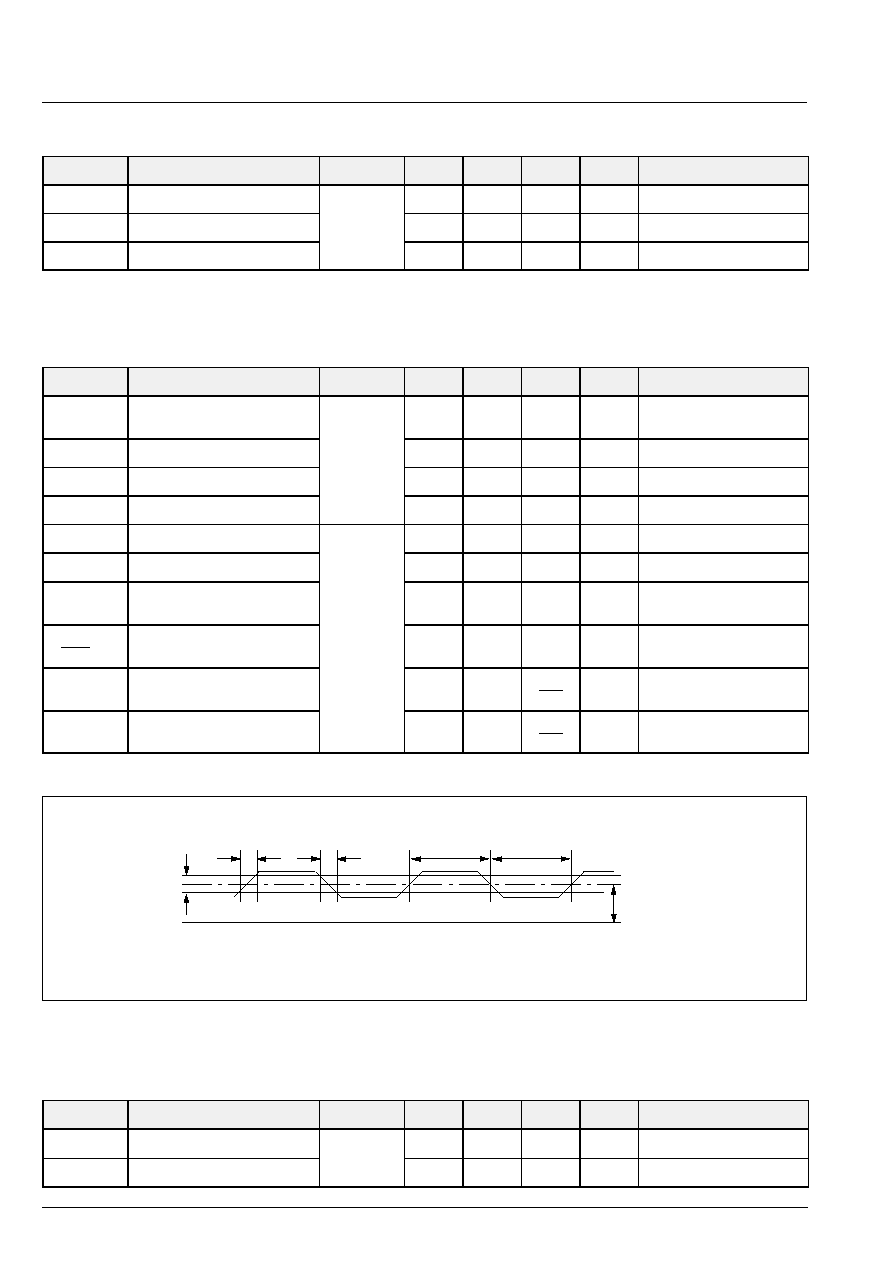
VDP 31xxB
PRELIMINARY DATA SHEET
56
Micronas
4.6.4.1. 5 MHz Clock Output
Symbol
Parameter
Pin Name
Min.
Typ.
Max.
Unit
Test Conditions
V
OL
Output Low Voltage
CLK5
≠
≠
0.4
V
I
OL
= 0.4 mA
V
OH
Output High Voltage
4.0
≠
V
STDBY
V
≠I
OL
= 0.9 mA
t
OT
Output Transition Time
≠
50
≠
ns
C
LOAD
= 30 pF
4.6.4.2. 20 MHz Clock Input/Output, External Clock Input (XTAL1) (see Fig. 4≠22)
Symbol
Parameter
Pin Name
Min.
Typ.
Max.
Unit
Test Conditions
V
DCAV
DC Average
CLK20
V
SUP
/2
≠ 0.3
V
SUP
/2
V
SUP/
2
+ 0.3
V
C
LOAD
= 30 pF
V
PP
V
OUT
Peak to Peak
1.3
1.6
≠
V
C
LOAD
= 30 pF
t
OT
Output Transition Time
≠
≠
18
ns
C
LOAD
= 30 pF
V
IT
Input Trigger Level
2.1
2.5
2.9
V
only for test purposes
f
F
F
Main Clock Frequency
XTAL 1
10
20.25
24
MHz
V
F
MIDC
F
Main Clock Input DC Voltage
1.0
≠
3.5
V
V
F
MIAC
F
M Clock Input AC Voltage
(p≠p)
0.8
≠
2.5
V
t
F
MIH
t
F
MIL
F
M Clock Input High/Low Ratio
0.9
1.0
1.1
t
F
MIHL
F
M Clock Input High to Low
Transition Time
≠
≠
0.15
f
F
M
t
F
MILH
F
M Clock Input Low to High
Transition Time
≠
≠
0.15
f
F
M
0 V
V
F
MIDC
V
F
MIAC
t
F
MIHL
t
F
MIH
t
F
MI
L
t
F
MILH
DVSS
Fig. 4≠22: Main clock input
4.6.4.3. Reset Input, Test Input
Symbol
Parameter
Pin Name
Min.
Typ.
Max.
Unit
Test Conditions
V
IL
Input Low Voltage
RESQ
TEST
≠
≠
1.5
V
V
IH
Input High Voltage
TEST
3.0
≠
≠
V

PRELIMINARY DATA SHEET
VDP 31xxB
57
Micronas
4.6.4.4. I
2
C Bus Interface
Symbol
Parameter
Pin Name
Min.
Typ.
Max.
Unit
Test Conditions
V
IL
Input Low Voltage
SDA, SCL
≠
≠
1.5
V
V
IH
Input High Voltage
3.0
≠
≠
V
V
OL
Output Low Voltage
≠
≠
0.4
0.6
V
V
I
l
= 3 mA
I
l
= 6 mA
V
IH
Input Capacitance
≠
≠
4
pF
t
F
Signal Fall Time
≠
≠
300
ns
C
L
= 400 pF
t
R
Signal Rise Time
≠
≠
300
ns
C
L
= 400 pF
f
SCL
Clock Frequency
SCL
0
≠
400
kHz
t
LOW
Low Period of SCL
1.3
≠
≠
m
s
t
HIGH
High Period of SCL
0.6
≠
≠
m
s
t
SU Data
Data Set Up Time to SCL high
SDA
100
≠
≠
ns
t
HD Data
DATA Hold Time to SCL low
0
≠
0.9
m
s
4.6.4.5. IO Port Expander
Symbol
Parameter
Pin Name
Min.
Typ.
Max.
Unit
Test Conditions
V
IL
Input Low Voltage
PORT[6:0]
≠
≠
0.8
V
V
IH
Input High Voltage
1.5
≠
≠
V
V
OL
Output Low Voltage
≠
0.2
0.4
V
I
OL
= 1.6 mA,
strength 6
V
OH
Output High Voltage
V
SUPD
≠ 0.4
≠
V
SUPD
V
≠I
OL
= 1.6mA,
strength 6
t
OD
Output Transition Time
≠
≠
35
ns
C
LOAD
= 70pF
I
OL
Output Current
≠10
≠
10
mA
driver imp. = 0
4.6.4.6. Analog Video Inputs
Symbol
Parameter
Pin Name
Min.
Typ.
Max.
Unit
Test Conditions
V
VIN
Analog Input Voltage
VIN1
VIN2
VIN3
VIN4
CIN
0
≠
3.5
V
C
CP
Input Coupling Capacitor
Video Inputs
VIN1
VIN2
VIN3
VIN4
≠
680
≠
nF
C
CP
Input Coupling Capacitor
Chroma Input
CIN
≠
1
≠
nF
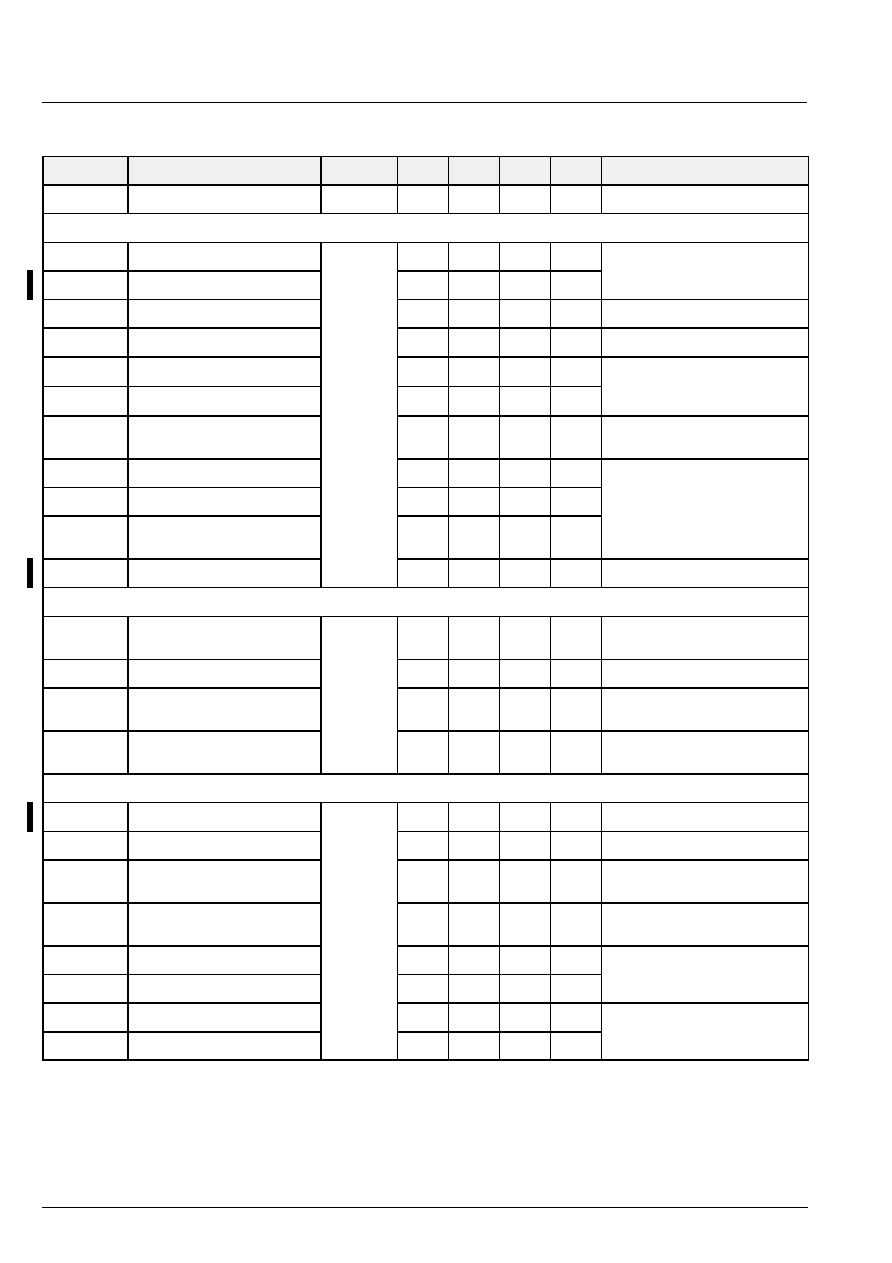
VDP 31xxB
PRELIMINARY DATA SHEET
58
Micronas
4.6.4.7. Analog Front-End and ADCs
Symbol
Parameter
Pin Name
Min.
Typ.
Max.
Unit
Test Conditions
V
VRT
Reference Voltage Top
VRT
2.5
2.6
2.8
V
10
m
F/10 nF, 1 G
W
Probe
Luma ≠ Path
R
VIN
Input Resistance
VIN1
VIN2
1
M
W
Code Clamp ≠ DAC = 0
C
VIN
Input Capacitance
VIN2
VIN3
VIN4
4.5
pF
V
VIN
Full Scale Input Voltage
VIN4
1.8
2.0
2.2
V
PP
min. AGC Gain
V
VIN
Full Scale Input Voltage
0.5
0.6
0.7
V
PP
max. AGC Gain
AGC
AGC Step Width
0.166
dB
6-Bit Resolution = 64 Steps
f
i
= 1 MHz
DNL
AGC
AGC Differential Non-Linearity
±
0.5
LSB
f
sig
= 1 MHz,
≠2 dBr of max. AGC-Gain
V
VINCL
Input Clamping Level, CVBS
1.0
V
Binary Level = 64 LSB
min. AGC Gain
Q
CL
Clamping DAC Resolution
≠16
15
steps
5 Bit ≠ I-DAC, bipolar
V
VIN
= 1 5 V
I
CL≠LSB
Input Clamping Current per Step
0.7
1.0
1.3
m
A
V
VIN
= 1.5 V
DNL
ICL
Clamping DAC Differential Non-
Linearity
±
0.5
LSB
C
ICL
Clamping-Capacity
220
≠
nF
Coupling-Cap. @ Inputs
Chroma ≠ Path
R
CIN
Input Resistance
SVHS Chroma
CIN
VIN1
1.4
2.0
2.6
k
W
V
CIN
Full Scale Input Voltage, Chroma
1.08
1.2
1.32
V
PP
V
CINDC
Input Bias Level,
SVHS Chroma
≠
1.5
≠
V
Binary Code for Open
Chroma Input
128
Dynamic Characteristics for all Video Paths (Luma + Chroma)
BW
Bandwidth
VIN1
VIN2
10
12.5
MHz
≠2 dBr input signal level
XTALK
Crosstalk, any Two Video Inputs
VIN2
VIN3
VIN4
≠56
dB
1 MHz, ≠2 dBr signal level
THD
Total Harmonic Distortion
VIN4
CIN
50
dB
1 MHz, 5 harmonics,
≠2 dBr signal level
SINAD
Signal to Noise and Distortion
Ratio
45
dB
1 MHz, all outputs,
≠2 dBr signal level
INL
Integral Non-Linearity,
±
1
LSB
Code Density,
DC ramp
DNL
Differential Non-Linearity
±
0.8
LSB
DC-ramp
DG
Differential Gain
±
3
%
≠12 dBr, 4.4 MHz signal on DC-
ramp
DP
Differential Phase
1.5
deg
ramp

PRELIMINARY DATA SHEET
VDP 31xxB
59
Micronas
Analog Front-End and ADCs, continued
Symbol
Parameter
Pin Name
Min.
Typ.
Max.
Unit
Test Conditions
Analog Video Output
V
OUT
Output Voltage
VOUT
1.7
2.0
2.3
V
PP
V
VIN
= 1 V
PP
, AGC = 0 dB
AGC
VOUT
AGC Step Width, VOUT
1.333
dB
3 Bit Resolution = 7 Steps
3 MSB's of main AGC
DNL
AGC
AGC Differential Non-Linearity
±
0.5
LSB
3 MSB's of main AGC
V
OUTDC
DC-Level
1
V
clamped to back porch
BW
V
OUT
Bandwidth
10
MHz
Input: ≠2 dBr of main ADC range,
C
L
10 pF
THD
V
OUT
Total Harmonic Distortion
≠45
≠40
dB
Input: ≠2 dBr of main ADC range,
C
L
10 pF
1 MHz, 5 Harmonics
C
LVOUT
Load Capacitance
≠
≠
10
pF
I
LVOUT
Output Current
≠
≠
±
0.1
mA
4.6.4.8. Picture Bus Input (see Fig. 4≠23)
Symbol
Parameter
Pin Name
Min.
Typ.
Max.
Unit
Test Conditions
V
IL
Input Low Voltage
PR[2:0]
COL
≠
≠
0.8
V
V
IH
Input High Voltage
COL-
OR[4:0]
1.5
≠
≠
V
t
IS
Input Setup Time
7
≠
≠
ns
t
IH
Input Hold Time
5
≠
≠
ns
Data Inputs
Main Clock
t
IS
t
IH
Fig. 4≠23: Picture bus input timing
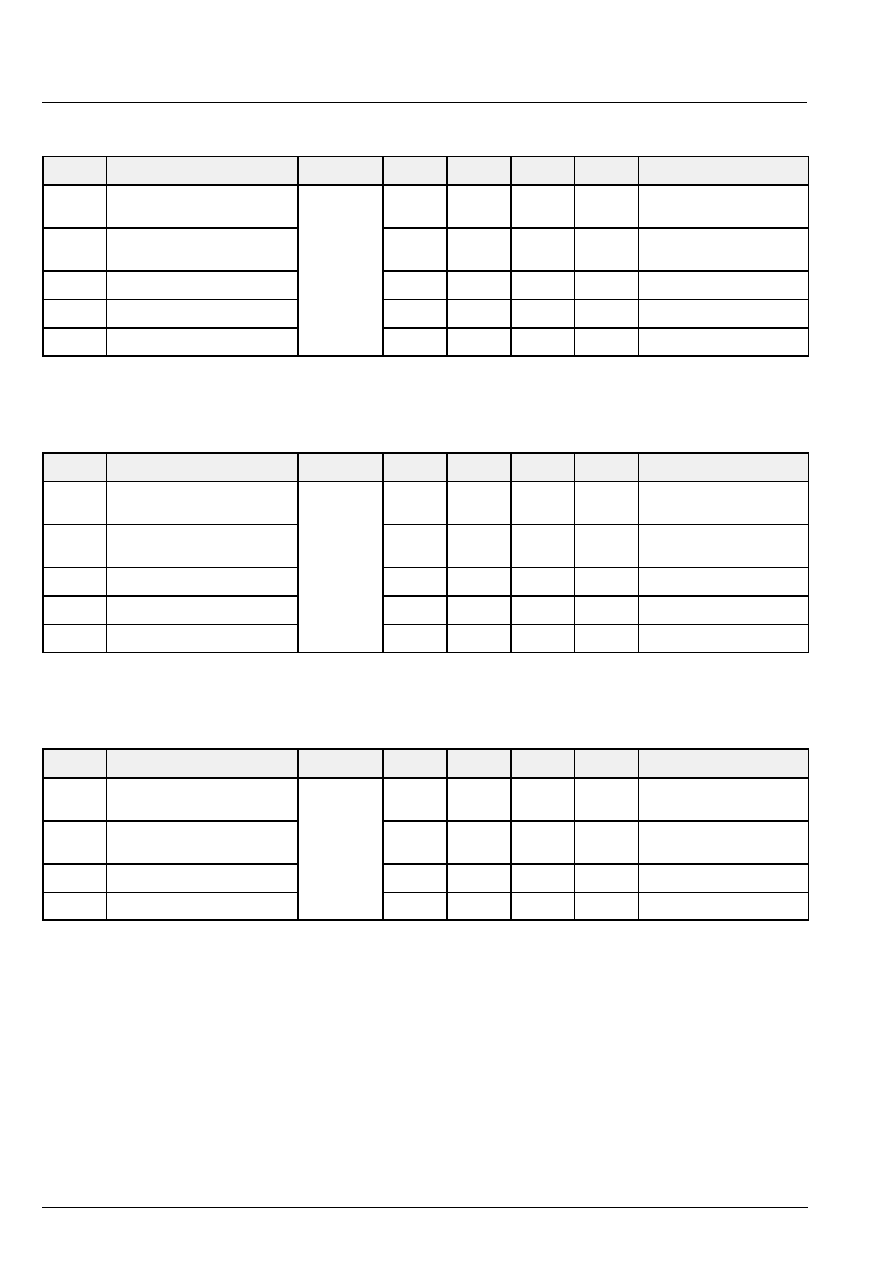
VDP 31xxB
PRELIMINARY DATA SHEET
60
Micronas
4.6.4.9. INTLC, Front Sync Output
Symbol
Parameter
Pin Name
Min.
Typ.
Max.
Unit
Test Conditions
V
OL
Output Low Voltage
INTLC
FSY
≠
0.2
0.4
V
I
OL
= 1.6 mA,
strength 6
V
OH
Output High Voltage
V
SUPD
≠ 0.4
≠
V
SUPD
V
≠I
OL
= 1.6mA,
strength 6
t
OH
Output Hold Time
6
14
ns
C
LOAD
= 70pF
t
OD
Output Delay Time
≠
≠
35
ns
C
LOAD
= 70pF
I
OL
Output Current
≠10
≠
10
mA
driver imp. = 0
4.6.4.10. Main Sync Output
Symbol
Parameter
Pin Name
Min.
Typ.
Max.
Unit
Test Conditions
V
OL
Output Low Voltage
MSY
≠
0.2
0.4
V
I
OL
= 1.6 mA,
strength 6
V
OH
Output High Voltage
V
SUPD
≠ 0.4
≠
V
SUPD
V
≠I
OL
= 1.6mA,
strength 6
t
OH
Output Hold Time
6
14
ns
C
LOAD
= 70pF
t
OD
Output Delay Time
≠
≠
35
ns
C
LOAD
= 70pF
I
OL
Output Current
≠10
≠
10
mA
driver imp. = 0
4.6.4.11. Combined Sync Output
Symbol
Parameter
Pin Name
Min.
Typ.
Max.
Unit
Test Conditions
V
OL
Output Low Voltage
CSY
≠
≠
0.4
V
I
OL
= 1.6 mA
strength 6
V
OH
Output High Voltage
V
SUPD
≠ 0.4
≠
V
SUPD
V
≠I
OL
= 1.6 mA
strength 6
t
OT
Output Transition Time
≠
10
20
ns
C
LOAD
= 30 pF
I
OL
Output Current
≠10
≠
10
mA
driver imp. = 0

PRELIMINARY DATA SHEET
VDP 31xxB
61
Micronas
4.6.4.12. Horizontal Flyback Input
Symbol
Parameter
Pin Name
Min.
Typ.
Max.
Unit
Test Conditions
V
IL
Input Low Voltage
HFLB
≠
≠
1.8
V
V
IH
Input High Voltage
2.6
≠
≠
V
V
IHST
Input Hysteresis
0.1
≠
≠
V
PSRR
HF
Power Supply Rejection Ratio of
Trigger Level
0
dB
f = 20 MHz
PSRR
MF
Power Supply Rejection Ratio of
Trigger Level
≠20
dB
f < 15 kHz
PSRR
LF
Power Supply Rejection Ratio of
Trigger Level
≠40
dB
f < 100 Hz
t
PID
Internal Delay
12
ns
slew rate 500 mV/ns
swing 1 V
PP
4.6.4.13. Horizontal Drive Output
Symbol
Parameter
Pin Name
Min.
Typ.
Max.
Unit
Test Conditions
V
OL
Output Low Voltage
HOUT
≠
≠
0.4
V
I
OL
= 10 mA
V
OH
Output High Voltage
(Open Drain Stage)
≠
≠
5
V
external pull-up resistor
t
OF
Output Fall Time
≠
8
20
ns
C
LOAD
= 30pF
I
OL
Output Low Current
≠
≠
10
mA
4.6.4.14. Vertical Protection Input
Symbol
Parameter
Pin Name
Min.
Typ.
Max.
Unit
Test Conditions
V
IL
Input Low Voltage
VPROT
≠
≠
1.8
V
V
IH
Input High Voltage
2.6
≠
≠
V
V
IHST
Input Hysteresis
0.1
≠
≠
V
4.6.4.15. Vertical Safety Input
Symbol
Parameter
Pin Name
Min.
Typ.
Max.
Unit
Test Conditions
V
ILA
Input Low Voltage A
SAFETY
≠
≠
1.8
V
V
IHA
Input High Voltage A
2.6
≠
≠
V
V
ILB
Input Low Voltage B
≠
≠
3.1
V
V
IHB
Input High Voltage B
3.9
≠
≠
V
V
IHST
Input Hysteresis A and B
0.1
≠
≠
V
t
PID
Internal Delay
100
ns
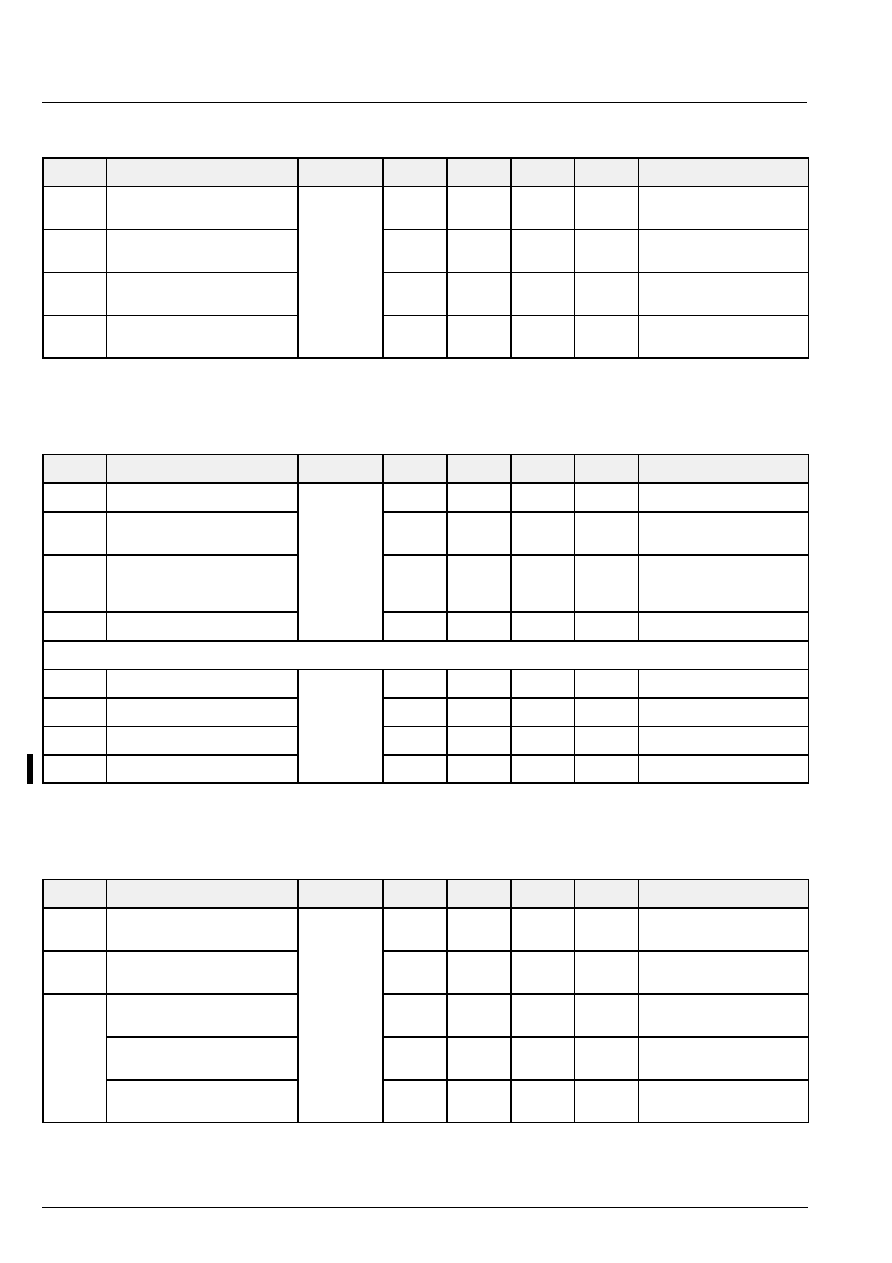
VDP 31xxB
PRELIMINARY DATA SHEET
62
Micronas
4.6.4.16. Vertical and East
/
West Drive Output
Symbol
Parameter
Pin Name
Min.
Typ.
Max.
Unit
Test Conditions
V
OL
Output Voltage LOW
EW
VERT
0
V
R
load
= 6800
R
xref
= 10 k
W
V
OH
Output Voltage HIGH
2.82
3
3.2
V
R
load
= 6800
R
xref
= 10 k
W
I
dacn
Full scale DAC Output
Current
415
440
465
µ
A
Vo = 0 V
R
xref
= 10 k
W
PSRR
Power Supply Rejection
Ratio
20
≠
≠
dB
4.6.4.17. Sense A/D Converter Input
Symbol
Parameter
Pin Name
Min.
Typ.
Max.
Unit
Test Conditions
V
I
Input Voltage Range
SENSE
0
≠
V
sup
V
V
I255
Input Voltage for code 255
1.4
1.54
1.7
V
Read cutoff blue
register
C
0
Digital Output for zero Input
16
LSB
Offset check,
read cutoff blue
register
R
I
Input Impedance
1
≠
≠
M
W
Range Switch Outputs
R
ON
Output On Resistance
RSW1
RSW2
≠
≠
50
W
I
OL
= 10 mA
I
Max
Maximum Current
RSW2
≠
≠
15
mA
I
LEAK
Leakage Current
≠
≠
600
nA
RSW High Impedance
C
IN
Input Capacitance
≠
≠
4
pF
4.6.4.18. Analog RGB and FB Inputs (continued on next page)
Symbol
Parameter
Pin Name
Min.
Typ.
Max.
Unit
Test Conditions
V
RGBIN
External RGB Inputs Voltage
Range
RIN
GIN
BIN
≠0.3
≠
1.1
V
V
RGBIN
nominal RGB Input Voltage
peak-to-peak
BIN
RIN2
GIN2
BIN2
0.5
0.7
1.0
V
PP
SCART Spec: 0.7 V
±
3 dB
V
RGBIN
RGB Inputs Voltage for Maxi-
mum Output Current
BIN2
0.44
Contrast setting: 511
RGB Inputs Voltage for Maxi-
mum Output Current
0.7
Contrast setting: 323
RGB Inputs Voltage for Maxi-
mum Output Current
1.1
Contrast setting: 204

PRELIMINARY DATA SHEET
VDP 31xxB
63
Micronas
Analog RGB and FB Inputs, continued
Symbol
Parameter
Pin Name
Min.
Typ.
Max.
Unit
Test Conditions
C
RGBIN
External RGB Input Coupling
Capacitor
RIN
GIN
BIN
15
nF
Clamp Pulse Width
BIN
RIN2
GIN2
3.1
µ
s
C
IN
Input Capacitance
GIN2
BIN2
≠
≠
13
pF
I
IL
Input Leakage Current
≠0.5
≠
0.5
m
A
Clamping OFF,
V
IN
≠0.3..3 V
V
CLIP
RGB Input Voltage for
Clipping Current
2
V
V
CLAMP
Clamp Level at Input
40
60
80
mV
Clamping ON
V
INOFF
Offset Level at Input
≠10
10
mV
Extrapolated from
V
IN
=
100 mV
and 200 mV
V
INOFF
Offset Level Match at Input
≠10
10
mV
Extrapolated from
V
IN
=
100 mV and 200 mV
R
CLAMP
Clamping-ON-Resistance
140
≠
V
FBLOFF
FBLIN Low Level
FBLIN
FBLIN2
≠
≠
0.5
V
V
FBLON
FBLIN High Level
FBLIN2
0.9
≠
≠
V
V
FBLTRIG
Fast Blanking Trigger
Level typical
0.7
t
PID
Delay Fast Blanking to RGB
OUT
from midst of FBLIN-transition
to 90% of RGB
OUT
-transition
8
15
ns
Internal RGB = 3.75 mA Full
Scale
Int. Brightness = 0
External Brightness =
1.5 mA (Full Scale)
RGBin = 0
V
FBLOFF
= 0.4 V
V
FBLON
= 1.0 V
Rise and fall time = 2 ns
Difference of Internal Delay to
External RGBin Delay
≠5
+5
ns
Switch-Over-Glitch
0.5
pAs
Switch from 3.75 mA (int) to
1.5 mA (ext)
4.6.4.19. Half Contrast Switch Input
Symbol
Parameter
Pin Name
Min.
Typ.
Max.
Unit
Test Conditions
V
IL
Input Low Voltage
HCS
≠
≠
0.8
V
V
IH
Input High Voltage
1.5
≠
≠
V
t
HCS
Delay HCS to RGB
OUT
from 50% of HCS-transition
to 90% of RGB
OUT
-transition
80
120
ns
Internal RGB = 3.75 mA
V
HCSL
= 0.4 V
V
HCSH
= 1.0 V
Rise and fall time = 2 ns

VDP 31xxB
PRELIMINARY DATA SHEET
64
Micronas
4.6.4.20. Analog RGB Outputs, D/A Converters
Symbol
Parameter
Pin Name
Min.
Typ.
Max.
Unit
Test Conditions
Internal RGB Signal D/A Converter Characteristics
Resolution
ROUT
GOUT
≠
10
≠
bit
I
OUT
Full Scale Output Current
GOUT
BOUT
3.6
3.75
3.9
mA
R
ref
= 10 k
I
OUTHC
Half Contrast Output Current
1.74
1.87
2.0
mA
R
ref
= 10 k
,
I
OUT
= 3.75 mA
Differential Nonlinearity
0.5
LSB
Integral Nonlinearity
1
LSB
Glitch Pulse Charge
0.5
pAs
Ramp signal, 25
output ter-
mination
t
T
Rise and Fall Time
3
ns
10% to 90%, 90% to 10%
t
RHC
Half Contrast Rise Time
50
75
ns
60% to 90% I
OUT
= 3.75mA
t
FHC
Half Contrast Fall Time
25
40
ns
90% to 60% I
OUT
= 3.75mA
Intermodulation
≠50
dB
2/2.5 MHz full scale
Signal to Noise
+50
dB
Signal: 1MHz full scale
Bandwidth: 10MHz
D
RGB
Matching R≠G, R≠B, G≠B
≠2
2
%
D
RGBHC
Half Contrast Matching
R≠G, R≠B, G≠B
≠5
5
%
R/B/G Crosstalk
one channel talks
two channels talk
≠46
dB
Passive channel:
I
OUT
=1.88 mA
Crosstalk-Signal: 1.25 MHz,
3 75 mA
PP
RGB Input Crosstalk from
external RGB
one channel talks
two channels talk
three channels talk
≠50
≠50
≠50
dB
dB
dB
3.75 mA
PP
Internal RGB Brightness D/A Converter Characteristics
Resolution
ROUT
GOUT
9
bits
I
BR
Full Scale Output Current
relative
GOUT
BOUT
39.2
40
40.8
%
Ref to max. digital RGB
I
BR
Full Scale Output Current
absolute
1.5
mA
I
BR
differential nonlinearity
0.5
LSB
I
BR
integral nonlinearity
1
LSB
I
BR
Match R≠G, R≠B, G≠B
≠2
2
%
I
BR
Match to digital RGB
R≠R, G≠G, B≠B
≠2
2
%
External RGB Voltage/Current Converter Characteristics
Resolution
ROUT
GOUT
9
bits
I
EXOUT
Full Scale Output Current
relative
GOUT
BOUT
96
100
104
%
Ref. to max. Digital RGB
V
IN
= 0.7 V
PP
, contrast = 323
Full Scale Output Current
absolute
3.75
mA
Same as Digital RGB
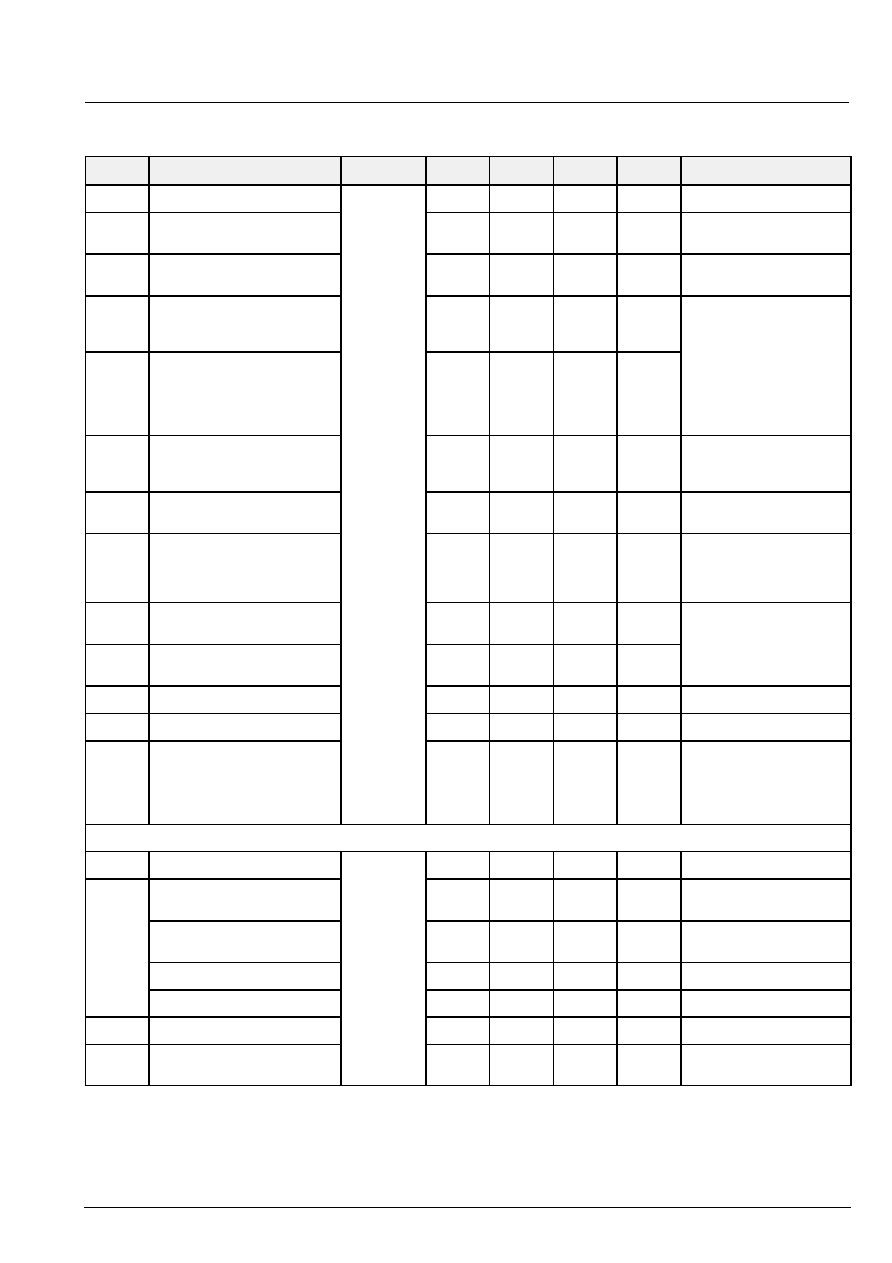
PRELIMINARY DATA SHEET
VDP 31xxB
65
Micronas
Analog RGB Outputs, D/A Converters, continued
Symbol
Parameter
Pin Name
Min.
Typ.
Max.
Unit
Test Conditions
CR
Contrast Adjust Range
ROUT
GOUT
16:511
Gain Match R≠G, R≠B, G≠B
GOUT
BOUT
≠2
2
%
Measured at RGB Outputs
V
IN
= 0.7 V, contrast = 323
Gain Match to RGB≠DACs
R≠R, G≠G, B≠B
≠3
3
%
Measured at RGB Outputs
V
IN
= 0.7 V, contrast = 323
R/B/G Input Crosstalk
one channel talks
two channels talk
≠46
dB
Passive channel:
V
IN
= 0.7V,
contrast = 323
RGB Input Crosstalk from
Internal RGB
one channel talks
two channels talk
three channels talk
≠50
dB
Crosstalk signal: 1.25 MHz,
3.75 mA
PP
RGB Input Noise and
Distortion
≠50
dB
V
IN
= 0.7 V
PP
at 1 MHz
contrast = 323
Bandwidth: 10 MHz
RGB Input Bandwidth ≠3dB
10
15
≠
MHz
V
IN
= 0.7 V
PP
,
contrast = 323
RGB Input THD
≠50
≠40
dB
dB
Input signal 1 MHz
Input signal 6 MHz
V
IN
= 0.7 V
PP
contrast = 323
Differential Nonlinearity of
Contrast Adjust
1.0
LSB
V
IN
= 0.44 V
Integral nonlinearity of
Contrast Adjust
7
LSB
V
RGBO
RGB Output Voltage
≠1.0
0.3
V
Referred to V
SUPO
RGB Output Load Resistance
100
Ref. to V
SUPO
V
OUTC
RGB Output Compliance
≠1.5
≠1.3
≠1.2
V
Ref. to V
SUPO
Sum of max. Current of
RGB≠DACs and max. Cur-
rent of Int. Brightness DACs
is 2% degraded
External RGB Brightness D/A Converter Characteristics
Resolution
ROUT
GOUT
9
bits
I
EXBR
Full Scale Output Current
relative
GOUT
BOUT
39.2
40
40.8
%
Ref to max. digital RGB
Full Scale Output Current
absolute
1.5
mA
Differential Nonlinearity
0.5
LSB
Integral Nonlinearity
1
LSB
Matching R≠G, R≠B, G≠B
≠2
2
%
Matching to digital RGB
R≠R, G≠G, B≠B
≠2
2
%
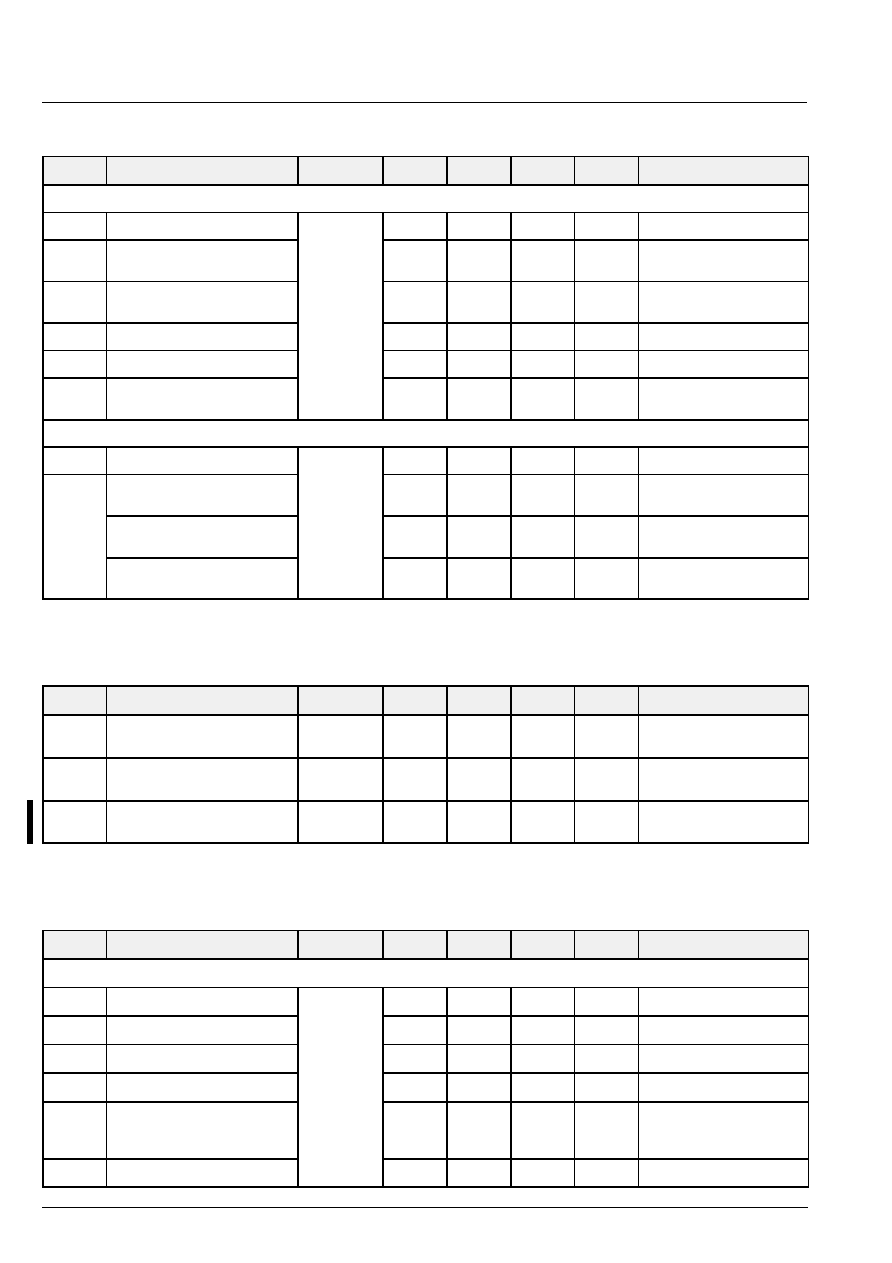
VDP 31xxB
PRELIMINARY DATA SHEET
66
Micronas
Analog RGB Outputs, D/A Converters, continued
Symbol
Parameter
Pin Name
Min.
Typ.
Max.
Unit
Test Conditions
RGB Output Cutoff D/A Converter Characteristics
Resolution
ROUT
GOUT
9
bits
I
CUT
Full Scale Output Current
relative
GOUT
BOUT
58.8
60
61.2
%
Ref to max. digital RGB
I
CUT
Full Scale Output Current
absolute
2.25
mA
I
CUT
Differential nonlinearity
0.5
LSB
I
CUT
Integral nonlinearity
1
LSB
I
CUT
Match to digital RGB
R≠R, G≠G, B≠B
≠2
2
%
RGB Output Ultrablack D/A Converter Characteristics
Resolution
ROUT
GOUT
1
bits
I
UB
Full Scale Output Current
relative
GOUT
BOUT
19.6
20
20.4
%
Ref to max. digital RGB
Full Scale Output Current
absolute
0.75
mA
Match to digital RGB
R≠R, G≠G, B≠B
*
2
2
%
4.6.4.21. DAC Reference, Beam Current Safety
Symbol
Parameter
Pin Name
Min.
Typ.
Max.
Unit
Test Conditions
V
DACREF
DAC-Reference Voltage
VRD/BCS
2.38
2.50
2.67
V
DAC-Reference Output
resistance
VRD/BCS
18
25
32
k
W
V
XREF
DAC-Reference Voltage
Bias Current Generation
XREF
2.25
2.34
2.43
V
R
ref
= 10 k
,
4.6.4.22. Scan Velocity Modulation Output
Symbol
Parameter
Pin Name
Min.
Typ.
Max.
Unit
Test Conditions
SVM D/A Converter Characteristics
Resolution
SVMOUT
8
bit
I
OUT
Full Scale Output Current
1.55
1.875
2.25
mA
I
OUT
Differential Nonlinearity
0.5
LSB
I
OUT
Integral Nonlinearity
1
LSB
I
OUT
Glitch Pulse Charge
0.5
pAs
Ramp, output line is
terminated on both ends with
50 Ohms
I
OUT
Rise and Fall Time
3
nsec
10% to 90%, 90% to 10%

PRELIMINARY DATA SHEET
VDP 31xxB
67
Micronas
5. Application Circuit

VDP 31xxB
PRELIMINARY DATA SHEET
68
Micronas

PRELIMINARY DATA SHEET
VDP 31xxB
69
Micronas

VDP 31xxB
PRELIMINARY DATA SHEET
70
Micronas

PRELIMINARY DATA SHEET
VDP 31xxB
71
Micronas

VDP 31xxB
PRELIMINARY DATA SHEET
72
Micronas
6. Data Sheet History
1. Preliminary data sheet: "VDP 31xxB Video Proces-
sor Family", Edition May 15, 1997, 6251-437-1PD.
First release of the preliminary data sheet.
2. Preliminary data sheet: "VDP 31xxB Video Proces-
sor Family", Edition Sept. 25, 1998, 6251-437-2PD.
Second release of the preliminary data sheet.
Major changes:
≠ section 4.1.: package outline dimensions changed
≠ section 4.6.: missing values have been defined
≠ section 5.: application circuit diagram corrected
Micronas GmbH
Hans-Bunte-Strasse 19
D-79108 Freiburg (Germany)
P.O. Box 840
D-79008 Freiburg (Germany)
Tel. +49-761-517-0
Fax +49-761-517-2174
E-mail: docservice@micronas.com
Internet: www.micronas.com
Printed in Germany
Order No. 6251-437-2PD
All information and data contained in this data sheet are without any
commitment, are not to be considered as an offer for conclusion of a
contract, nor shall they be construed as to create any liability. Any new
issue of this data sheet invalidates previous issues. Product availability
and delivery are exclusively subject to our respective order confirma-
tion form; the same applies to orders based on development samples
delivered. By this publication, Micronas GmbH does not assume re-
sponsibility for patent infringements or other rights of third parties
which may result from its use.
Further, Micronas GmbH reserves the right to revise this publication
and to make changes to its content, at any time, without obligation to
notify any person or entity of such revisions or changes.
No part of this publication may be reproduced, photocopied, stored on
a retrieval system, or transmitted without the express written consent
of Micronas GmbH.







































































